A DESTINATION MANAGEMENT PLAN FOR CUMBRIA: 2024 TO 2030



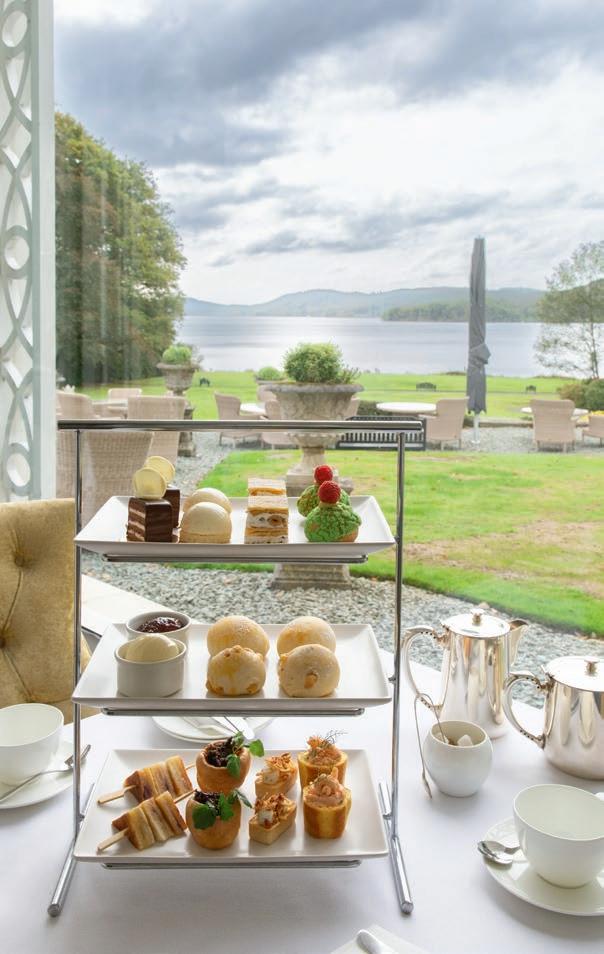




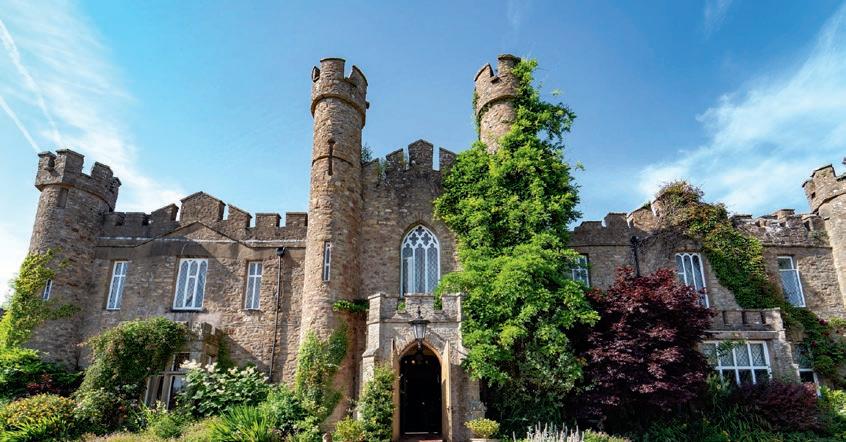
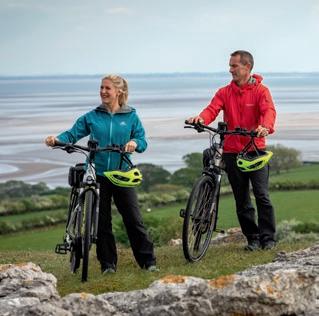
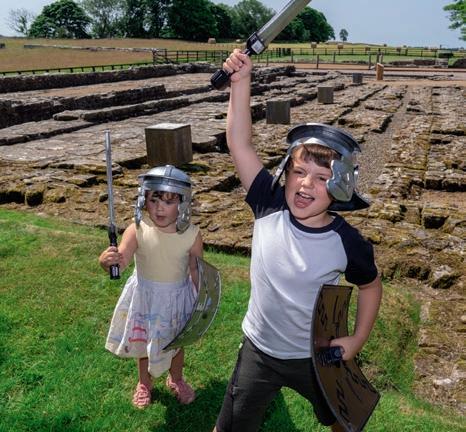
cumbriatourism.org/dmp
Front cover image credits:
Brockhole-on-Windermere, Langdale Chase, Storrs Hall and visitlakedistrict.com
Plan images: unless credited separately, all images are copyright visitlakedistrict.com
2
A DESTINATION MANAGEMENT PLAN FOR CUMBRIA: 2024 TO 2030
This Destination Management Plan for Cumbria has been led by Cumbria Tourism in consultation with the following partners:
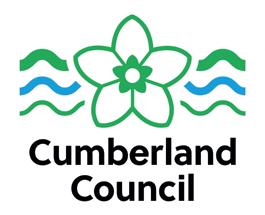

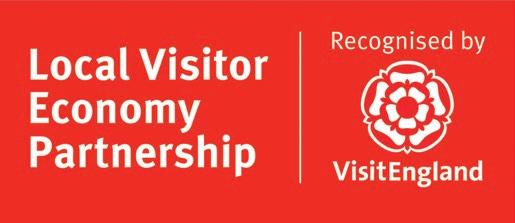

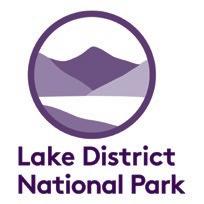
3
CONTENTS EXECUTIVE SUMMARY...................................................................................................................... 5 OUR VISION 7 PRINCIPLES OF THE DMP 8 THE ROLE OF THE VISITOR ECONOMY IN CUMBRIA 9 KEY OBJECTIVES AND INTENDED OUTCOMES 11 1 INTRODUCTION AND BACKGROUND 22 1.1 WHAT IS A DMP? 23 1.2 OUR DESTINATION 23 1.3 HOW IT HAS BEEN DEVELOPED 23 1.4 STRATEGIC ALIGNMENT OF THE DMP 23 2 HOW CUMBRIA IS PERFORMING ...............................................................................................24 2.1 KEY MESSAGES 25 2.2 SWOT ANALYSIS 28 3 VISION AND OBJECTIVES 30 3.1 OUR VISION 31 3.2 KEY OBJECTIVES FOR THE DMP 31 3.3 OBJECTIVE - INCREASING THE VALUE AND PRODUCTIVITY OF THE VISITOR ECONOMY 32 3.4 OBJECTIVE - RESPONSIBLE & SUSTAINABLE 37 3.5 OBJECTIVE - INCLUSIVE & ACCESSIBLE 40 3.6 OBJECTIVE - RESOURCED TO DELIVER 41 4 AMBITIONS AND OUTCOMES ....................................................................................................43 4.1 OBJECTIVE – DRIVE ECONOMIC GROWTH, INCREASING THE VALUE AND PRODUCTIVITY OF CUMBRIA’S VISITOR ECONOMY ...................................................................45 4.2 OBJECTIVE – ENSURE A SUSTAINABLE & RESPONSIBLE VISITOR DESTINATION 46 4.3 OBJECTIVE – ENSURING AN INCLUSIVE & ACCESSIBLE VISITOR DESTINATION ........................ 48 4.4 OBJECTIVE – SUPPORTING THE SECTOR TO DELIVER WORLD CLASS EXPERIENCES 49 5 OUR PLAN OF ACTION ............................................................................................................... 51 6 MANAGING AND MONITORING THE DMP 68 7 APPENDIX A – STRATEGIC ALIGNMENT ..................................................................................... 70 8 APPENDIX B – REVIEW OF THE EVIDENCE 73 8.1 IMPORTANCE OF THE VISITOR ECONOMY ................................................................................. 74 8.2 OUR VISITORS 79 8.3 WHERE VISITORS GO AND WHY THEY COME HERE .................................................................. 83 8.4 ACCOMMODATION 92 8.5 TRANSPORT AND DIGITAL .......................................................................................................... 93 8.6 OUR BUSINESSES AND PEOPLE 98 8.7 PLANNED INVESTMENT AND CHANGES .................................................................................... 99 8.8 KEY EXTERNAL TRENDS ............................................................................................................ 101 A DESTINATION MANAGEMENT PLAN FOR CUMBRIA: 2024 TO 2030 4

Cumbria is a top UK visitor destination and place of national and international appeal. It is home to two UNESCO World Heritage Sites (the English Lake District and Hadrian’s Wall), two National Parks (The Lake District and the Yorkshire Dales) and three National Landscapes (Silverdale & Arnside, the Solway Coast and the North Pennines, which is also designated as an UNESCO Global Geopark).
Through this shared Destination Management Plan (DMP), public and private sector partners are seeking to ensure a joined-up approach to support a successful visitor economy for the whole of the county, supporting economic growth, supporting the natural environment and delivering benefits for our host communities. The DMP seeks to ensure a balance between the economic benefits from a successful visitor economy and the need to support the environment and communities of Cumbria.
5 A DESTINATION MANAGEMENT PLAN FOR CUMBRIA: 2024 TO 2030
Catbells overlooking Derwentwater

A DESTINATION MANAGEMENT PLAN FOR CUMBRIA: 2024 TO 2030 6
Birdoswald Roman Fort, Hadrian’s Wall

Famed for our world-class landscapes and culture - by 2040 Cumbria will be Britain’s most vibrant and sustainable rural destination, boasting a reputation for quality, welcome, and an adventure for everyone - bringing benefits for our visitors, economy, nature and communities.
7 A DESTINATION MANAGEMENT PLAN FOR CUMBRIA: 2024 TO 2030
OUR VISION
The vision is long-term and will take �me to achieve. The key objec�ves and summary ac�ons for the next 6 years in this DMP (set out below) will move Cumbria towards the long-term vision. The plan will be monitored by a Steering Group1, with regular reviews of progress.
The DMP is ambi�ous and will require very strong partnership working and the ac�ve engagement of a wide range of partners across the public and private sector.
PRINCIPLES OF THE DMP
To support the DMP, all partners support and uphold the following principles:
3 1 2 4
Sustainable tourism will be at the heart of everything we do2 .
Our ac�ons will be evidence based, inclusive and equitable, respec�ul and suppor�ve of our communi�es and of benefit to visitors.
Collabora�ve and solu�ons focussed.
A commitment to maximising our collec�ve resources and exper�se and avoiding duplica�on.

1 Current membership includes: Cumbria Tourism (CT), Cumberland Council, Westmorland and Furness Council, Cumbria Local Economy Partnership (CLEP), the Lake District Na�onal Park Authority (LDNPA), the Yorkshire Dales Na�onal Park Authority (YDNPA), a Hadrian’s Wall representa�ve and CT Board representa�ves from the private sector.
2 Sustainable tourism is defined by the UN Environment Programme and UN World Tourism Organisa�on as “tourism that takes full account of its current and future economic, social and environmental impacts, addressing the needs of visitors, the industry, the environment and host communities”. This DMP uses the term sustainability in this broad sense.
A DESTINATION MANAGEMENT PLAN FOR CUMBRIA: 2024 TO 2030 8
Cross Bay Walk, Morecambe Bay
THE ROLE OF THE VISITOR ECONOMY IN CUMBRIA
Cumbria has a large and important visitor economy. In 2022, the 41 million visitors in Cumbria generated around £4.1 billion of total spend in the economy including mul�plier effects. This supports £1.2 billion in direct gross value added (GVA) and overall, an es�mated 34,300 jobs directly (FTEs). Taking account of supply chain and mul�pliers, Cumbria’s visitor economy spend supports an es�mated 43,600 FTE jobs (19% of the county total) and around £1.6 billion in GVA (13% of Cumbria’s total). Throughout this DMP when we refer to visitors, this encompasses residents of Cumbria3, those visi�ng friends and rela�ves, those on business and other visitors from the United Kingdom and abroad. Improving the visitor experience will benefit all types of visitors.
As well as providing employment and being of economic importance, the visitor economy has a wider and significant role to play in suppor�ng vibrant communi�es through place shaping. That includes suppor�ng local authority priori�es; providing social and community benefits and pride; driving regenera�on; crea�ng jobs; suppor�ng public transport; underpinning a resilient supply chain; cultural, arts and heritage assets; and changing percep�ons.

9 A DESTINATION MANAGEMENT PLAN FOR CUMBRIA: 2024 TO 2030
3 In 2022 around a fi�h of visitors were residents of Cumbria and a further 12% were visi�ng friends and rela�ves here. Source: Cumbria Visitor Survey 2022.
Patterdale, Ullswater Valley
©Lake District National Park Authority
Changes and boosts prospects and places
Creates pride in places
Source: CT analysis and data drawn from Appendix B (see full Destination Management Plan)
Improves accessibility and inclusivity
Visitors spent £0.8 bn on food and drink and £0.5 bn in shops in Cumbria in 2022
Creates wealth and jobs
Support 43,600 FTE jobs (19% of total) and around £1.6 bn in GVA (13% of total)
THE VISITOR ECONOMY EFFECT IN CUMBRIA
Increases the appeal of Cumbria to live, work, study and invest
Helps sustain railway and bus usage and so routes
Supports a resilient supply chain
Drives inward investment
Encourages private investment
Reinforces cultural, heritage, retail and community assets
Supports sustainable transport infrastructure and active travel
Improves health and wellbeing of communities and the nation
Although the visitor economy brings the benefits outlined, it is also recognised as one of the poten�al contributors to pressures on housing, infrastructure and the environment in some parts of Cumbria. The purpose of the DMP is to enable partners to work together to mi�gate these impacts and maximise the benefits for all.
A DESTINATION MANAGEMENT PLAN FOR CUMBRIA: 2024 TO 2030 10
Figure 1: Wider value and role of the visitor economy in Cumbria
KEY OBJECTIVES AND INTENDED OUTCOMES
The DMP has four key objec�ves, all of which are equally important and to a large degree interlinked. For each, there are a series of ambi�ons which partners will measure progress against. These are focused on achieving change by 2030, the key staging post towards the 2040 vision.
OBJECTIVE – DRIVE ECONOMIC GROWTH: INCREASING THE VALUE AND PRODUCTIVITY OF CUMBRIA’S VISITOR ECONOMY
This objec�ve is about growing the value of the visitor economy to deliver economic and social benefits by a�rac�ng visitors to stay longer, visit less well-known parts of the county4 and increase visits out of season. In doing so, this will support growth where it is needed and appropriate.
The aim of the DMP is to grow visitor value - including spreading visitors both geographically and over the course of the year - and encouraging visitors to stay longer, thereby reducing the pressures that visitor volumes can bring to certain loca�ons at key �mes and the impacts on Cumbria’s communi�es and residents.
Ambition: Grow the value of the visitor economy by 2030 up to a third in real terms, by:
3 1 2 4
Increasing the value and share of tourism spend across the less visited parts of Cumbria (both day and overnight visitors) to increase the share of visitor spend outside the LDNP area from 47% in 2022 to 54%. Growth poten�al of circa. £500 million in total spend effects.
Increasing the value of tourism revenue outside the core period (April to September) and in shoulder months by circa. 10%, bringing seasonality more in line with the na�onal average. Growth poten�al of circa. £230 million in total spend effects.
Increasing the contribu�on of overnight visitors (through total visits and visitor days) by increasing the number and length of stays. Increase share from 43% in 2022 to 47.5% or increase average stay from 3.2 to 3.8 days. Growth poten�al of circa. £440 million in total spend effects.
Increasing the number and share of interna�onal visitors to reach 15% of total visitor numbers5.
4 These are explained in more detail in sec�on 3.3 of the full Des�na�on Management Plan.
5 Note: This is complementary to the overnight visitor outcome. The focus is on a�rac�ng more interna�onal visitors who are coming to the UK anyway, so not increasing interna�onal air flights.
11 A DESTINATION MANAGEMENT PLAN FOR CUMBRIA: 2024 TO 2030
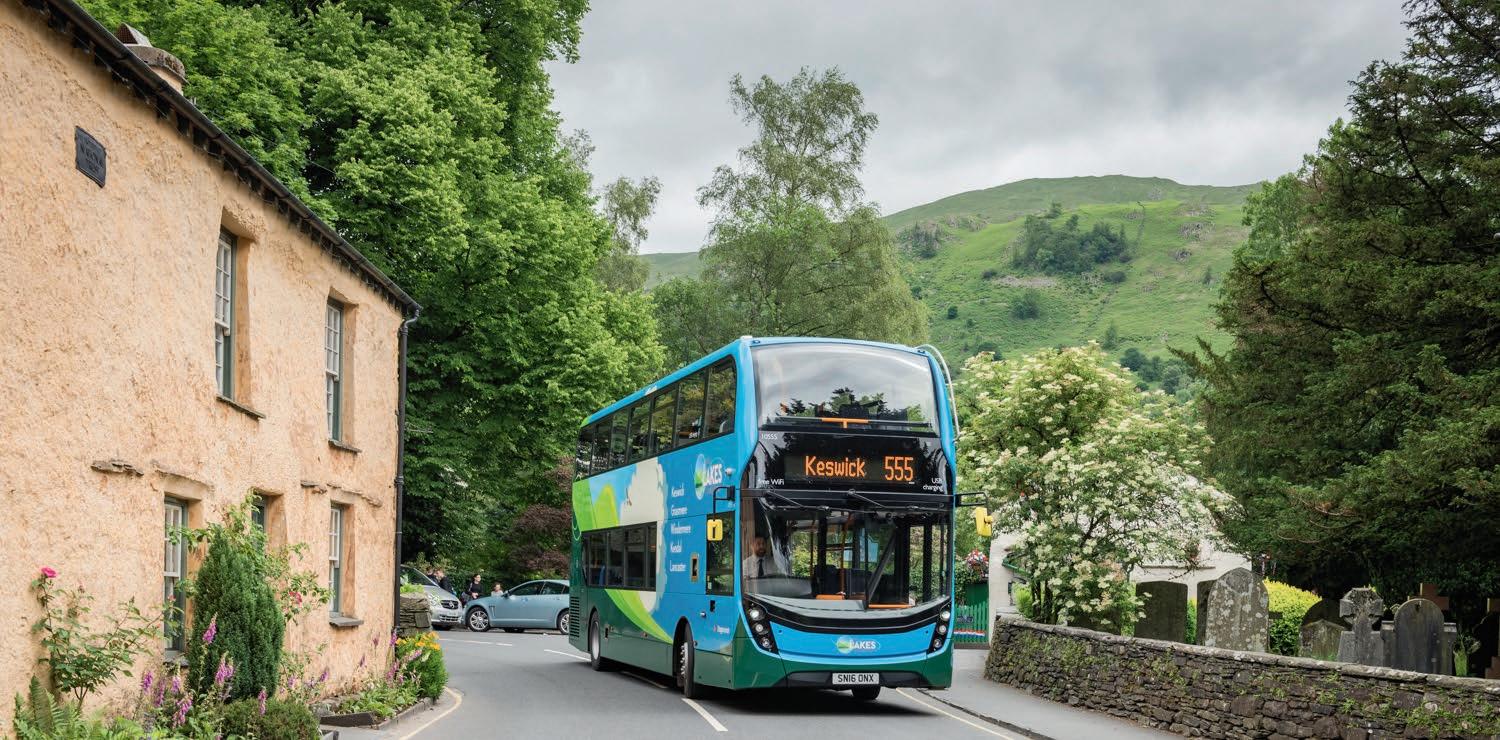

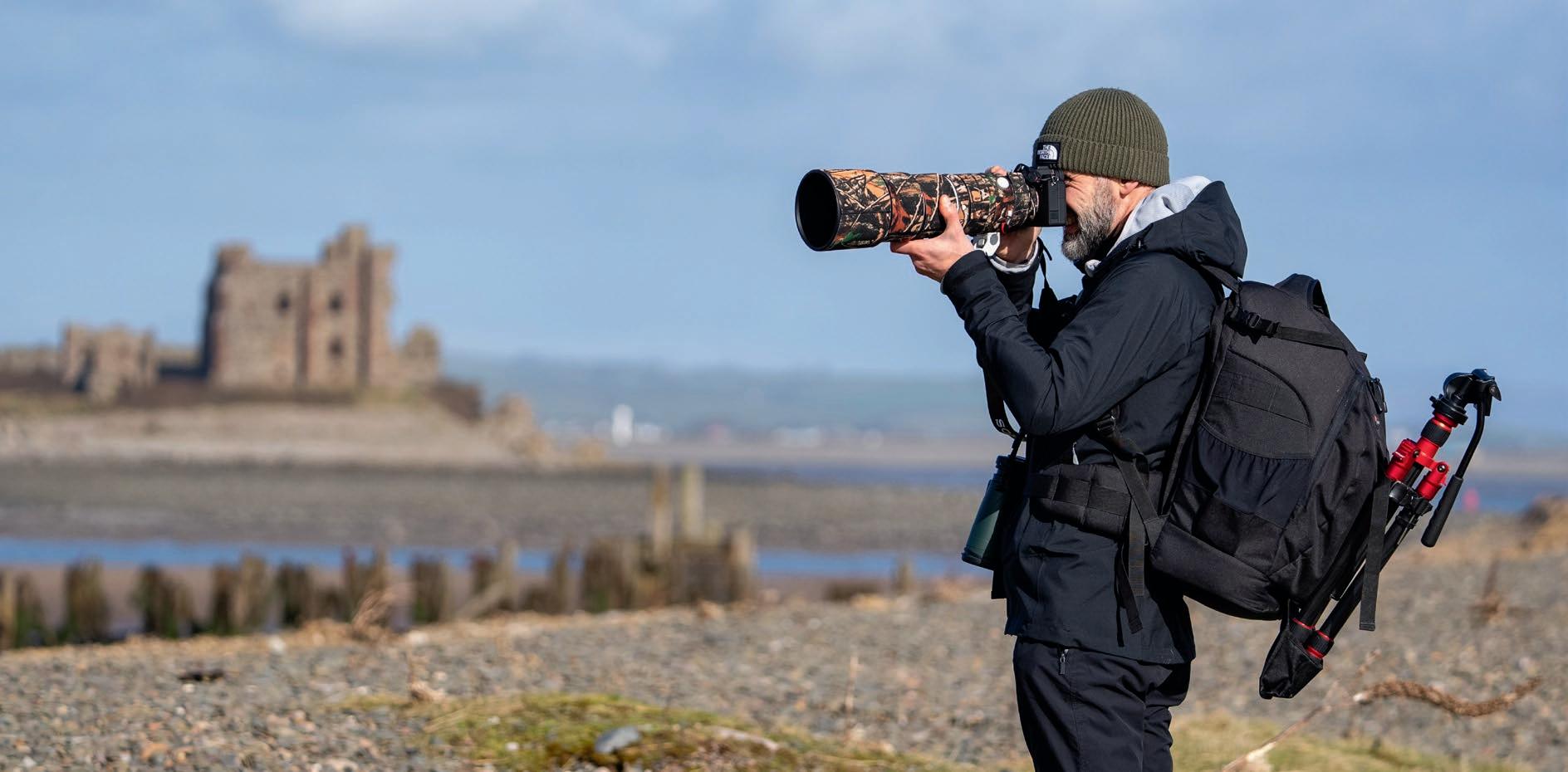
A DESTINATION MANAGEMENT PLAN FOR CUMBRIA: 2024 TO 2030 12
Carlisle Cathedral, Carlisle City of Lights
©Stuart Walker
South Walney Nature Reserve
Grasmere
©Stagecoach
OBJECTIVE – RESPONSIBLE AND SUSTAINABLE: SUPPORTING RESPONSIBLE TOURISM THAT BENEFITS THE ENVIRONMENT AND SUPPORTS VIBRANT COMMUNITIES
This objec�ve is about posi�oning Cumbria as a leading sustainable and responsible tourism6 des�na�on. This requires managing visitors as they journey to and within Cumbria to help improve visitor experience, reduce pressure on the environment and bring further benefits to host communi�es. It requires enabling low carbon experiences in ways which inspire, excite and a�ract. It is also about suppor�ng responsible rela�onships between visitors and the landscape, heritage and communi�es of Cumbria.
Much of Cumbria and many of its most visited places fall within important protected landscapesNa�onal Parks and Na�onal Landscapes (formerly Areas of Outstanding Natural Beauty or AONBs). In the case of the Lake District, its special quali�es7 contributed to the whole of the Na�onal Park being designated a World Heritage Site for its outstanding universal value as a Cultural Landscape. The special nature of Cumbria’s different landscape and environment are of course a key part of the appeal to many visitors. It is important they are celebrated, valued and maintained.
As well as carbon emissions, there are other environmental pressures in Cumbria created by our residents, by farming and other business ac�vity, and by visitors. Environmental challenges created by visitor economy ac�vity tend to be concentrated in certain loca�ons in Cumbria and can affect the environment and the landscape in ways that impact on the enjoyment of our environment for residents and visitors alike. The challenges created include water usage, water pollu�on, li�er/ waste, car parking and pressure on the visitor infrastructure (from toilets to footpaths).
As a globally leading environmentally responsible des�na�on, we need to con�nue to promote a culture of understanding of the area to the visitor and so encourage a philosophy of the valuing our natural capital (being the “loved des�na�on”) via responsible tourism ac�vity. This needs to go hand in glove with efforts by our visitor economy businesses to help educate visitors and make their own ac�vi�es as environmentally sustainable as possible. This applies both in the most popular des�na�ons in Cumbria and the under visited des�na�ons where there is the poten�al for growth.

Solway Coast National Landscape
6 Responsible tourism has a wider meaning than sustainable tourism and focuses on the economic and social impacts of tourism and the rela�onship between visitors and host communi�es as well as the environment.
7 See www.lakedistrict.gov.uk/caringfor/lake-district-special-quali�es There are 13 special quali�es which are: 1. A
landscape 2. Complex geology and geomorphology 3. Rich
13 A DESTINATION MANAGEMENT PLAN FOR CUMBRIA: 2024 TO 2030
world class cultural
archaeology and historic landscape 4. Unique farming heritage and concentra�on of common land 5. The high fells 6. Wealth of habitats and wildlife 7. Mosaic of lakes, tarns, rivers and coast 8. Extensive seminatural woodlands 9. Dis�nc�ve buildings and se�lement character 10. A source of ar�s�c inspira�on 11. A model for protec�ng cultural landscapes 12. A long tradi�on of tourism and outdoor ac�vi�es 13. Opportuni�es for quiet enjoyment.
Ambition: Improve the overall sustainability of visitor economy activity by: Transport8
Suppor�ng the aspira�on for Cumbria to be the first Net Zero carbon county by 2037, supported by a reduc�on in carbon from visitor travel of at least 15% on the 2018 baseline by 2030.
Improving the sustainability of travel in getting to Cumbria
Increasing the share of visitors arriving in Cumbria by bus/coach and train from 9% in 2022 to 15% by 2030.
For those arriving by private vehicle, suppor�ng a growth in the propor�on using EV/hybrid vehicles from 10% in 2022 to at least 20%. This reflects the need to ensure Cumbria’s visitor economy can cater for the forecasted growth in EV car ownership and usage and does not get le� behind.
Improving the sustainability of travel in getting around Cumbria
Encouraging and enabling the use of sustainable and ac�ve travel op�ons, and increasing the main mode of travel recorded as ac�ve and sustainable from its 28% in 2022 to 40%.
Other
6 5 3 1 2 4 8 7
Increasing responsible tourism ac�vity, which is managed and monitored through plans led by the Strategic Visitor Management Group (SVMG) and reflected in reduced visitor environmental impacts such as li�er, fly parking and fly camping.
Increasing the propor�on of supply chain spend supported by tourism retained in Cumbria.
Delivering increased vibrancy and vitality to Cumbria’s city (Carlisle), towns and village centres by enhancing the evening economy, cultural offering (measured by employment growth and food/drink offer in town) and sense of pride in place.
Increasing the value of visitor contribu�ons to local causes (volunteering and visitor giving).
A DESTINATION MANAGEMENT PLAN FOR CUMBRIA: 2024 TO 2030 14
8 These targets assume that the external opera�ng environment for travel, which partners in Cumbria cannot influence, is as partners expect and as forecast (e.g. UK-wide roll-out of EV cars, etc).
OBJECTIVE – INCLUSIVE AND ACCESSIBLE: ENSURING ALL VISITORS CAN ENJOY CUMBRIA AS A DESTINATION
Being an inclusive and accessible des�na�on means being a des�na�on that a�racts and caters for all types of visitors which can offer “adventure for everyone.” This requires suitable facili�es, movement infrastructure, signage, informa�on and promo�on.
Ambition: improve the overall inclusivity of visitor economy activity by:
2 1
Improving Cumbria’s reputa�on as an accessible des�na�on and growing the value of the economy from visitors with accessibility needs by delivering the Accessible Cumbria Partnership Strategy.
Working in partnership to increase Cumbria’s reputa�on as an inclusive des�na�on welcoming to people from all visitor groups and backgrounds.

15 A DESTINATION MANAGEMENT PLAN FOR CUMBRIA: 2024 TO 2030
West Windermere Way, Miles without Stiles
OBJECTIVE – RESOURCED TO DELIVER: SUPPORTING THE SECTOR AND ENSURING THE INFRASTRUCTURE TO DELIVER WORLD CLASS EXPERIENCES AND MEET THE NEEDS OF COMMUNITIES
It is not possible to deliver on the DMP’s previous objec�ves without a suppor�ng infrastructure that has the capability to deliver world class experiences and a “warm welcome for all.” This objec�ve is about suppor�ng the visitor economy sector to be resilient, to operate effec�vely and to support innova�on and produc�vity in the sector. It also addresses the opportuni�es and challenges in the delivery of services to visitors and the need to manage these in a way that offsets impact on our communi�es.
Ambition: Supporting the sector and the infrastructure needed by:
2 1
4 3
Implemen�ng the workforce strategy for the visitor economy to address the skills gap and workforce shortage and reduce by a half the number of visitor economy businesses repor�ng the recruitment of staff as a significant problem (was 48% in October 2023).
Addressing access to affordable housing and the housing mix for staff and reduce by a quarter the number of visitor economy businesses repor�ng this as a significant problem (was 66% in October 2023).
Increasing the number of visitor economy businesses ac�vely engaged in measures to improve environmental sustainability
A�rac�ng increased investment across Cumbria to develop 5G and other advanced wireless technologies with the aim of reducing ‘not-spots’ and building future-proof mobile connec�vity for visitors, businesses and residents, businesses and visitors.

A DESTINATION MANAGEMENT PLAN FOR CUMBRIA: 2024 TO 2030 16
BAHA, Bowness-on-Windermere
RESOURCING THE DMP
This DMP has a stretching set of objec�ves, priori�es and ambi�ons for Cumbria, with a comprehensive ac�on plan. The DMP will not be delivered without adequate resources from public and private sector partners collabora�ng together. The majority of ac�ons are already underway and being delivered from exis�ng budgets and plans or can be supported by partners working and sharing resources. However, there are some important ac�vi�es and proposed ac�ons that are not, as yet, resourced. The DMP will also help lever external funding from outside Cumbria.

17 A DESTINATION MANAGEMENT PLAN FOR CUMBRIA: 2024 TO 2030
Branthwaite Brow, Kendal
OBJECTIVE – DRIVE ECONOMIC GROWTH: INCREASING THE VALUE AND PRODUCTIVITY OF CUMBRIA’S VISITOR ECONOMY
OBJECTIVE – RESPONSIBLE & SUSTAINABLE: SUPPORTING
RESPONSIBLE TOURISM, BENEFITTING THE ENVIRONMENT AND VIBRANT COMMUNITIES
• 1A: Con�nue to implement strategy to raise appeal and awareness of less wellknown and visited parts of the county
• 1B: Grow the all-season offer and become known as a year-round des�na�on for all
• 1C: Regain and grow interna�onal spend and other higher value overnight stays
• 2A: Enhance and expand the opportuni�es and capabili�es for convenient, low carbon visitor movement and experience(s) both into and inside Cumbria for the benefit of visitors, residents and workers
• 2B: Promote and support sustainable and ac�ve travel and experiences
• 2C: Increase the local social and economic benefit from visitor spend, suppor�ng the vibrancy of our villages, towns and city
• 1D: Convert more visitors to overnight stays and extend the length of stays
• 1E: Adapt to and lead market trends and opportuni�es to ensure Cumbria a�racts future new and repeat visitors
• 2D: Encourage, educate and engage all visitors in responsible tourism, protec�ng and valuing our environment and communi�es
• 2E: Support ac�vi�es that sustain and enhance the environment
All requiring coordinated, evidence-led, targeted and appropriately funded marketing
• 2F: Ac�vely monitor and manage visitor pressure on key tourism des�na�ons
All requiring a coordinated approach to the strong use of data, evidence and intelligence gathering with a shared platform available to all to support joined up strategic visitor management
A DESTINATION MANAGEMENT PLAN FOR CUMBRIA: 2024 TO 2030 18
FIGURE 2: KEY OBJECTIVES & PRIORITY AREAS OF FOCUS, CUMBRIA DMP
OBJECTIVE – INCLUSIVE & ACCESSIBLE: ENSURING ALL VISITORS CAN ENJOY CUMBRIA AS A DESTINATION
• 3A: Ensure Cumbria’s infrastructure and welcome is accessible to all
OBJECTIVE – RESOURCED TO DELIVER: SUPPORTING THE SECTOR AND ENSURING THE INFRASTRUCTURE TO DELIVER WORLD CLASS EXPERIENCES AND MEET THE NEEDS OF COMMUNITIES
• 4A: Develop be�er infrastructure and a�ract investment in the quality and range of product
• 3B: Ensure Cumbria’s product and welcome is inclusive for all visitor groups
• 4B: A�ract, retain and develop a skilled and commi�ed workforce
• 4C: Support businesses to move to more environmentally sustainable opera�ons
• 4D: Support businesses to adapt, innovate and achieve excellence
• 4E: Ensure digital connec�vity (both mobile and fixed line) is fit for the future
• 4F: Ensure provision of adequate and consistent visitor services across Cumbria
• 4G: Ensure a joined-up approach to enable a resilient visitor economy
All requiring a coordinated approach to the strong use of data, evidence and intelligence gathering with a shared platform available to all to support joined up strategic visitor management
19 A DESTINATION MANAGEMENT PLAN FOR CUMBRIA: 2024 TO 2030
FIGURE 2: KEY OBJECTIVES & PRIORITY AREAS OF FOCUS, CUMBRIA DMP continued
FIGURE 3: KEY ACTIONS, CUMBRIA DMP
OBJECTIVE –DRIVE ECONOMIC GROWTH:
1.1: Invest in enhancing the quality of place in under visited loca�ons
1.2: Invest in enhancing the visitor product and experiences in under visited loca�ons
1.3: Funded and coordinated marke�ng and promo�on of under visited loca�ons
1.4: Support and extend programme of events and fes�vals outside peak periods and in less well visited parts
1.5: Iden�fy opportuni�es to develop more wet weather ac�vi�es and a�rac�ons to support tourism in off-peak periods
1.6: Funded and coordinated marke�ng and promo�on of Cumbria in off-peak periods
1.7: Funded and coordinated marke�ng and promo�on of Cumbria to interna�onal markets
1.8: Develop a strategic approach to promote Cumbria to film and TV produc�ons
1.9: Develop and implement a Cumbria food and drink strategy
1.10: Roll out a Cumbria motorhome strategy
1.11: Develop the CCR200 (Cumbrian Coastal Route) concept further
1.12: Increase local community awareness and use of and pride in visitor facing services
1.13: Research into new market opportuni�es
OBJECTIVE –RESPONSIBLE & SUSTAINABLE:
2.1: Enable more visitors to arrive in Cumbria via public transport
2.2: Market and promote visitor travel to Cumbria by public transport
2.3: Sustain and improve public transport infrastructure within Cumbria for visitors/communi�es
2.4: Develop an integrated end-to-end transport system for visitors with a proac�ve approach to parking provision and traffic management, to support modal shi�
2.5: Develop a suitable EV charging infrastructure for visitors in Cumbria and en route to Cumbria
2.6: Ensure planning to reduce traffic issues and minimise disrup�on at peak periods
2.7: Further expand and develop the network of cycling routes across the county
2.8: Place to Plate - develop local supply and sourcing programme
2.9: Create a responsible tourism educa�on strategy
2.10: Programme to teach and inspire young people about the countryside and environment awareness
2.11: Review opportuni�es for raising funding to support the vision
2.12: Invest in renewal and improvement of landscape enjoyed by visitors (inc. Fix the Fells)
2.13: Improve the environment of our waterways and coast
2.14: Ac�ve des�na�on management in key loca�ons
2.15: Data sharing and real-�me informa�on on visitors
2.16: Visitor safety management strategy
A DESTINATION MANAGEMENT PLAN FOR CUMBRIA: 2024 TO 2030 20
OBJECTIVE –INCLUSIVE & ACCESSIBLE:
3.1: Be�er provision of consistent and comprehensive informa�on on accessibility for visitors
3.2: Awareness raising and prac�cal advice about accessibility market and needs
3.3: Improve accessible and inclusive facili�es across the visitor economy infrastructure
3.4: Develop a be�er evidence base on needs and opportuni�es from new, inclusive visitor markets
3.5: Develop a strategic approach to ensure the delivery of Cumbria as an inclusive des�na�on
3.6: Support “warm welcome” programmes to make all visitors welcome
OBJECTIVE –RESOURCED TO DELIVER:
4.1: Support local businesses and organisa�ons to access grant and other funding opportuni�es
4.2: Help a�ract dis�nc�ve external investment into the sector
4.3: Review our affordable visitor accommoda�on offer for young people (and others)
4.4: Support skills development within the sector
4.5: Con�nue to raise awareness of career paths within the sector
4.6: Raise awareness of Cumbria as a place to live and work
4.7: Develop and extend worker transport ini�a�ves
4.8: Invest in new and expanded accommoda�on for workers in the sector
4.9: Support tourism businesses to develop ways to increase their posi�ve impact on the environment
4.10: Deliver a visitor economy innova�on programme
4.11: Develop a hospitality school of excellence
4.12: Roll out high-quality digital infrastructure to support mobile and fixed loca�on connec�vity for all visitors
4.13: Review and develop a joined-up strategy for toilet, waste and parking provision
4.14: Public realm review for key visitor des�na�ons across Cumbria
4.15: Enhance data sharing and intelligence gathering
21 A DESTINATION MANAGEMENT PLAN FOR CUMBRIA: 2024 TO 2030
FIGURE 3: KEY ACTIONS, CUMBRIA DMP
continued
INTRODUCTION AND BACKGROUND 1

1 INTRODUCTION AND BACKGROUND
Windermere Lake Cruises, Windermere
22
©Windermere Lake Cruises
1.1 WHAT IS A DMP?
Destination management is the process of leading, influencing and coordinating the management of all aspects that contribute to a visitor’s experience in Cumbria, taking account of the needs of visitors, communities, businesses and the environment.
This Destination Management Plan (DMP) is the shared strategy and action plan for sustainable tourism in Cumbria. It provides a long-term vision (up to 2040), a collective statement of intent to manage tourism in Cumbria, objectives and a prioritised 6-year action plan within an annual rolling programme of review. It articulates the roles of the different stakeholders responsible for their delivery and identifies clear actions they will lead on and the apportionment of resources. The work on the DMP has been led by Cumbria Tourism (CT) as the Local Visitor Economy Partnership (LVEP) for Cumbria but with a collective approach across all partners.
1.2 OUR DESTINATION
The jointly owned DMP has been developed for the whole of Cumbria. Within Cumbria, the Lake District is the key internationally known “attack brand” and is where visitor economy activity is most concentrated. However, visitors come to all parts of Cumbria and there are natural links and strong visitor interplay with areas surrounding the Lake District National Park which contain assets and opportunities that are complementary and often under-visited (such as Cumbria’s coast, Hadrian’s Wall, Morecambe Bay, the North Pennines and ‘where the Lakes meet the Dales’).
1.3 HOW IT HAS BEEN DEVELOPED
This is a jointly developed strategy for the whole of Cumbria and for all organisations and partners - public and private - involved in the management and delivery of services to visitors. There has been comprehensive consultation and input from a huge range of stakeholders. The development of the DMP has been evidence-led, utilising local data/trends and national sentiment surveys, as well as best practice from other destinations. A full draft was consulted on during November 2023 via a specific consultation event and online consultation. The draft DMP was also presented for feedback at events across Cumbria attended by 500+ businesses and representatives from other organisations.
1.4 STRATEGIC ALIGNMENT OF THE DMP
The DMP has been developed to build on, to be aligned and to contribute to existing national and local strategies (as shown in Table A1, Appendix A). In April 2023, two new unitary authorities were created in Cumbria: Cumberland Council and Westmorland and Furness Council. Both have produced initial plans and are embarking on updating and developing strategies for their areas. This DMP will help shape thinking and investment plans for the councils as part of the shared ambition for a coordinated DMP.
23 A DESTINATION MANAGEMENT PLAN FOR CUMBRIA: 2024 TO 2030
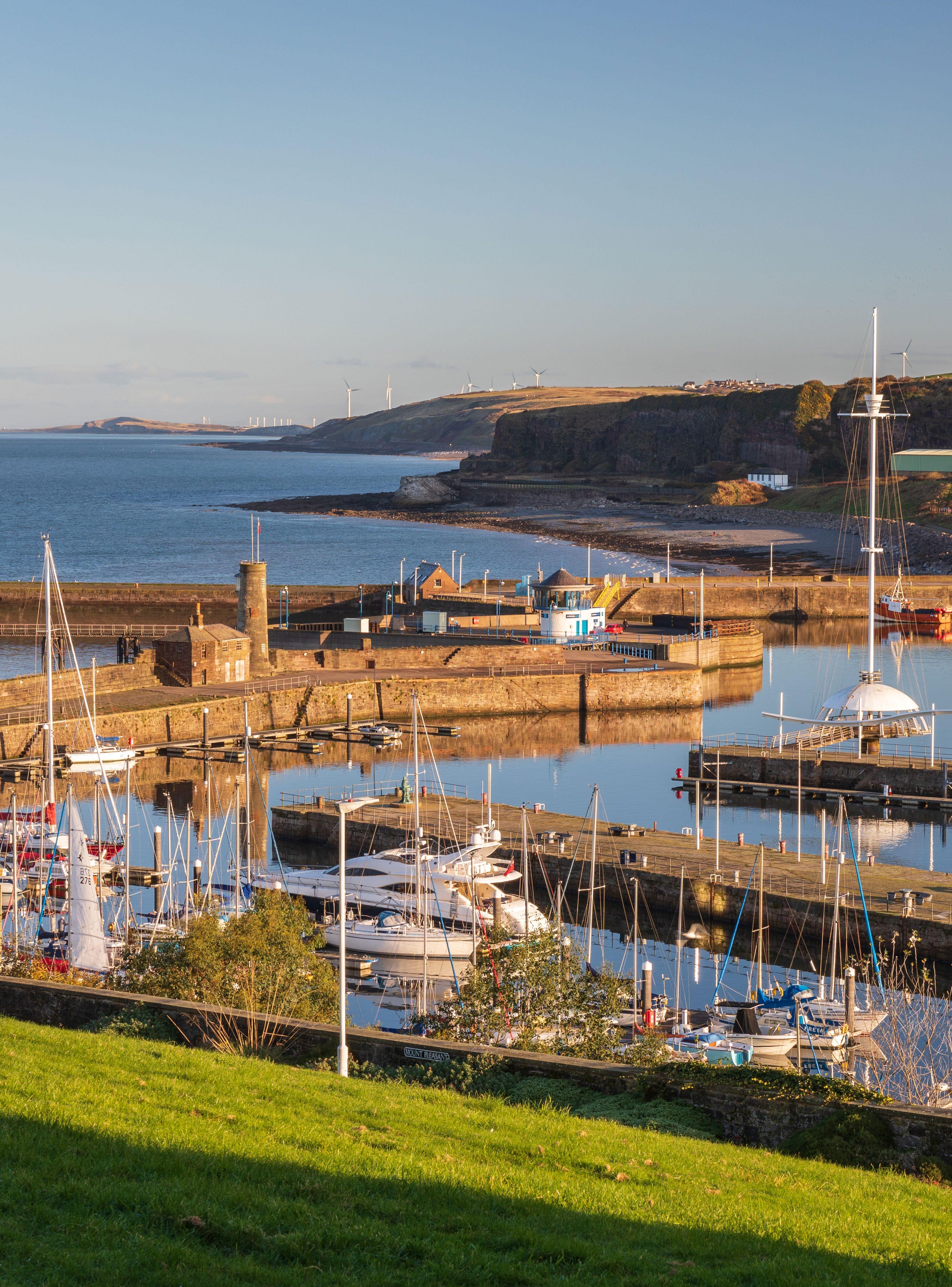
HOW CUMBRIA IS PERFORMING 2
24
Whitehaven Harbour
Appendix B provides a detailed review of the evidence on Cumbria’s visitor economy - past, present and future. It also maps out some of the planned investment that will impact on the visitor economy.
2.1 KEY MESSAGES
The key messages from this evidence analysis are summarised below:
Volume, value and origin of visitors
1. Cumbria has a large and important visitor economy. In 2022, 41 million visitors generated around £4.1 billion of total spend in the economy including multiplier effects. This supports £1.2 billion in direct GVA and overall, an estimated 34,300 jobs directly (FTEs).
2. Taking account of supply chain and multipliers, visitor economy spend supports an estimated 43,600 FTE jobs (19% of the county’s total) and around £1.6 billion in GVA (13% of Cumbria’s total in 2021).
3. In terms of jobs supported, the visitor economy is the largest source of employment in Cumbria and is one of the key planks of the economy.
4. The relative importance of the visitor economy varies widely across Cumbria and is more important in the Lake District, where there are fewer alternative industries.
5. The visitor economy is yet to recover to pre-Covid levels.
6. The 8 million overnight visitors in 2022 account for 43% of all tourism days and 54% of all tourism spend. The share of overnight visitors in total days and spend has risen since Covid and overall numbers are up on pre-Covid levels, in part driven by a strong increase in serviced accommodation. Although spend has risen, costs have also increased, leading to a squeeze on profitability.
7. Overnight visitors to Cumbria come from across the UK as well as internationally. There is, however, a strong north of England focus. In 2022, two-thirds of all overnight visitors came from either the North West, the North East or Yorkshire and the Humber.
8. The 33 million day visitors in 2022 accounted for 80% of all visitors, 57% of all days, but 46% of all spend. On average spend per day is a third less than overnight visitors. Day visitor numbers remain 16.5% down on pre-Covid levels.
9. As of 2022, international visitors accounted for around 3% of the total, which is significantly below the pre-Covid levels of 10% to 12%, but is showing signs of recovery (as it has been nationally).
10. The pattern of visitors in 2022 had shifted compared to pre-Covid, with an increase in the proportion of ethnic minority and younger visitors, as well as visitors from areas closer to Cumbria. It is not yet clear whether this shift will continue.
11. A significant proportion of visitors (14% in 2022) included someone in their group with a health issue or disability.
25 A DESTINATION MANAGEMENT PLAN FOR CUMBRIA: 2024 TO 2030
Nature of visits
12. There is a clear and consistent pattern as to why visitors come to Cumbria: for the landscape (66%) or to be outdoors (65%); as well as the area’s peace/beauty/relaxation (60%); for the health and wellbeing benefits of walking (40%); its remoteness and feeling of safety (35%); and to go on the water (29%). Broadly the motivations have stayed consistent over time.
13. Within Cumbria, the Lake District National Park (LDNP) accounts for roughly half of tourism activity. In 2022, tourism in the LDNP accounted for an estimated 53% of all spend across Cumbria, 44% of visits and 50% of days.
14. The share of the visitor economy in Cumbria outside the LDNP area has changed over the past decade. Prior to Covid, there was a slight decline in the share of spend, visitors and days occurring outside the LDNP area. However, there was significant absolute growth in the visitor economy in both the LDNP and the rest of Cumbria. Post-Covid, although there has been a recovery in the Lake District, the rest of Cumbria has seen relatively poor performance.
15. Visitors to Cumbria are concentrated in the perennially popular locations within the core parts of the Lake District (Ambleside/Windermere/Bowness/Grasmere and Keswick, then the lakes Ullswater and Coniston). Towns surrounding the LDNP make up the next tier of visitor locations (Kendal, Penrith, Cockermouth and Grange/Cartmel/Ulverston, Kirkby Lonsdale/Sedbergh/Kirkby Stephen, etc).
16. There are many areas of Cumbria with relatively few visitors. Carlisle, the largest settlement in Cumbria, is a city with a major castle, Tullie House Museum and Art Gallery, local food/drink and retail offer, and archaeology and heritage. It is relatively less visited, as is Hadrian’s Wall and the Cumbrian coast.
17. Visitors come to Cumbria all year-round, and there is no closed or entirely off-peak season. However, tourism - especially overnight tourism - remains seasonally driven by family holiday availability, accommodation availability, the weather and the outdoor focussed nature of many visitors. The seasonality of tourism is particularly pronounced outside the Lake District National Park.
18. A 10% increase in visitor spend in each of the off-peak months and 5% in the shoulder months outside the peak months for spend (July and August) would increase overall spend, based on 2022 figures, by around £255 million or 5%.
19. Most visitors still come to Cumbria by private vehicle. In 2022, an estimated 91% arrived by private vehicle, up from 86% in 2018 and 81% in 2015 (in part due to the drop in international visitors).
20. Once visitors have arrived in Cumbria, there are shifts in the modes of travel used. Although private vehicles remain the dominant form of transport (around 90% using car/van/ motorbike/motorhome), there is significant level of “active travel” with 57% of visitors travelling around on foot and 9% by bike/e-bike.
A DESTINATION MANAGEMENT PLAN FOR CUMBRIA: 2024 TO 2030 26
The sector and infrastructure
21. Cumbria’s visitor economy largely consists of small, independent and local businesses. Cumbria Tourism (CT) provides a focus for businesses to come together and work collectively. It represents 4,500 member businesses or nearly 20% of the 23,100 businesses across Cumbria in 2022. CT is also the Local Visitor Economy Partnership (LVEP) recognised by VisitEngland as the county’s lead tourism body and a conduit for visitor economy businesses and locally based associations and partnerships.
22. Access to the people and skills necessary to deliver services has been the biggest challenge for visitor economy businesses in Cumbria in recent years, mirroring national challenges across the hospitality sector, but being even more acute in Cumbria. The issues in Cumbria, especially in the Lake District National Park, are also connected with transport and housing.
23. Visitors increasingly expect and demand universal access to extremely high quality, reliable and consistent digital connectivity. Cumbria has historically had large areas with poor access to digital services due to its rural nature and typography.
24. There has been good work to support improvements in digital infrastructure, both fixed line broadband and mobile. However, there is still significant work to do to reach the most rural areas with comprehensive digital connectivity, as well as seeking to meet the increasing demand for 5G services. Therefore digital connectivity remains an issue for the visitor economy (for both business and visitors).
25. There are significant investments either planned, or already underway, that will provide opportunities for the visitor economy:
• There are plans, not yet funded, to improve rails service along the Lakes Line to Windermere and the Coastal Line from Carlisle to Barrow along the West Coast.
• Major investments are planned and, in some cases, underway in many town and city centres supported by the Borderlands Inclusive Growth Deal, Town Deal, Future High Street Fund and the Levelling Up Fund. A significant part of the planned investments are aimed at improving town centres and developing new facilities and attractions (for the local population and visitors alike).
• Other important visitor attractions, such as Tullie House Museum and Art Gallery in Carlisle, are planning substantial upgrades.
• A range of new and improved visitor trails and cycle ways have been developed or are planned, including the designation of the Coast to Coast Walk as a National Trail.
• The Carlisle Southern Relief Road will improve accessibility by road (although this needs to be balanced against the sustainability drivers for the visitor economy).
• The Cumbria Digital Infrastructure Strategy and Borderlands 5G Innovation Regions area will both look at opportunities to improve digital connectivity and encourage both commercial and public investment.
27 A DESTINATION MANAGEMENT PLAN FOR CUMBRIA: 2024 TO 2030
2.2 SWOT ANALYSIS
STRENGTHS
Assets
• Strong brand awareness (especially of the Lake District) and positive brand associations
• Unique natural cultural environment –landscape, coast, two World Heritage Sites, a Global Geopark, two National Parks and three National Landscapes, etc
• The lakes, tarns, rivers and sea offering opportunities for water activities (sailing, kayaking, wild swimming and paddle boarding) with steamer/ferry services on 4 lakes
• Space, lack of development, openness, dark skies
• Visitors come to Cumbria all year round; there is no closed or entirely off peak season
• Well positioned in terms of outdoor activities –walking, cycling, water sports - and so “green”, health & wellbeing
• Breadth and quality of our local food and drink offer
• Rich range of cultural assets and attractions –historic houses, archaeological sites, the City of Carlisle (castle, Tullie House and the Cathedral), old towns and villages, traditional country and farming shows
• Good health and wellbeing attributes benefitting both visitors and communities
• High quality hotels and facilities offer
• Wide range of accommodation offers and recent upgrade in facilities
• Key attractions; internationally and nationally known
Markets
• Loyal and repeat visitors from the UK
• Recent attraction of new domestic market segments (especially from relatively local areas across the North of England) and increased % of younger audiences
• Proximity (in terms of drive times) to large urban conurbations (central belt in Scotland, North East, West Yorkshire and Manchester and Liverpool City Regions)
Sector working and infrastructure
• A flexible and adaptable sector – many small and family businesses
• Good cross-sector working and public-private links in the visitor economy
• Cohesion through local plan, LDNPA engagement, World Heritage Site organisation, close communities
• Base of transport infrastructure to build on
Markets/visitors
WEAKNESSES
• Peripheral market for most international visitors –limited awareness
• Poor awareness of ‘hidden gems’
• Limited visitor numbers to less core places outside the LDNP (e.g. Carlisle), overly concentrated in a few more well-known locations
• Recent increased reliance on the North of England as a core market for staying visitors
• Lack of integrated ticketing, e.g. attractions, transport and parking
Business/sector
• Serious staffing shortages
• Poor image for careers – low wage and perception of weak career offer
• Communication/messaging disparate, lack of one voice for the sector
• Businesses with post-Covid damaged balance sheets and with squeezed profitability making it harder to invest
Facilities
• Lack of investment in major transport and infrastructure projects
• Poor digital infrastructure in parts of Cumbria, especially very rural areas – limited capacity for 4G and limited investment into 5G
• Cumbria, especially the LDNP, is currently seen as a challenging area for investment into new mobile infrastructure
• Lack of grid infrastructure for EV chargepoints
• Poor public transport offer within parts of the Lake District and elsewhere in Cumbria (e.g. Eden Valley)
• Quality and visibility of accessibility offer
• Car parking provision in more well known locations and visibility of capacity
• Heavy visitor usage over years in some locations and facilities, leading to degradation and need for re-investment
• Limited higher quality accommodation offer in West Cumbria and Barrow area
A DESTINATION MANAGEMENT PLAN FOR CUMBRIA: 2024 TO 2030 28
OPPORTUNITIES
Assets
• Under visited and exploited Hadrian’s Wall area/Carlisle and sites with historical links
• Under visited areas of coastline/landscape/western lakes
• Under visited attractions with historical, military and industrial links (from Barrow to Maryport and Carlisle)
• Planned investment in visitor facilities and attractions in Barrow, Carlisle, Maryport, Millom and Whitehaven
• Under used accommodation and facilities outside peak season – opportunity to grow productivity by extending the season via events, etc
• Extend and improve offer for cycling and other outdoor activities
• Linkages to existing and new attractions in surrounding areas (Eden Project Morecambe, Kielder Forest, Hadrian’s Wall Northumberland, other parts of the North Pennines National Landscape, Yorkshire Dales, South Scotland forests, etc)
Markets
• Returning international markets to the UK
• Proximity to areas with international profile and gateways: Manchester, Liverpool (with raised profile as a result of Eurovision) and Scotland
• Low levels of visitation from higher earning London/South East markets
• Opportunities to increase inclusivity and accessibility (Purple Pound)
• Building on health & wellbeing offer – “Natural Health Service”
• Build reputation as a low carbon sustainable rural tourism location
• Continue to grow younger market
• Strong interest in business investment opportunities by private sector
• Eden Project North
• Links to staycation and live, work and study offer
• Significant growth in Advanced Manufacturing (BAE Systems/ Nuclear) could lead to growth in accommodation demand, business tourism.
Sector working and infrastructure
• Growing the local employment and career offer
• Working in partnership to organise and address issues
• Experience and capability growth/creation – career and education pathways into visitor economy
• Develop lower carbon and lower energy businesses
• Improved digital connectivity through fixed line broadband and mobile infrastructure
• Innovation opportunities
• Develop Cumbria as a Centre of Excellence for Hospitality Training
Funding
• Availability of Borderlands Place Programme (three towns), approval of Town Deal (four towns/cities), Future High Street Fund (one town) and Levelling Up (one town) creating opportunities for improvement of key destinations surrounding the Lake District
THREATS
Markets/visitors
• Squeezed UK incomes and cost of living crisis reducing visitor numbers and/or spend per visit
• The right balance of tourism numbers versus sustainable rural landscape management
• Global competitive market – we need to be ‘first movers’
• For international visitors, the new ESTAs, costs compared to Europe and tax-free shopping affecting the competitiveness of UK
• Shift to more EV owners and limited local charging points
• Reliance of car-based visits at odds with desire to promote low carbon tourism
Business/sector
• Increasing cost base in terms of staff and energy/other costs
• Continued labour workforce shortage
• Growth of second/holiday homes and Airbnb, plus property values driving lack of affordable housing for staff
• Lack of community support and resistance to development in some places?
Facilities and environment
• Damage to landscape, nature/ biodiversity and tourism offer/ facilities
• Effect of climate change and adverse weather on the environment, on facilities and on the visitor experience (wetter winters, flooding, droughts, etc)
• Concerns over water quality in lakes and other water bodies
• Local government funding for services
• Poor relative digital connectivity and capacity as usage and demand from visitors increases, as well as difficulty in attracting investment in areas with low numbers of yearround residential customers
29 A DESTINATION MANAGEMENT PLAN FOR CUMBRIA: 2024 TO 2030
VISION AND OBJECTIVES 3

3 VISION AND OBJECTIVES
Muncaster Castle ©Rob Duncalf 30
3.1 OUR VISION
The DMP has a long-term shared vision for Cumbria to ensure we retain our distinctiveness and competitiveness as a visitor destination:
“Famed for our world-class landscapes and culture, by 2040 Cumbria will be Britain’s most vibrant and sustainable rural destination, boasting a reputation for quality, welcome, and an adventure for everyone, bringing benefits for visitors, the economy, nature and our communities”.
This is a long-term and ambitious vision that builds on our strengths.
3.2 KEY OBJECTIVES FOR THE DMP
The following overarching objectives have been developed to address the opportunities and challenges faced by Cumbria’s visitor economy.
OBJECTIVE:
DRIVE ECONOMIC GROWTH
OBJECTIVE:
ENSURE A SUSTAINABLE & RESPONSIBLE VISITOR DESTINATION
OBJECTIVE:
ENSURE AN INCLUSIVE & ACCESSIBLE VISITOR DESTINATION
OBJECTIVE:
BE RESOURCED TO DELIVER
Increasing the value and productivity of Cumbria’s visitor economy
Supporting responsible tourism, benefitting the environment and vibrant communities
Ensuring all visitors can enjoy Cumbria as a destination
Supporting the sector to deliver world class experiences
One objective is about growing the value of the visitor economy to deliver the economic benefits outlined earlier by attracting visitors to stay longer, visit less well-known parts of the county and increase visits out of season.
The next objective is about positioning Cumbria as a leading sustainable and responsible tourism destination. This requires managing visitors as they journey to us and when they are here. It requires our businesses to develop their plans to offer low and zero carbon experiences in ways which inspire, excite and attract.
This will maximise visitors’ experiences, bring beneficial local economic impact and minimise their environmental impact. It will accelerate the reduction of the overall carbon footprint from tourism activity in Cumbria and catalyse sustainable choices at the same time as creating world leading experiences.
This objective follows through on the aspiration of the vision and will provide visitors with confidence and excitement to come - knowing they have had a low carbon, low environmental impact experience. Cumbria aspires to be a globally leading environmentally responsible destination, promoting a culture of understanding of the area to the visitor and in so doing, encouraging a philosophy to protect our natural capital (as the “loved destination”).
Another objective focuses on being an inclusive and accessible destination. That means being - and becoming – a place that attracts and caters for all types of visitors, offering “adventure for
31 A DESTINATION MANAGEMENT PLAN FOR CUMBRIA: 2024 TO 2030
everyone” and a “warm welcome for all”. This requires suitable facilities, movement infrastructure (including digital infrastructure, signage, information and promotion) and information and guidance for businesses. Both the Lake District and Yorkshire Dales National Park Management Plans have priorities related to making them places that are “welcoming for all”.
It is not possible to deliver on the first three objectives without a sector - and supporting infrastructure - that has the capability to deliver world class experiences. This fourth overarching objective is therefore about supporting the visitor economy sector to be resilient, to operate effectively and to support innovation and productivity. It addresses the opportunities and challenges in the delivery of services to visitors.
Although there a few larger businesses in Cumbria, the vast majority of visitor economy businesses in Cumbria are SMEs, with the emphasis on small or micro. Businesses can struggle to access information/suppliers and to find time to consider how to improve their businesses and address opportunities and challenges.
3.3 OBJECTIVE - INCREASING THE VALUE AND PRODUCTIVITY OF THE VISITOR ECONOMY
This objective comprises of five key strands which largely build on - and are a continuation of - the past focus of partners involved in the visitor economy.
3.3.1 �Growth Priority 1A - Continue to implement the strategy to raise the appeal and awareness of less well-known and visited parts of the county.
There are specific places in Cumbria which are already extremely popular, whilst there are other areas where there is much greater capacity to absorb visitor numbers and the extra visitor spend would be particularly beneficial (see Appendix B). For many years Cumbria has followed an “attract and disperse” strategy to try and increase visitor activity and increase the share of visitor value and wider benefits in less well-known and visited parts of the county.
The DMP is intended to redouble and refocus efforts on this strategy. The focus is about encouraging both day and overnight visitors to discover, visit and spend time and money in less well-known locations as well. This will involve a mixture of investment in alternative attractions/ trails and sustained marketing and promotion. Given forthcoming planned investments in several under-visited locations, including Carlisle and Barrow, there is a real opportunity to make progress here.
It will be important that additional visitor numbers in these areas are strategically managed (e.g. in more rural areas of Cumbria where there may be limited infrastructure for visitors).
Encouraging visitors to visit or stay in parts of the West Coast has long proved challenging. In part, this is due to distance and travel accessibility, and in part, it reflects the range of visitor product that is available. There is significant investment going into improving places and facilities in several West Coast towns. However, although these will help encourage more visitors, they are not at the scale of transformational projects of regional or national significance. As part of this priority area, partners will continue to explore the scope for more transformational projects in West Cumbria.
A DESTINATION MANAGEMENT PLAN FOR CUMBRIA: 2024 TO 2030 32
3.1: Under visited opportunity areas in Cumbria
The areas which are relatively undiscovered and under visited in Cumbria include:
• Some parts of the Western Lake District (e.g. the coastal part of the National Park).
• Areas immediately adjacent to Lake District National Park:
◦ Cockermouth
◦ The West Coast
◦ Ulverston/Furness Peninsula and the Cartmel Peninsula
◦ Barrow
◦ Kendal
◦ Penrith and the Eden Valley
Figure
HADRIAN’S WALL I I I I I I I I I II I II I I I I I I I I NORTHUMBERLAND CARLISLE COCKERMOUTH KENDAL WORKINGTON GRASMERE CONISTON ULVERSTON LANCASTER WIGTON LANCASHIRE YORKSHIRE COUNTY DURHAM SCOTLAND KESWICK SEDBERGH APPLEBY-INWESTMORLAND PENRITH ALSTON KIRKBY STEPHEN WINDERMERE WHITEHAVEN SHAP HAWKSHEAD CARTMEL M6 S o l w a y F i r t h N o r t h P e n n i n e s ARNSIDE BRAMPTON MARYPORT AMBLESIDE RAVENGLASS MORECAMBE BARROW-INFURNESS BOWNESS-ONSOLWAY SILLOTH 39 38 37 36 35 34 42 41 40 43 NEWBY BRIDGE KIRKBY LONSDALE 44 S S M6 S S SOLWAY COAST NATIONAL LANDSCAPE ARNSIDE & SILVERDALE NATIONAL LANDSCAPE NORTH PENNINES NATIONAL LANDSCAPE GRANGEOVER-SANDS A683 A591 A590 A595 A5074 A684 A65 A6 A66 A685 A686 A69 A66 A595 A595 A7 A6071 A591 A689 A6 A6 A5086 A593 A5084 A595 A595 A689 A66 A595 A5087 A592 A685 A66 A683 A683 A687 A590 A591 A596 A594 1 WEST COAST MAIN LINE 1 TYNE VALLEY LINE 1 SETTLE TO CARLISLE LINE 1 CUMBRIAN COAST LINE 1 FURNESS LINE 1 LAKE LINE Eskdale Great Langdale Duddon Valley Lyth Valley Borrowdale Th e H o w gills Wasdale Ennerdale 0 Miles 0 Kilometres 5 8 10 16 B/Minor Roads A Roads Motorway National Landscape Lake District National Park Yorkshire Dales National Park KEY 33 A DESTINATION MANAGEMENT PLAN FOR CUMBRIA: 2024 TO 2030
• Carlisle and Hadrian’s Wall Country
• The Solway Coast (which links to Hadrian’s Wall Country)
• The Yorkshire Dales in Cumbria (which link to the Eden Valley)
• The North Pennines National Landscape within Cumbria
3.3.2 Growth Priority 1B – Grow the all-season offer and become known as a year-round destination for all
All year-round tourism supports visitor management, by improving tourism business profitability and in staff recruitment and retention, by providing more permanent roles. Although Cumbria is already less seasonal than rural coastal locations in England (such as Cornwall, the South West and Northumberland) it has a much more pronounced pattern of visitor spend and occupancy than the national average. As noted earlier, a combination of 10% and 5% increases in visitor spend across the ten less well performing months of the year would increase overall visitor spend by some £270million (or 6%) in Cumbria. This requires further consideration around festivals and events in shoulder months, more all-weather attractions and of course, marketing.
3.3.3 Growth Priority 1C - Regain and grow international spend and other higher value overnight stays
CT’s research shows that international visitors tend to spend 55% more per person per day than domestic visitors. The pre-covid local research suggests that around 10% of our visitors are international, although for some operators, international visitors can account for as much as 25% of business.
Thanks to significant investment by the private sector over many years, alongside promotion by Cumbria Tourism - aligned to Visit Britain’s Strategy – the volume and therefore value of international visitors was growing pre-covid. Cumbria was beginning to see the benefits from international visitors countywide, with key markets including the US and Canada, China, Japan and Europe. Pre-Covid there was also evidence of the Indian market emerging.
The focus is on attracting international visitors who have already come to the UK. Therefore, the activity is not intended to lead to increased long haul (or short haul) air travel. Research shows that international visitors to Cumbria are much less likely to arrive and travel round by car. Within the UK, the DMP encourages international visitors to travel to and within Cumbria by low carbon forms of transport.
3.3.4 Growth Priority 1D – Convert more visitors to overnight stays and extend the length of stays
Overnight visitors have a much greater economic impact relative to their visit than day visitors. In 2022 the average spend per day associated with an overnight visitor was 65% above that of a day visitor, and the total economic impact of an average overnight visit was almost five times that of a day visit9
The economic impact of staying visitors relative to their environmental impact is generally much better than for day visitors – in terms of travel, carbon footprint and concentration on honey pot
A DESTINATION MANAGEMENT PLAN FOR CUMBRIA: 2024 TO 2030 34
9 Average spend per day of £55 for a day visitor and £91 for an overnight visitor. Total spend on average of £317 for each overnight visit, lasting an average of 3.5 days (all 2022 data).
locations. The priority is to try and increase the number of overnight visitors relative to day visitors10 and to increase the length of stay of overnight visitors in Cumbria.
The pandemic has had a severe impact on the shape of the inbound and outbound travel industry. The impact of Brexit has too, with challenges around attaining visas, competition from Schengen countries and negative perceptions of travelling to the UK. China is only just beginning to re-open and travel from Japan and other nations has been impacted by the war in Ukraine, as well as soaring flight prices and limited availability. International visits fell to just 1% of the total in 2020 and 3% in 2022.
As noted in Appendix B, overall international inbound tourism to the UK started to recover to pre-Covid levels in 2023. Cumbria began to see a distinct uplift in international visits and we now expect this to continue.
3.3.5 �Growth Priority 1E - Adapt to and lead market trends and opportunities to ensure Cumbria attracts future new and repeat visitors
The final growth priority reflects the need to respond to the ever-changing nature of travel and tourism trends and opportunities. It also reflects demographic and other trends in UK society and internationally. Cumbria needs to ensure it can attract the “next generation” of visitors from “Millennials” and “Generation Z”11 . There is a need to invest in promotion and the product to attract:
• Younger adult markets:
◦ Previously, there has been a concern that Cumbria was losing its attraction to younger adults12 and this could pose a long-term threat to the visitor economy if the awareness ofand/or the habit of visiting - Cumbria was lost (or never established).
◦ However, the shift in the age profile of visitors since 2019 has provided an opportunity. The proportion of children under the age of 16 has stayed stable, but the evidence suggests there are now more younger adults visiting Cumbria, and fewer older adults. In total, 40% of visitors to Cumbria are between 16 and 44 years of age, up from 27% in 2018. The share of visitors aged over 60 has dropped from 33% in 2018 to 13% in 2022.
The aim is to ensure the attractiveness and relevance of Cumbria to this group, for whom there are a wide range of choices.
• Accessibility markets: Visitors with accessibility requirements and their carers/families, in part reflecting the demographics of an ageing population.
◦ Cumbria Tourism’s 2022 Visitor Survey reveals 14% of visitor groups included someone in their party with health issues or a disability that limits their daily activities. In respect to wellbeing and mental health, 93% of all visitors said they felt better physically from visiting the Lake District. 94% felt better mentally from visiting the LDNP - up from 80% in 2015.
◦ With the numbers of disabled visitors looking to enjoy Cumbria’s countryside on the increase, partners are committed to raising awareness and facilities servicing this important audience. Making tourist experiences more accessible will have a wider impactbenefiting groups such as parents with prams and the elderly too.
10 In practice this is not as simple as “converting” day visitors to stay overnight as the markets and motivations can be quite different.
11 Millennials are generally taken to be born between 1981 and 1996 (i.e. now in their mid-20s and 30s) and Generation Z were born 1997 to 2010 (i.e. mid-20s and younger).
12 There is no hard and fast definition of “younger adults”; they could be those under 30 or even under 40. In marketing or sociological terms, they might be called “Millennials” (around 25 to 40 at present) and “Generation Z” (under 25).
35 A DESTINATION MANAGEMENT PLAN FOR CUMBRIA: 2024 TO 2030
◦ But despite these incredibly positive developments it remains difficult for a disabled person/their family/friends to readily find the information they require to access this area and these facilities, either before or after arrival. This lack of information has been identified as one of the main barriers for people with an impairment who wish to visit the area.
◦ The aim is to put Lake District Cumbria on the map as one of the leading outdoors focussed accessible destinations in the UK.
• Visitors from ethnic minorities and other national backgrounds living in the UK:
◦ For many years, the evidence was that the Lake District and Cumbria had low rates of visitation by people from ethnic minority backgrounds (which is true in all National Parks).
◦ In 2022, 16% of visitor groups included someone in the party from an ethnic minority community – up from just 2% in 2018. This changing visiting pattern represents an opportunity to attract a more ethnically diverse range of visitors to Cumbria than has historically been the case, with the share of residents in Cumbria’s historic main catchment area13 from ethnic minority backgrounds likely to rise in the future.
There are also potential opportunities from business tourism which could be developed in Cumbria. However, the capacity to host significant business events is limited in the county and the market in the UK is focussed on cities or seaside/spa towns with large event spaces and hotel stock. The focus of business tourism in Cumbria therefore needs to be intrinsically linked to its distinct offer.
There are also significant opportunities from tourism linked to film and TV programmes. This stems both from the contribution to the visitor economy whilst filming is taking place, but more importantly, from the marketing and profile it can give to particular locations14 .
There are opportunities to expand event-based tourism in Cumbria. A sub-group of SVMG has been set up to support attract and disperse, sustainable and inclusive tourism, season extension, increase in overnight stays etc.
This will lead to a film and TV strategy that supports our destination priorities to establish:
• What kinds of events we want
• When we want them
• Where we want them
• Whether they fit our destination priorities
• What we don’t want, when and where.
13 The North West, North East and Yorkshire and the Humber regions (in 2015 and 2018 accounting for half of all visitors (UK and international), but over three quarters in 2022).
A DESTINATION MANAGEMENT PLAN FOR CUMBRIA: 2024 TO 2030 36
14 Visit Britain has teamed up with the British Film Commission to launch Starring Great Britain in 2024 and will be working with studios and production companies to promote films, TV series and their locations.
3.4 OBJECTIVE – RESPONSIBLE & SUSTAINABLE
SUPPORTING RESPONSIBLE TOURISM, BENEFITTING THE ENVIRONMENT AND VIBRANT COMMUNITIES
Sustainable Priority 2A:
Enhance and expand the opportunities and capabilities for convenient, low carbon visitor movement and experience(s) both into and inside Cumbria for the benefit of visitors, residents and workers
Sustainable Priority 2B:
Promote and support sustainable and active travel and experiences
These are both critical elements of the overall objective. The Lake District National Park has been something of a test bed for sustainable transport initiatives and this is a key focus of its Management Plan.
This involves helping and encouraging more visitors to arrive by modes of transport other than car, or if they do arrive by car, helping them to minimise their usage during their stay in Cumbria. It includes encouraging walking and cycling, as well as using local buses, train services and boats/ferries. It also covers the use of electric vehicles to and inside Cumbria. This requires improvements to some of our infrastructure, in particular, investment to improve the capacity and reliability of the railway lines in Cumbria. Enhanced bus service provision is also needed, supported by reliable and easy-to-use online information about route planning which can be accessed ‘on the go’, as well as traditional offline information sources. Critically, it requires proper coordination of different modes to create a genuinely integrated “end to end” transport system.
Sustainable and active travel needs to become easy, fun and a ‘must do’ integral part of the visitor experience, becoming a motivator for visiting. Investment in active travel routes will form a key part of improving this part of the visitor offer.
The UK is seeing growth in the ownership and use of EV and hybrid vehicles and increasingly, visitors arriving in these vehicles will be seeking reassurance they can charge their vehicles both en-route and whilst staying in Cumbria. However, there is a long way to go in terms of rolling out an EV charging infrastructure across Cumbria and its main visitor destinations. A report by CaFS15 indicated that (taking mid-range figures) 4,250 public chargepoints could be required in Cumbria by 2030 to meet the combined public and visitor demand (or a rate of circa. 40 new public charge points every month from the base of c. 260 in May 2021). Recent funding received by our local authorities, plus investment by the private sector, will help stimulate improved provision of EV charging points.
Achieving these objectives will require partners to continue making the case for investment in transport in Cumbria, through business cases and funding bids. It can sometimes be difficult to make the case for transport in more rural areas, but we can make the case stronger by focusing on the significant contribution visitors make to the Cumbrian economy.
Electric Vehicle Charging Deployment in
Analysis & Forecasting, CaFS, June 2021` (they quote a
of 2,100 to 6,400 and we have taken the mid-point of this range or 4,250). 37 A DESTINATION MANAGEMENT PLAN FOR CUMBRIA: 2024 TO 2030
15
Cumbria,
range
3.4.1 Sustainable Priority 2C: Increase the local social and economic benefit from visitor spend, supporting the vibrancy of our villages, towns and city
Visitors bring considerable economic benefits to local communities and many businesses have worked hard to increase their local content. However, a significant proportion of visitor spend still “leaks” out of Cumbria’s economy, losing value from the local economy and adding to carbon emissions. Reducing this “leaky bucket” is about both supply chain development and education/ awareness of visitors and businesses.
3.4.2 Sustainable Priority 2D: Encourage, educate and engage all visitors in responsible tourism, protecting and valuing our environment and communities
There is a national and global challenge/opportunity to increase awareness and encourage visitors to champion “responsible tourism”. As part of the DMP, we are seeking to redouble our collective efforts to educate, engage, inspire and support visitors to choose behaviours that make this as easy as possible (e.g. reduce waste, litter, etc).
This requires collective effort including that of visitor economy businesses to encourage and educate visitors in responsible tourism behaviour (providing information and advice in advance of visits and whilst in Cumbria).
This is also an opportunity to further develop visitor activity linking tourism and heritage/ environment. For example, increasing tourism based on learning traditional skills, practical conservation work, local food/produce, learning about farming, volunteering, etc.
3.4.3
�Sustainable Priority 2E: Support activities that sustain and enhance
the environment
The DMP recognises that visitors directly - and visitor economy businesses directly and indirectly - create environmental footprints from their activities. It is important that visitor economy businesses, partners involved in the DMP and visitors themselves further contribute to actions that reduce or offset environmental damage and contribute to improving the environmental resilience and quality of Cumbria. This covers air quality, water quality, resilience to flooding and waste levels ,as well as the carbon footprint of activities.
It also means ensuring access to Cumbria’s countryside, including the challenges of maintaining the footpath and bridleway network, which is vital for recreation.
The DMP supports actions that:
1. Offset direct environmental impact from visitor activities (e.g. via Fix the Fells) and lead to environmental improvements and improved sustainable visitor access.
2. Help generate funding to invest in environmental improvements (and visitor facility improvements).
3. Encourage and help visitor economy businesses to become more environmentally sustainable (e.g. reducing water usage or reducing food waste/food miles). (See also Support Priority 4C)
A DESTINATION MANAGEMENT PLAN FOR CUMBRIA: 2024 TO 2030 38
3.4.4 �Sustainable Priority 2F: Actively monitor and manage visitor pressure on key tourism destinations
The focus here is to take a proactive approach to maintain the visitor experience and minimise any adverse environmental impacts from visitors.
The actions include promotion and marketing of alternative locations (i.e. the “disperse” part of Objective 1A), as well as visitor management to reduce pressures on key locations, supported by real-time data sharing and interpretation.
The Strategic Visitor Management Group (SVMG) was set up in 2020 to respond to concerns about visitor pressure during covid. Its members are: Cumberland Council, Cumbria Police, Cumbria Tourism, the LDNPA, National Trust, Forestry England, Westmorland and Furness Council, Highways England and the Lake District Search and Mountain Rescue Association.
 Fix the Fells helicoper lifts
Fix the Fells helicoper lifts
39 A DESTINATION MANAGEMENT PLAN FOR CUMBRIA: 2024 TO 2030
© AdeGidneyPhotography
3.5 OBJECTIVE - INCLUSIVE & ACCESSIBLE
ENSURING ALL VISITORS CAN ENJOY CUMBRIA AS A DESTINATION
3.5.1 Inclusive Priority 3A: Ensure Cumbria’s infrastructure and welcome is accessible to all
There has been good progress in making parts of the visitor infrastructure accessible to those with additional accessibility needs. Cumbria is in some respects a world leader in the provision of outdoor experiences for those with disabilities via bodies such as the Lake District Calvert Trust and the Bendrigg Trust. As we face an increasingly ageing population the number of visitors (both from within and outside the county) with accessibility and mobility issues will increase. The so called “Purple Pound” is already important for the visitor economy and will grow in the future. There is much more that can be done in respect of accommodation, training for businesses, visitor facilities and accessible trails.
3.5.2 Inclusive Priority 3B: Ensure Cumbria’s product and welcome is inclusive for all visitor groups
Linked also to Priority 1E about new market opportunities, the DMP seeks to expand visits from groups that have traditionally been less likely to visit Cumbria: younger adults, people from minority ethnic backgrounds and people with disabilities and access needs.
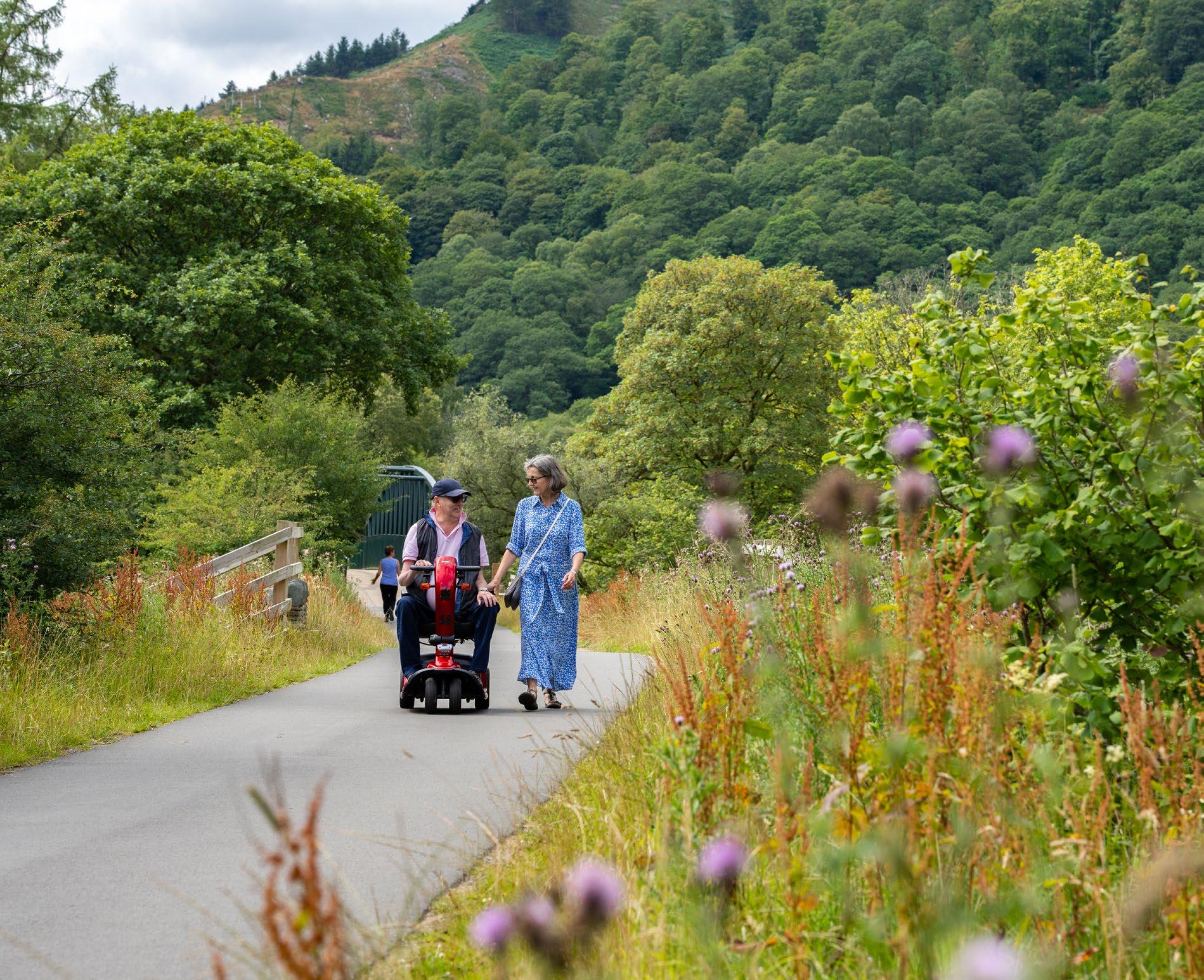
A DESTINATION MANAGEMENT PLAN FOR CUMBRIA: 2024 TO 2030 40
Keswick to Threlkeld Railway Trail
3.6 OBJECTIVE - RESOURCED TO DELIVER
SUPPORTING THE SECTOR AND ENSURING THE INFRASTRUCTURE TO DELIVER WORLD CLASS EXPERIENCES AND MEET THE NEEDS OF COMMUNITIES
3.6.1 �Support Priority 4A: Develop better infrastructure and attract investment in the quality and range of product
Essentially this is about supporting business, where appropriate, to invest in their visitor product. For instance, in accessing grant funding or private investment. We seek to attract world-class development into new or improved tourism product, building on past investment in high quality arts and cultural facilities, high-end hotel and spa facilities, and a wide range of new types of visitor accommodation (from yurts to treehouses).
3.6.2 �Support Priority 4B: Attract, retain and develop a skilled and committed workforce
At present, the most significant business issue for most visitor economy businesses is access to people and their skills. In many parts of Cumbria there are unfilled posts at every level of the business. The sector cannot deliver world class experiences without a trained and committed workforce. Therefore, this strand is a key element of the DMP.
There is current work, led by Cumbria LEP, that is aimed at addressing labour shortages across Cumbria for all sectors including the visitor economy sector and where CT, as LVEP, has the lead co-ordinating role.
The DMP recognises the need for a holistic approach to skills and labour supply for the visitor economy sector where worker transport and access to accommodation are critical issues.
3.6.3 Support Priority 4C: Support businesses to move to more environmentally sustainable operations
This is a complementary strand to those in Sustainable Priority 2, which are about working with visitors to reduce their carbon footprint. It is about helping businesses deliver lower carbon emitting goods and services for the visitor economy. There is support for business decarbonisation in parts of Cumbria from the UK Shared Prosperity Fund until at least the end of 2024/25.
3.6.4 Support Priority 4D: Support businesses to adapt, innovate and achieve excellence
There is a need for considerable change across the sector to deal with labour shortages, to address the increasing impact of digital and other technologies. The development of new technologies such as AI has the potential to have major impacts on aspects of the visitor economy sector (for instance in relation to navigation, interpretation, and potentially some customer facing services) as well as advanced wireless connectivity. Funding from the UK Shared Prosperity Fund has the potential to underpin such support, including for new start-ups, at least until the end of 2024/25. The Borderlands 5G Innovation Regions programme will also provide opportunities for businesses and stakeholders to engage with a range of new technologies.
41 A DESTINATION MANAGEMENT PLAN FOR CUMBRIA: 2024 TO 2030
3.6.5 Support Priority 4E: Ensure digital connectivity (both mobile and fixed line) is fit for the future
Access to ever improved digital connectivity in buildings and on the move will be essential for a successful visitor economy, apart from a small niche market who wish to deliberately be “off the grid”. Cumbria continues to have significant “not spots” where there is no - or very limited - 4G signal (see Appendix B). The roll-out of 5G presents - especially in light of the Borderlands being named a 5G Innovation Region - both opportunities and the threat of an increasing digital divide if Cumbria fails to keep up with the UK-wide levels of services. Parts of Cumbria, especially in the Lake District, present an opportunity to explore/pilot alternative means of providing mobile digital connectivity that has the most limited environmental impact. For example, the potential use of small cell advanced wireless networks mounted on existing public assets as proposed for the Windermere 5G Ferry pilot in the Borderlands 5G Innovation Regions programme.
3.6.6 Support Priority 4F: Ensure provision of adequate and consistent visitor services across Cumbria and Support Priority 4G: Ensure a joined-up approach to enable a resilient visitor economy
There are a range of issues and basic services needed by visitors to Cumbria (covering signage, public realm, parking provision, litter management, toilets, black and grey waste provision for motorhomes, etc). We need to ensure these essentials are available to the right quality, are properly maintained and are consistent across visitor locations in Cumbria.
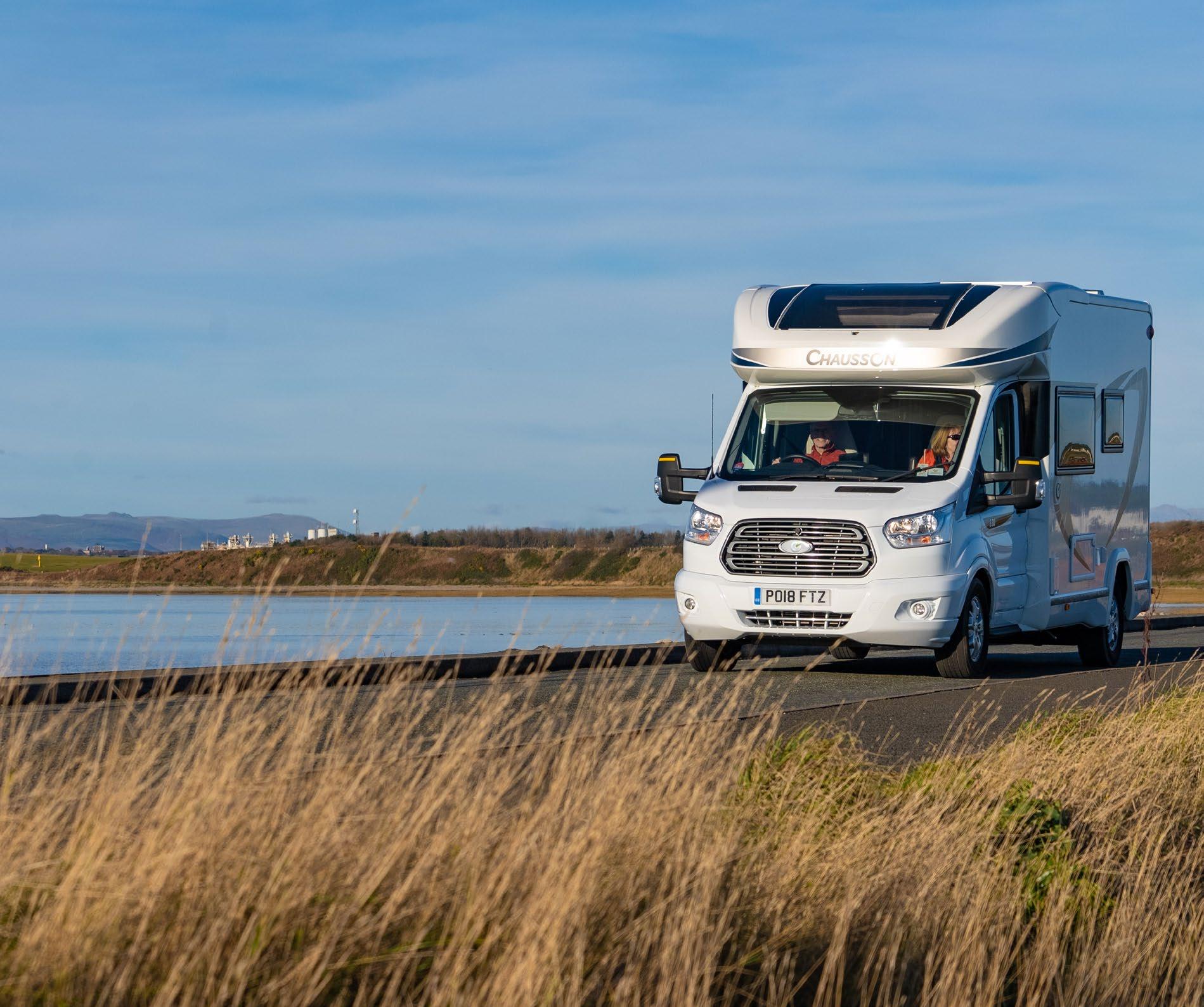
A DESTINATION MANAGEMENT PLAN FOR CUMBRIA: 2024 TO 2030 42
Cumbria Coastal Route (CCR200)
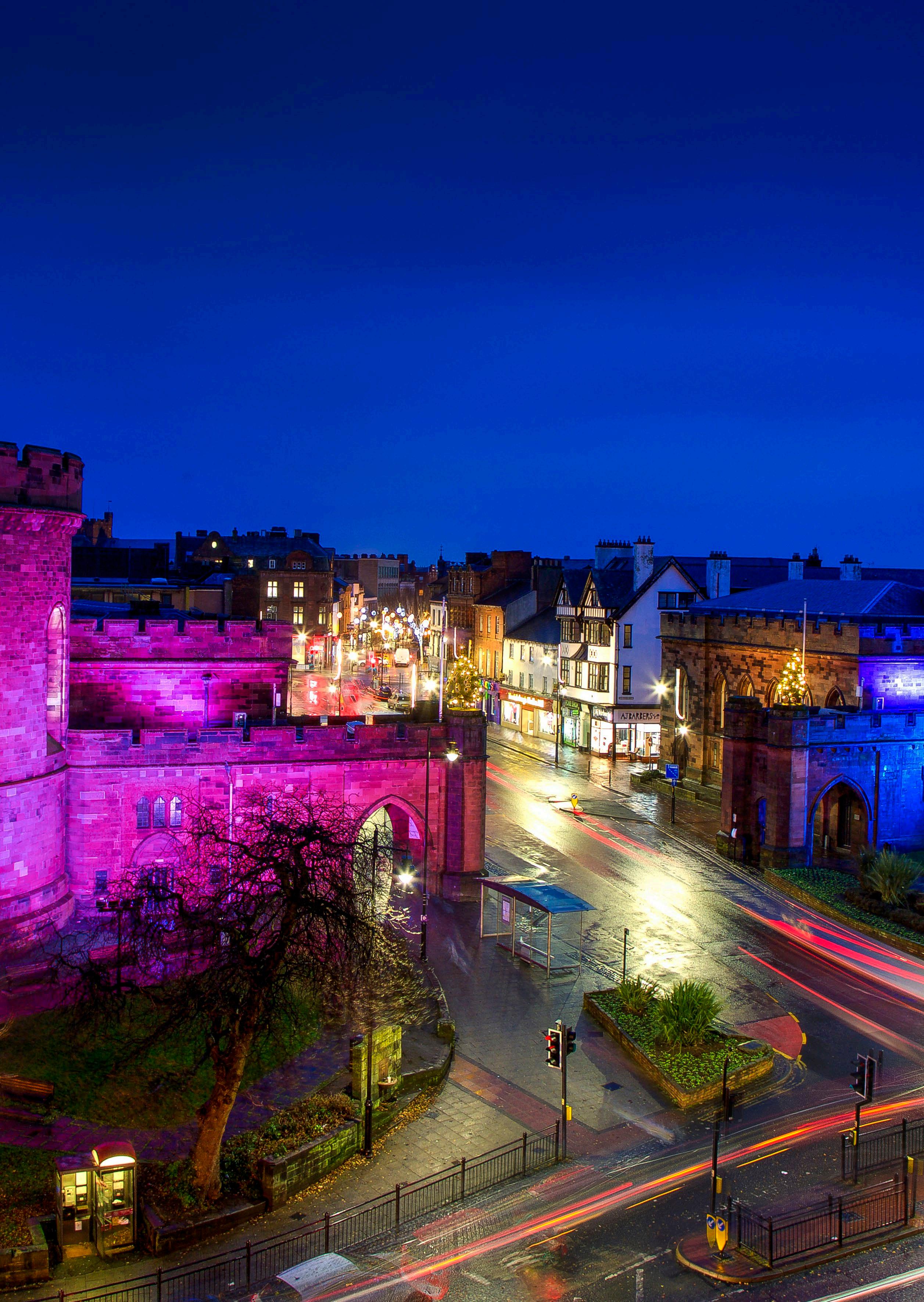
AMBITIONS AND OUTCOMES 4
43
Carlisle Citadel ©D&H Photography
It is important to have a framework for measuring progress towards the vision and across the objectives of the DMP.
The DMP is multifaceted, reflecting the complex nature of the visitor economy. The following tables set out the “ambitions” for progress under each of the four objectives. These will be used to monitor progress by the DMP Steering Group and to help focus actions by partners.
The ambitions have been developed for each of the objectives independently. However, there has been a sense check to ensure that they can be internally consistent. In particular, the DMP is seeking to enhance the economic value of the visitor economy to Cumbria (Objective 1) whilst at the same time seeking to ensure the environmental and other impacts of visitors are reduced, and indeed, the visitor economy contributes towards improvements across Cumbria. This is possible if we manage to alter the profile and behaviours of visitors as sought in this DMP.
All of the ambitions set out below can - and will - be influenced by the actions of partners in Cumbria. However, we are unable to control the wider operating environment - legislative, technological and economic - that will impact on many of the area where we wish to see progress. For instance, UK government policy towards electric vehicles, commercial and domestic heating, migration and working visas.

A DESTINATION MANAGEMENT PLAN FOR CUMBRIA: 2024 TO 2030 44
Earnse Bay, Walney Island
4.1 OBJECTIVE – DRIVE ECONOMIC GROWTH, INCREASING THE VALUE AND PRODUCTIVITY OF CUMBRIA’S VISITOR ECONOMY
This objective comprises six stages. Table 4.1 below set out how success will be measured. A combination of success in these growth targets has the potential to increase the total value of the tourism economy in Cumbria by around 30% in real terms, compared to the 2022 baseline.
Table 4.1: OBJECTIVE – DRIVE ECONOMIC GROWTH, INCREASING THE VALUE AND PRODUCTIVITY OF CUMBRIA’S VISITOR ECONOMY
SUB-OBJECTIVE MEASURE OF SUCCESS AMBITION (BY 2030)
1A: Continue to implement the strategy to raise appeal and awareness of less well-known and visited parts of the county
1B: Grow the all-season offer and become known as a yearround destination for all
1C: Regain and grow international spend and other higher value overnight stays
1D: Convert more overnight stays and extend length of stays
1E: Adapt to and lead market trends and opportunities to ensure Cumbria attracts future new and repeat visitors
Increase the value and % of all tourism spend in Cumbria that occurs outside the LDNP area (from both day and overnight visitors)
Increase the relative value of tourism revenue outside the core visitor period (April to September) in shoulder and off-peak months
Increase the share of international visitors in total visitor numbers
Increase the share of overnight visitor days in total visitor days across Cumbria
Maintain the shift in the profile of visitors towards younger and ethnic minority visitors reached in 2022 (encompassed in large part in other success measures)
From 47% in 2022 to 53.5%16
By 10% in off peak and 5% in shoulder months compared to 2022 base17
From 3% in 2022 to 15%18
From 43% in 2022, to 47.5%19
No specific targets
16 53.5% was the average share in 2011, 2012 and 2013 prior to the strong growth in the absolute value of visitor spend up to 2019. The split inside and outside the LDNPA area has been used as data is collected on this basis on a consistent basis over time. If the number visiting the LDNPA area remained the same as in 2022 the target would imply an extra £525 million of total visitor spend impacts outside the LDNPA or an overall increase of around 15% for the whole of Cumbria.
17 Shoulder defined as April, May, June and September. Based on 2022 spend figures this would have generated an extra £235 million or 5.7% in total visitor spend.
18 This is measured by the Cumbria Visitor Survey; the ambition of 15% is stretching and slightly above the highest recorded figures from the earlier pre-Covid 2015 and 2018 visitor surveys (14% and 10% respectively). Data from the International Passenger Survey also provides some information on the number and value of international visitors to Cumbria, although the sample sizes are small and the data is not very reliable. However, it can be used as a cross check.
19 Since 2011 (apart from 2022 - the highest share), the highest other share was 36% (in 2016, 2018 and 2019). The ambition could be reached by increasing the proportion of overnight visitors or their length of stay (or both). The base number of overnight visitor days for 2022 was 25 million from 8 million overnight visitors. If the number of day visitors remained as in 2022 this would imply an increase of around 5 million visitors days on 2022 levels (around 20%) and an average total spend impact per day in 2022 of £88, an increase in total spend impact of around £440 million (11%) in 2022 values. This could be achieved by an increase in staying visitors or by an increase in the average stay from the 3.2 days in 2022 to 3.8 days (20% increase), or a combination.
45 A DESTINATION MANAGEMENT PLAN FOR CUMBRIA: 2024 TO 2030
4.2 OBJECTIVE – ENSURE A SUSTAINABLE & RESPONSIBLE VISITOR DESTINATION
This objective comprises six key strands, set out in Table 4.2 below, including how success will be measured.
Table 4.2: OBJECTIVE – ENSURING A RESPONSIBLE & SUSTAINABLE VISITOR DESTINATION
SUB-OBJECTIVE MEASURES OF SUCCESS AMBITION (BY 2030)
Covering 2A, 2B and 2D
2A: Enhance and expand the opportunities and capabilities for convenient, low carbon visitor movement and experience(s) both into and inside Cumbria for the benefit of visitors, residents and workers
2B: Promote and support sustainable and active travel and experiences
Support the aspiration for Cumbria to be the first carbon neutral county by 2037.
Reduction in carbon from visitor travel
Reduce % of visitors to Cumbria arriving in privately owned vehicles
Of those arriving by private vehicle, increase the share using EV/hybrid
At least a 15% reduction in carbon from visitor travel from 2018 baseline20
From 91% in 2022 to closer to 80%21
From 10% in 2022 to 20%22
Increase % visitors for whom the main mode of getting round Cumbria is sustainable and active travel
Ensure adequate access to EV charging points for visitors to main visitor destinations
From 28% in 2022 to 40%23
From 74 EV charging points across the LDNP area in 2023, target of 108 by 202524. Across Cumbria, tourism and hospitality businesses are expected to need an extra 2,000 EV chargepoints by 203025
20 The February 2020 Cumbria Carbon Baseline estimated that in 2018 ,the total carbon emissions for visitors whilst in Cumbria was 1,608 ktCO2e (or 26 kgCO2e per visitor day) and that related to travel to/from Cumbria was 4,452 ktCO2e (71 kgCO2e per visitor day, however this attributed all of the travel to the trip to Cumbria). The report recommended a 10% annual reduction in visitor travel per visitor day emissions to meet the net zero target by 2037. The Lake District Partnership Management Plan has a target of at least a 10% reduction by 2025 from the 2018 baseline. This has been extrapolated forward to 2030 to arrive at the 15%.
21 Prior to 2022 the overall % arriving by car/van/motorbike/motor home was 82% (2012), 81% (2015) and 86% 2018).
22 In 2022, the Visitor Survey recorded that 9% of those arriving in Cumbria by car came in an electric or hybrid vehicle (the total share of electric vehicles in all cars was 4% to 5% depending on definitions from VEH0105: “Licensed vehicles at the end of the quarter by body type, fuel type, keepership (private and company) and upper and lower tier local authority: Great Britain and United Kingdom”. The market share of BEV and PHEV for new sales is around 30%, so on current trends over 8 years 2022 to 2030, the UK share of EVs in total cars could rise from 5% to at least 15% (a threefold increase). In this context a rise to 20% is not unreasonable.
23 Sustainable and active travel has been defined to include those whose main mode of travel is: walking, bicycle/e-bike, bus/coach, train and boat/ferry. The figure of 28% is from CT Visitor Survey, in 2015 a figure of 40% was recorded.
24 Sourced from Lake District National Park Partnership’s Annual Report for 2022-2023
25 Applying the potential need for a 45% annual year on year rate of increase of new public chargepoints to the 2021 baseline of around 120 in May 2021.
A DESTINATION MANAGEMENT PLAN FOR CUMBRIA: 2024 TO 2030 46
Table 4.2: OBJECTIVE – ENSURING A RESPONSIBLE & SUSTAINABLE VISITOR DESTINATION
SUB-OBJECTIVE MEASURES OF SUCCESS AMBITION (BY 2030)
2C: Increase the local social and economic benefit from visitor spend, supporting the vibrancy of our villages, towns and city
2D: Encourage, educate and engage visitors in responsible tourism, protecting and valuing our environment and communities.
Share of local, i.e. Cumbria generated, value in the visitor economy supply chain
Deliver increased vibrancy and vitality to Cumbria’s city, town and village centres by enhancing the evening economy and cultural offering
Reduce levels of litter at most visited locations
Reduced anti-social car parking
Increase the value of visitor contributions to local causes27
2E: Support activities that sustain and enhance the environment
2F: Actively monitor and manage visitor pressure on key tourism destinations
Potential to relate to water quality in Lakes/Rivers, levels of litter, reduced footpath erosion
Visitor satisfaction levels at key tourism destinations
No baseline available, to be developed (e.g. via CT Business Tracker)
To be measured by employment growth and the scale and breadth of food/drink offer in towns and villages
No recent baseline available26, to be managed and monitored by the SVMG
No baseline available, to be developed (e.g. via Visitor Survey)
The State of Park Report for the Lake District monitors a number of environmental indicators
No baseline available, to be developed (e.g. via Visitor Survey)
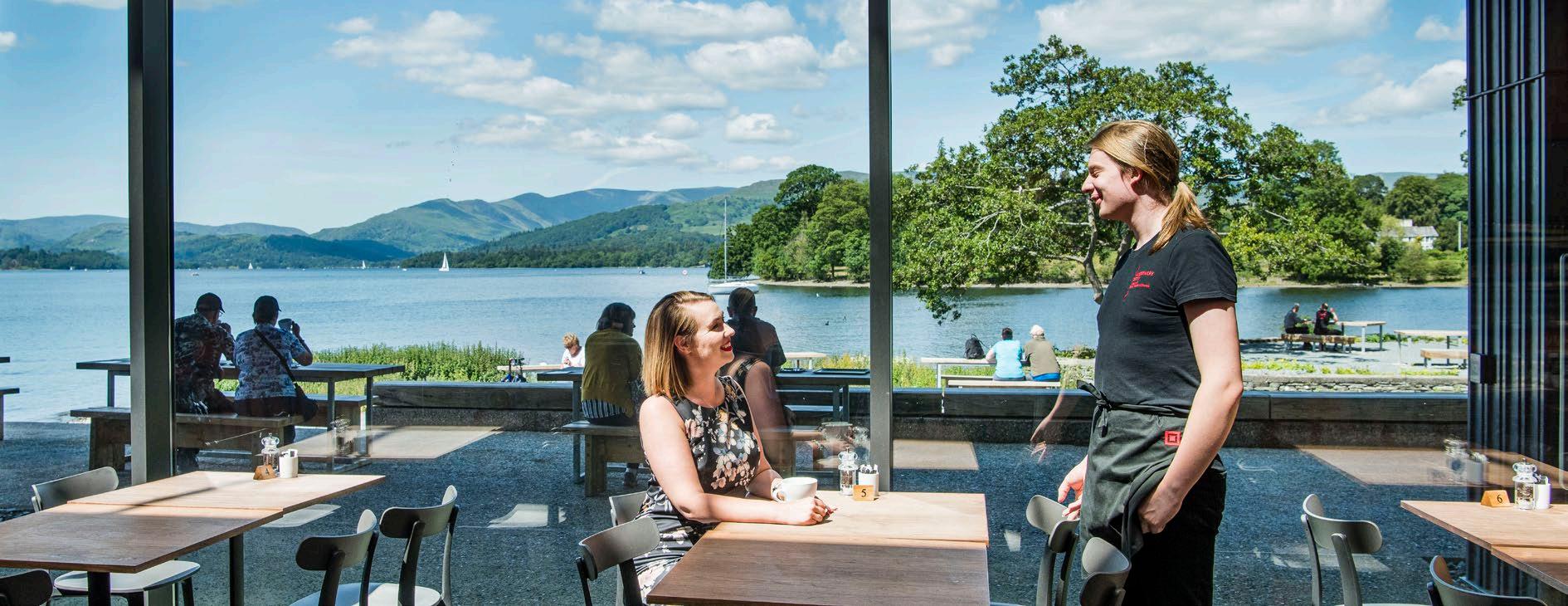
27
26 In 2021 Friends of the Lake District commissioned Keep Britain Tidy to carry out a research report “Understanding Littering and Related Anti-Social Behaviour in the Lake District ”, May 2021. This covered behaviour in the post-lockdown period May 2020 to May 2021 and so is not a current baseline.
There is some evidence at present on how much the Lake District Foundation receives for instance.
Windermere Jetty Museum
47 A DESTINATION MANAGEMENT PLAN FOR CUMBRIA: 2024 TO 2030
©Lakeland Arts
4.3 OBJECTIVE – ENSURING AN INCLUSIVE & ACCESSIBLE VISITOR DESTINATION
This objective comprises two strands, set out in Table 4.3 below, including how success will be measured.
Table 4.3: OBJECTIVE – ENSURING AN INCLUSIVE & ACCESSIBLE VISITOR DESTINATION
SUB-OBJECTIVE MEASURES OF SUCCESS AMBITION (BY 2030)
3A: Ensure Cumbria’s infrastructure and welcome is accessible to all
Visitor assessment of adequacy of accessibility offer/facilities
Number of Changing Places28 toilet/changing facilities in Cumbria
Increase number of “Miles without Stiles” routes in Cumbria
No baseline available, to be developed (e.g. via Visitor Survey)
Currently 19, aim to double by 2030
Currently 53 in Cumbria (51 in LDNP and 2 in YDNP). Seek to develop more outside Lake District
3B: Ensure Cumbria’s product and welcome is inclusive for all visitor groups
See 1E in Table 4.1
No baseline available, to be developed (e.g. via Visitor Survey)
Note: An alternative way of measuring our ambition would be the share of visitors who come from a greater range of diverse backgrounds and/or have accessibility challenges. This could be measured by the biannual Visitor Survey, although sample sizes are small.
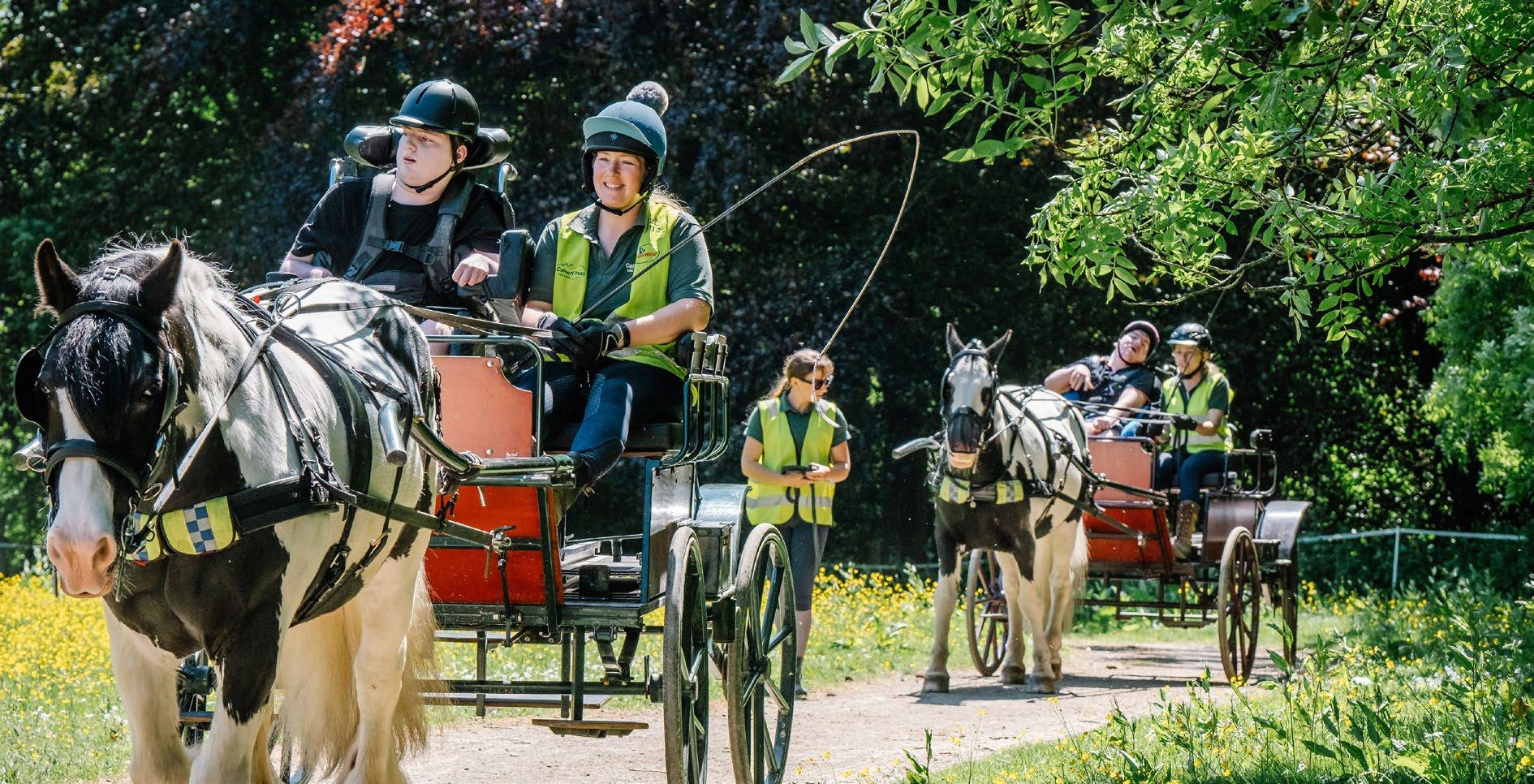
28 Sourced from map at www.changing-places.org
Calvert Stables, Keswick part of Lake District Calvert Trust
A DESTINATION MANAGEMENT PLAN FOR CUMBRIA: 2024 TO 2030 48
©Steve Barber
4.4 OBJECTIVE – SUPPORTING THE SECTOR TO DELIVER WORLD CLASS EXPERIENCES
This objective has six key strands which largely build on - and are a continuation of - the past focus of partners involved in the visitor economy. They are set out in Table 4.4, including how success will be measured. There is some overlap with the objective covering transport and reducing the environmental impacts of the visitor economy.
SUB-OBJECTIVE MEASURES OF SUCCESS AMBITION (BY 2030)
4A: Develop better infrastructure and attract investment in the quality and range of product
4B: Attract, retain and develop a skilled and committed workforce
Levels of investment in the tourism product in Cumbria
4C: Support businesses to move to more environmentally sustainable operations
4D: Support businesses to adapt, innovate and achieve excellence
Reduction in the proportion of tourism businesses reporting significant staff and skills shortages
There is no readily available baseline, so no specific ambition is proposed.
In October 2023, 48% of tourism business reported recruitment as a significant problem29. Our ambition is to reduce this proportion by a quarter to a half by 2030 (to 24% to 36%).
Reduction in the proportion of tourism business identifying lack of affordable housing as a significant problem
Increase in number of businesses reporting progress
Increase the number of Cumbria’s tourism businesses who are self-reported as “innovation active”
In October 2023, 66% of tourism business reported this as a significant problem30. Reduce this proportion by a quarter by 2030, to reach a rate no worse that pre-Covid.
No baseline available, to be developed (e.g., via Business Tracker)
In 2020, 56% of visitor economy sector businesses reported some form of recent innovation31
29 Cumbria Tourism Business Tourism Tracker, October 2023, with a further 31% reporting a slight problem. Note: The proportion in Autumn 2019, pre-Covid, was the same (48%) with a further 29% recording it as a slight problem. The sample sizes in the two years were 100 to 130 but not necessarily the same businesses.
30 Cumbria Tourism Business Tourism Tracker, October 2023, with 20% stating it was a slight problem. Note: in Autumn 2019, pre-Covid, the portions were 44% (significant problem) and 29% (slight problem).
31 Cumbria Business Survey 2020. The question was: “In the last three years, has your business introduced any new or significantly improved… goods/products” (30% said yes), “services” (35%), or “processes or working practices” (45%). The sample size for visitor economy businesses was 335.
Table 4.4: OBJECTIVE – ENSURE CAPACITY TO DELIVER BY SUPPORTING THE SECTOR
49 A DESTINATION MANAGEMENT PLAN FOR CUMBRIA: 2024 TO 2030
SUB-OBJECTIVE MEASURES OF SUCCESS AMBITION (BY 2030)
4E: Ensure digital connectivity (both mobile and fixed line) is fit for the future
Reduction in the areas of Cumbria with poor mobile 4G/5G coverage
4F: Ensure provision of adequate and consistent visitor services across Cumbria
4G: Ensure a joined-up approach to enable a resilient visitor economy
Levels of visitor satisfaction Number of reports/complaints from visitors
In December 2023, outdoor 4G coverage from at least one operator was available to 90.3% of Cumbria with coverage from all 4 network operators available to 64.1%.
By 2025, it is estimated that outdoor 4G coverage from at least one operator will be available to 97% of Cumbria with coverage from all 4 network operators available to 80%. The target for 2025 is less than 1% and less than 5% respectively32
No baseline at present TBC. Some data from visitor perception survey but small samples
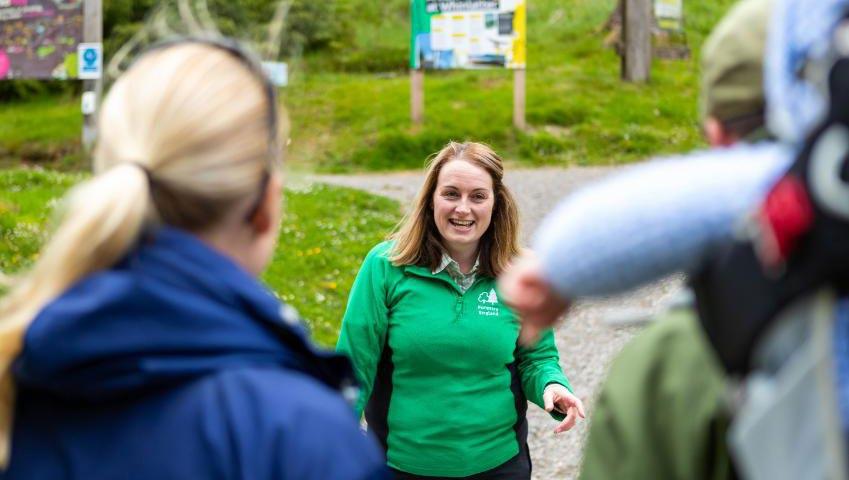 Table 4.4: OBJECTIVE – ENSURE CAPACITY TO DELIVER BY SUPPORTING THE SECTOR
32 Source: Cumbria Digital Infrastructure Strategy 2020-2025, 2022-2023 Update
Whinlatter Forest
Table 4.4: OBJECTIVE – ENSURE CAPACITY TO DELIVER BY SUPPORTING THE SECTOR
32 Source: Cumbria Digital Infrastructure Strategy 2020-2025, 2022-2023 Update
Whinlatter Forest
A DESTINATION MANAGEMENT PLAN FOR CUMBRIA: 2024 TO 2030 50
©University of Cumbria and Forestry England

OUR PLAN OF ACTION 5
51
Duke of Portland Boathouse, Ullswater
The following plan of action captures the main actions underway - or planned - that will support the objectives and vision of the DMP. The column “lead” for the DMP sets out the organisation(s) that partners
have agreed will have lead responsibility for the action. However, it is important to note that this responsibility is one of oversight on progress on the particular action area not, in many cases, direct delivery of activity.
1.1 Invest in enhancing the quality of place in under visited locations
1A Cumberland and Westmorland and Furness Councils
1.2 Invest in enhancing the visitor product and experiences in under visited locations
1A 1D Cumberland and Westmorland and Furness Councils Tullie House, Eden Project, Whitehaven Harbour Commissioners, North Pennines National Landscape
• Major investments are planned and, in some cases, are underway in Barrow, Cleator Moor, Carlisle, Maryport, Millom, Whitehaven and Workington - supported by a total of around £130 million of Town Deal and Future High Street Fund.
• A significant part of the planned investments is aimed at improving town centres and developing new facilities and attractions (for the local population and visitors alike).
• In addition, there is a further up to £18 million of Borderlands Place programme investment planned for Dalton-inFurness, Egremont, Longtown, Penrith, Ulverston and Wigton.
• Kendal has just received £13.5 million for the Heart of Kendal project from the Levelling Up Fund.
• Support planned visitor product development in Carlisle (Tullie House, Phases 2 and 3 of Project Tullie), Barrow (Shipyard Town at Barrow Dock Museum), new Iron Lines trail and visitor centre (Millom), improved Wave Centre, new Maryport Maritime Museum, restoration and renovation of the former Carlton cinema into an arts, events and performance centre (all Maryport), the Edge visitor facility by Whitehaven Harbour.
• Connecting Cumbria’s Hidden Coast arts trail (funded by Coastal Communities and Sellafield).
• Development of 359 km (223 miles) multi-day walking route Roof of England Walk: a journey around the North Pennines (North Pennines National Landscape). continued
Ref. Name of action area Main objective Other objectives Lead for DMP Others involved Description/elements
A DESTINATION MANAGEMENT PLAN FOR CUMBRIA: 2024 TO 2030 52
1.2 Invest in enhancing the visitor product and experiences in under visited locations
1A 1D Cumberland and Westmorland and Furness Councils Tullie House, Eden Project, Whitehaven Harbour Commissioners, North Pennines National Landscape
• Delivery of the Coast to Coast upgrade and completion of the King Charles III Coastal Path in Cumbria.
• Build on opportunity offered by Eden Morecambe to link visitors to parts of Cumbria.
• Engage with Local Plans on policy support for investment in visitor facilities and offer.
• Identify opportunities for new ‘national’ draw attraction to catalyse reasons to visit Cumbria’s coastal areas.
1.3 Funded and coordinated marketing and promotion of under visited locations
1A 1D CT Cumberland and Westmorland and Furness Councils, Hadrian’s Wall Partnership, North East DDP, North Pennines National Landscape
• Develop Carlisle as a leading cultural and heritage citydestination offering something different from the rest of Cumbria (Roman heritage) and building on the investment plans for the city (also linked to Hadrian’s Wall project) including the upgrade of Tullie House Museum.
• The Hadrian’s Wall and the Wider Roman Frontier 10-year Investment Programme funded by Borderlands, of which £8.5 million will be spend in Cumbria.
• Support product and business development and raise awareness of Barrow as a destination.
• Maximise resident community and Friends and Family market.
• Aligned to SVMG, targeted marketing of less well know and visited areas, as well as those with capacity.
• Delivery of a range of SPF funded marketing and business support projects across Cumberland and Westmorland and Furness areas.
• Further development of CCR200.
• Attract and Disperse campaigns.
action
Other objectives Lead for DMP Others involved Description/elements
Ref. Name of
area Main objective
A DESTINATION MANAGEMENT PLAN FOR CUMBRIA: 2024 TO 2030 53
1.4 Support and extend programme of events and festivals outside peak periods and in less well visited parts
1B 1D SVMG CT, Cumberland and Westmorland and Furness Councils, CLEP and its successor body, both National Parks, cultural and arts sectors
• Build on the success of creative/cultural and outdoor events; develop a Cumbria-wide events strategy to support priorities.
• Build on the work already underway and planned (e.g. Taste Cumbria Food Festival in Cockermouth and other well-established festivals including: Cumbria Dark Skies Festival, Yorkshire Dales Dark Skies festival, the Winter Droving in Penrith, Carlisle City of Lights, Keswick Mountain Festival, Kendal Mountain Festival, Lake District Summer Music Festival, Borderlines Carlisle Book Festival, Christmas Markets, Yorkshire Dales Cheese Festival).
• Aerial festival: international multi-arts biennale for Cumbria.
1.5 Identify opportunities to develop more wet weather activities and attractions to support tourism in off-peak periods
1B 1D CLEP and its successor body CT, Cumberland and Westmorland and Furness Councils, Forestry England, LDNPA, YDNPA, private operators, North Pennines National Landscape
• New Observatory offer.
• International Dark Sky Reserve designation for North Pennines National Landscape.
• Yorkshire Dales National Park International Dark Sky Reserve
www.yorkshiredales.org.uk/park-authority/looking-after/ dark-sky/.
• Others to be identified.
1.6 Funded and coordinated marketing and promotion of Cumbria in off-peak periods
1B 1D CT
Visitor economy businesses
• Identify opportunities to amplify existing Winter Campaign to increase awareness of Cumbria’s off-season appeal and, where appropriate, specifically target key markets.
Other objectives Lead for DMP Others involved Description/elements
Ref. Name of action area Main objective
A DESTINATION MANAGEMENT PLAN FOR CUMBRIA: 2024 TO 2030 54
1.7 Funded and coordinated marketing and promotion of Cumbria to international markets
1C CT International Partnership Cumberland and Westmorland and Furness Councils
Business Sector
Visit England/ VisitBritain
• Additional funding to be sought to support coordinated marketing and promotion of Cumbria to identified overseas markets.
1.8 Develop a strategic approach to promote Cumbria to film and TV productions
1.9 Develop and implement a Cumbria food and drink strategy
1C 1D SVMG Cumberland and Westmorland and Furness Councils, CT
1D CT Cumberland and Westmorland and Furness Councils, CLEP and its successor body
• In many other parts of the UK, there are local authority film offices to help engagement and facilitation. This does not currently exist in Cumbria and could be explored.
• Capitalise on reputation for food and drink, building on Michelin Star success to develop Cumbria as a foodie capital (more stars than any other county) and support all seasons, all weather, all areas (also links to events and producers).
• Explore potential of an OctoberFest.
• Working with YDNPA developed local food toolkit.

Other
Lead for DMP Others involved Description/elements
Ref. Name of action area Main objective
objectives
Talk and Tasting at Grasmere Gingerbread®
A DESTINATION MANAGEMENT PLAN FOR CUMBRIA: 2024 TO 2030 55
©Grasmere Gingerbread®
1.10 Roll out a Cumbria motorhome strategy
1A 1D, 1E SVMG CT, Cumberland and Westmorland and Furness Councils, CLEP and its successor body, National Parks
• Roll out a Cumbria Motorhome strategy, building on the Cumbria Coastal Route (CCR200) work, to manage the opportunities and challenges created by the growth of the motorhome market. This will cover:
◦ Elevating the motorhome community’s visitor experience, including accessibility for those visitors with varying physical and non-physical impairments.
◦ Minimising the environmental impacts and creating a more sustainable travel experience.
◦ Harnessing motorhome tourism and helping motorhome users to actively support the local economy, recognising that motorhomes have the ability to reach remote locations.
◦ Identifying the “invest to save” infrastructure investment required to adapt to the demands and mitigate the impacts.
◦ Realising the full economic potential and income generation.
1.11
1.12
1A 1E CT
Cumberland and Westmorland and Furness Councils, tourism businesses
1B 1A SVMG CT, Cumberland and Westmorland and Furness
Councils, CLEP and its successor body, National Parks
• Extend the CCR200 route concept beyond motorhomes as a rail, bus and active travel route exploring the rich heritage and culture of areas outside of the National Park linking Morecambe Bay, the West Coast and Hadrian’s Wall with spurs off to the Yorkshire Dales through Kirby Lonsdale, Sedbergh, etc.
• Work to publicise and raise awareness of Cumbria and the visitor and leisure opportunities on people’s doorsteps, as well as the wider benefits of the visitor economy to local communities.
Ref. Name of action area Main objective Other objectives Lead for DMP Others involved Description/elements
Develop the CCR200 (Cumbrian Coastal Route) concept further
Increase local community awareness and use of and pride in visitor facing services
A DESTINATION MANAGEMENT PLAN FOR CUMBRIA: 2024 TO 2030 56
1.13 Research into new market opportunities
1E
CT VisitEngland, tourism operators
• Draw on existing and new research to identify new market opportunities.
• Review existing product and offers against these opportunities.

Name of action area
objective Other objectives Lead for DMP Others involved Description/elements
Ref.
Main
A DESTINATION MANAGEMENT PLAN FOR CUMBRIA: 2024 TO 2030 57
Fish & Chips on Silloth Green, Solway Coast
2.1 Enable more visitors to arrive in Cumbria by public transport
2A
2B
2B Cumberland and Westmorland and Furness Councils and transport providers CT, tourism operators, train operating companies (Avanti, Northern and TPE), bus operating companies, CLEP and its successor body, other business body representatives e.g. Chamber of Commerce, FSB, CBI, LDNPA
• Support investment to increase capacity on the Lakes Line railway connecting Kendal/Oxenholme (and therefore, the West Coast mainline) to Windermere and develop the role of Windermere Station as a key gateway.
• Support investment in increasing capacity and reliability on the Cumbria Coastal Line connecting Carlisle to Barrow.
• Invest in key public transport gateways to Cumbria and integrated onward connections (Kendal/Windermere, Penrith, Carlisle etc).
• Support initiatives for multi-modal ticketing and enhanced connectivity from the West Coast Mainline between Penrith and Keswick and from Oxenholme and Windermere Stations. (Stagecoach lead).
• Support initiatives to increase accessibility and amenities at stations and hubs, including accessibility improvements at Staveley, Oxenholme, Ulverston and Workington, plus amenity and integration improvements at Penrith station (Also links to Action 3.3)
NB: The role of delivering the aspirations in the Cumbria Transport Plan and Transport for the North in lobbying to improve public transport is critical. It is important that leisure use is identified within the business cases.
• Promote and market public transport routes and opportunities to visit Cumbria.
• Develop special integrated travel packages and promotions.
• Work to improve the frequency and reliability of bus services in Cumbria, in line with the Cumbria Bus Service Improvement Plan.
• Support investment in an electric bus fleet for Cumbria.
• The Cumbria Transport Plan and Transport for the North lobbying is critical. It is important that leisure use is identified within the business cases.
Name of action area Main objective Other objectives Lead for DMP Others involved Description/elements
Ref.
2.2 Market and promote visitor travel to Cumbria by public transport
2A
2B CT Train and bus operating companies, tourism businesses, LDNPA
2.3 Sustain and improve public transport infrastructure within Cumbria for visitors/ communities
2A Cumberland and Westmorland and Furness Councils, LDNPA, YDNPA Public transport providers, Zero Carbon Cumbria Partnership
A DESTINATION MANAGEMENT PLAN FOR CUMBRIA: 2024 TO 2030 58
2.4 Develop an integrated end-to end transport system for visitors with a proactive approach to parking provision and traffic management, to support modal shift
A DESTINATION MANAGEMENT PLAN FOR CUMBRIA: 2024 TO 2030
2B 2A, 2F Cumberland and Westmorland and Furness Councils
Both National Parks, CT, transport operators, major tourism businesses.
TfN, SVMG
• Support work to link and co-ordinate timetables (trains, boats, buses, etc).
• Work with Transport for the North to support the development of proposals for integrated ticketing.
• Link and join Coast to Coast and Coastal Paths to railway stations and routes.
• Explore innovative approaches to visitor travel by delivering pilots for transport measures that reduce car dependency in Wasdale, Langdale, Ullswater and Hawkshead to support a modal shift in travel.
• Invest in better visitor movement management and car parking in main visitor locations and electronic parking signage in most popular destinations.
• Take a proactive approach to temporary parking provision and management in key locations to support businesses and communities as well as visitor experience.
(Also see Action 2.6)
2.5 Develop a suitable EV charging infrastructure for visitors in Cumbria and en route to Cumbria 2B 2A Cumberland and Westmorland and Furness Councils, LDNPA
Electricity North West, private car park operators
2.6 Ensure planning to reduce traffic issues and minimise disruption at peak periods
2F Cumberland Westmorland and Furness Councils, Highways England
• Support public sector led investment in EV charging points that cater for the visitor economy, building on the recently announced Local Electric Vehicle Infrastructure (LEVI) projects in Cumberland and Westmorland and Furness.
• Support private provision of EV charging points at shops and hotels etc.
• Ensuring adequate grid capacity to support charging points and access to Wi-Fi.
• Lobby for adequate EV charging infrastructure on routes to Cumbria (M6/A66, M74 etc).
• Coordinate roadworks, temporary car parking and enforcement of parking rules and other traffic disruption to minimise congestion and disruption in busy periods at key pinch point locations. (Also see Action 2.4)
of action area Main objective Other objectives Lead for DMP Others involved Description/elements
Ref. Name
59
2.7 Further expand and develop the network of cycling routes across the county
2.8 Place to Plate - develop local supply and sourcing programme
2.9 Create a responsible tourism education strategy
2B 2F Cumberland and Westmorland and Furness Councils, LDNPA, YDNPA
2.10 Programme to teach and inspire young people about the countryside and environment awareness
2C 4C CT Food producers, hospitality sector, CaFS
2D 2E, 2F SVMG LDNPA, YDNPA, Visitor economy businesses, Lake District Foundation
• Develop high quality active travel measures including: developing cycle corridors/spurs and set out in Cumbria Transport Infrastructure Plan, Borderlands See More Lake District Project (providing a package of infrastructure improvements between Grasmere and Keswick), the Heart of the Lakes Active Travel Infrastructure Strategy, and Local Cycling and Walking Improvement Plans (LCWIPs).
• Build on existing supply chains and networks and initiatives such as the Cumbria and Yorkshire Dales Food Maps.
2.11 Review opportunities for raising funding to support the vision
2D 2F CT
Cumberland and Westmorland and Furness Councils, local schools, outdoor education sector providers in Cumbria and partners
2E 2D CT and Lake District Foundation LDNPA, YDNPA, National Trust
• Educate visitors, including promoting the appreciation of our countryside and culture.
• Develop and enhance provision of heritage and skills-based visitor activity.
• Cumbria has a very strong outdoor education sector and a wide range of providers and facilities.
• Support programmes aimed at schools/education sector to connect with countryside and environment – both from within Cumbria and elsewhere.
• Encourage and support increased voluntary visitor giving.
• Investigate the potential for other funding models for the Lake District/Cumbria.
• Lobby for greater recognition to reflect the cost of supporting infrastructure and services for visitors in local authority grant funding assessments methodology.
• Lobby for greater resources to authorities responsible for maintaining visitor facilities (building on the recommendations of the Glover Review).
Main objective Other objectives Lead for DMP Others involved Description/elements
Ref. Name of action area
A DESTINATION MANAGEMENT PLAN FOR CUMBRIA: 2024 TO 2030 60
2.12 Invest in renewal and improvement of landscape enjoyed by visitors (inc. Fix the Fells)
2.13 Improve the environment of our waterways and coast
2E 4C Lake District Foundation Friends of the Lake District, LDNPA, YDNPA, National Trust
• Support continuation and expansion of Fix the Fells partnership and activity.
• Explore other areas for development of support programmes involving volunteers, visitor giving and other funding.
2E 4C Environment Agency Cumberland and Westmorland and Furness Councils, Love Windermere Partnership, Morecambe Bay Partnership, Rivers Trusts
• Continue the work of the Love Windermere Partnership
• Community litter picking and beach care
• Other actions to be identified.
2F 1A, 2B
Deliver the SVMG Strategy:
• Refresh double yellow lines where required and make permanent temporary traffic regulation orders (TROs)
• Ensure appropriate signage is still in place at passing places and consider TROs at recurring problem locations
• Ensure parking enforcement
• Further develop and promote bike hire
• Develop shuttle buses in Buttermere and Wasdale
• Place-based approaches to co-ordinated visitor management are being piloted and developed in Langdale and Ullswater
• Audit and review brown sign provision.
Ref. Name of action area Main objective Other objectives Lead for DMP Others involved Description/elements
2.14 Active destination management in key locations
Strategic Visitor Management Group (SVMG)
A DESTINATION MANAGEMENT PLAN FOR CUMBRIA: 2024 TO 2030 61
2F CT
SVMG
Cumberland and Westmorland and Furness Councils, LDNPA, transport operators
• Coordinate approach to data gathering and intelligence to inform visitor management, intervention and marketing (including real-time data about who, where from, what doing, etc)
• Work under the Borderlands 5G Innovation Regions Windermere 5G ferry pilot will test opportunities for real-time information about this transport link and capacity in surrounding car parking areas.
• An evidence-led and targeted approach to visitor safety and management, to reduce pressure on services including police, NHS and Mountain Rescue (including Lakes Volunteers).

DMP
Ref. Name of action area Main objective Other objectives Lead for
Others involved Description/elements
2.15 Data sharing and real-time information on visitors
2.16 Visitor safety management strategy
2F
Stagecoach 78 Service travelling from Seatoller to Keswick
A DESTINATION MANAGEMENT PLAN FOR CUMBRIA: 2024 TO 2030 62
©Richard Burgess
3.1 Better provision of consistent and comprehensive information on accessibility for visitors
3.2 Awareness raising and practical advice about accessibility market and needs
3.3 Improve accessible and inclusive facilities across the visitor economy infrastructure
3.4 Develop a better evidence base on needs and opportunities from new, inclusive visitor markets
3.5 Develop a strategic approach to ensure the delivery of Cumbria as an inclusive destination
3A 1E Accessible Cumbria Partnership
3A 1E Accessible Cumbria Partnership
3A 1E Accessible Cumbria Partnership Cumberland and Westmorland and Furness Councils
• Consolidate accessibility information and present it in an easily useable format on one platform, to raise the profile of the products available.
3.6 Support “warm welcome” programmes to make all visitors welcome
3B 1E CT
Cumberland and Westmorland and Furness Councils, both National Parks
3B 1E LDNPP “Park for All” Group CT, Cumberland and Westmorland and Furness Councils, YDNPA
• Educate and inform local businesses about the value of the Purple Pound and how to meet the needs of this market.
• Training for visitor economy businesses.
• Encourage investment by visitor economy businesses in improved accessibility facilities.
• Maintain existing - and create new - Miles without Stiles routes.
• Encourage access to grant funding, to increase the number of Changing Places facilities in Cumbria available for visitors.
• Build on our natural and cultural heritage assets, developing Cumbria’s reputation as an inclusive destination with accessible adventures for all. (Also see Action 1.13)
3B 1C, 1E CT Chamber of Commerce, Cumberland and Westmorland and Furness Councils
• Increase awareness of the needs and requirements of a diverse audience of people and seek to deliver their priorities over the next five years.
• Increase support to help underserved groups and people to access the outdoors and promote its health and wellbeing benefits.
• Improve visitors’ understanding of how to care for the Lake District and its communities (and other parts of Cumbria).
• Signpost businesses to existing “welcome” programmes.
• The longer ambition is to develop fully funded programmes.
Name
action area Main objective Other objectives Lead for DMP Others involved Description/elements
Ref.
of
A DESTINATION MANAGEMENT PLAN FOR CUMBRIA: 2024 TO 2030 63
4.1 Support local businesses and organisations to access grant and other funding opportunities
4A 1A, 1B, 1D, 1E CT CLEP and its successor body, Chamber of Commerce, Cumberland and Westmorland and Furness Councils
• Work with visitor economy businesses to raise awareness of funding and other support opportunities (including new UK SPF and Rural England Prosperity Fund sources).
• Provide signposting to funding and other support opportunities inside and outside Cumbria.
4.2 Help attract distinctive external investment into the sector
4A 1A, 1B, 1D, 1E
Cumberland and Westmorland and Furness Councils CLEP and its successor body, CT as LVEP, tourism businesses
• Promote Cumbria and its investment opportunities to potential investors (in accommodation, F&B, visitor attractions/services etc) – however focus on investors who buy into the vision for Cumbria and are rooted in the place.
• Work with DCMS sponsored funding bodies to secure strategic funding of DMP priorities, e.g. Arts Council, Heritage Fund, Sport England.
• Support a refresh of existing cultural, heritage and outdoor attractions to ensure they remain of the highest quality.
4.3 Review our affordable visitor accommodation offer for young people (and others)
4.4 Support skills development within the sector
4A 1E CT University of Cumbria, LDNPA
• Commission a study to audit and review provision of hostel style accommodation and learn from innovation in competitor locations.
4B CLEP and its successor body CT, Cumbria Chamber of Commerce, FE Colleges, University of Cumbria, visitor economy businesses
• Roll out of LSIP
• Make visitor economy businesses more aware of training opportunities - developing standards for training and skills development and promoting modern apprenticeships.
• Explore potential for a self-funded recruitment agency for the sector in Cumbria to recruit UK and international staff.
Main objective Other objectives Lead for DMP Others involved Description/elements
Ref. Name of action area
MANAGEMENT PLAN FOR CUMBRIA: 2024 TO 2030 64
A DESTINATION
4.5 Continue to raise awareness of career paths within the sector
4.6 Raise awareness of Cumbria as a place to live and work
4B
4.7 Develop and extend worker transport initiatives
4B
CT Visitor economy businesses, Cumbria Careers Hub
CLEP and its successor body CT, Cumberland and Westmorland and Furness Councils, private sector businesses
• Continued implementation of CT Workforce Strategy.
• Welcome to Work strategy for hospitality sector.
• Hosting visits for schools and colleges
• Coordinated promotion of training, jobs and careers through development of Cumbria Tourism Talent Hub.
4.8 Invest in new and expanded accommodation for workers in the sector
4B
Cumberland and Westmorland and Furness Councils CT, CLEP and its successor body, visitor economy businesses
• Work cross county to promote Cumbria as a place to live, work, study and invest – focusing specifically on the opportunities within the visitor economy.
4B
Cumberland and Westmorland and Furness Councils LDNPA, CT, CLEP and its successor body, visitor economy businesses
• There is current funding for CT to connect businesses, transport funders and transport provision on awareness of routes and identify gaps.
• Increase affordable and key worker housing provision within National Park areas (including the proposed Windermere Gateway scheme) and in areas that can serve the LDNPA area (e.g. potential new housing in Barrow).
• Review of controls on short-term lets and loss of longerterm rentals market.
• Develop Hospitality Accommodation Hubs close to centres of work, with good transport links, e.g. in Kendal.
Name of action area Main objective Other objectives Lead for DMP Others involved Description/elements
Ref.
A DESTINATION MANAGEMENT PLAN FOR CUMBRIA: 2024 TO 2030 65
4.9 Support tourism businesses to develop ways to increase their positive impact on the environment
4C 2D, 2E CT
4.10 Deliver a visitor economy innovation programme
4.11 Develop a hospitality school of excellence
4D 4C CT
CLEP and its successor body, Cumberland and Westmorland and Furness Councils, both National Parks, Lake District Foundation, National Landscapes, CaFS, VisitEngland, Morecambe Bay Partnership
CLEP and its successor body, Cumbria Chamber of Commerce
• Work with partners to signpost and coordinate the delivery of specific projects for the sector, such as the roll out of the ‘Guardians of Grub’ scheme (reducing food waste) and reducing harm from septic tanks.
• Develop and signpost resources such as Sense of Place toolkits, food toolkits and Dark Skies to encourage businesses to support local produce and producers/makers, and change their lighting if they are involved in Dark Sky events/festivals. (Also links to Actions 2.8 and 1.8).
4.12 Roll out high-quality digital infrastructure to support mobile and fixed location connectivity for all visitors
4D 4B CLEP and its successor body CT, visitor economy businesses, University of Cumbria, FE Colleges
4E
• Build on support available for visitor economy businesses via UK SPF and Rural England Prosperity Fund, until the end of 2024/25.
• Support businesses to increase rates of innovation (in and for the visitor economy).
• Support new start-ups offering value added services and activities, and signpost to grant funding.
• Develop a School of Excellence for the sector (aimed at the management of businesses).
Connecting Cumbria Both National Parks
• Continue the delivery of the Cumbria Digital Infrastructure Strategy 2020-2025 and contribute to the development of follow on strategies.
• All DMP projects and programmes should develop an outline digital strategy to clarify their needs and ambitions for coverage – this work will be used to further enhance the Cumbria Digital Infrastructure Strategy and follow on programmes.
action
objective Other objectives Lead for DMP Others involved Description/elements
Ref. Name of
area Main
MANAGEMENT PLAN FOR CUMBRIA: 2024 TO 2030 66
A DESTINATION
4.13 Review and develop a joined-up strategy for toilet, waste and parking provision
4.14 Public realm review for key visitor destinations across Cumbria
4.15 Enhance data sharing and intelligence gathering
4F 2F, 2D, 1E SVMG
• Review need for appropriate toilet provision in main visitor areas.
• Plan to upgrade provision where necessary.
• Black and grey waste provision for motorhomes
4F Cumberland and Westmorland and Furness Councils LDNPA, YDNPA, locality boards, parishes Ongoing
4G 2F CT Cumberland and Westmorland and Furness Councils, LDNPA, CLEP and its successor body
• Continue to share data and intelligence on the sector.
• Explore opportunities from new real time data (and other data) that VisitEngland may make available to LVEPs in a cost-effective way.

action area Main objective Other objectives Lead for DMP Others involved Description/elements
Ref. Name of
The Yan at Broadrayne
A DESTINATION MANAGEMENT PLAN FOR CUMBRIA: 2024 TO 2030 67
©Paul Hearne
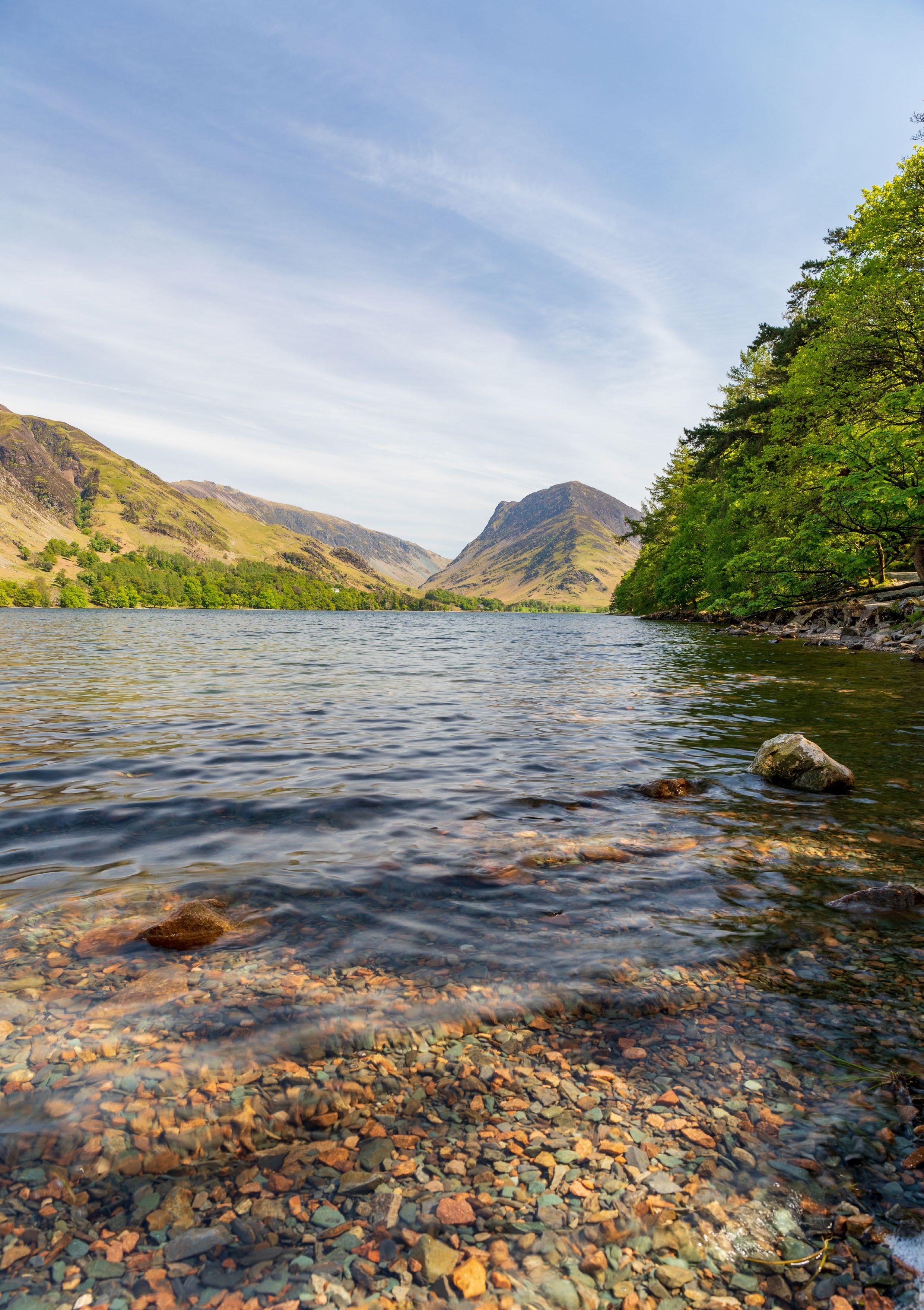
MANAGING AND MONITORING THE DMP 6
68
Buttermere
MANAGING THE DMP
The actions and priorities in this DMP will be integrated into the strategic priorities of partners and will ensure a joined-up approach to activity across Cumbria.
CT in its role as the LVEP will lead on the DMP. The DMP Steering Group set up to lead the production of this DMP will continue to operate; it will be responsible for monitoring progress on the actions and outcomes, and reporting this to key partners and Cumbria Tourism’s Board.
Each action/activity within this action plan is led, managed and developed. The organisation cited in the ‘lead’ column will be responsible for overseeing delivery, progress and reporting to the DMP Steering Group. The lead partner(s) is not necessarily involved directly in delivery, but rather, has an oversight of progress.
The action plan is designed to be fluid and can - and will - be updated at any stage if necessary.
MONITORING THE DMP
The DMP Steering Group and Working Groups will meet quarterly to review progress and discuss implementation via a Monitoring Framework.
There will be an annual review of progress on key actions and metrics.
HOW WE WILL WORK TOGETHER
Collaboration and partnerships will be needed to work together to maximise the impact of individual actions.
Cumbria Tourism (CT) –the Local Visitor Economy Partnership (LVEP)
Cumberland Council
Westmorland and Furness Council
Lake District National Park Authority (LDNPA)
Yorkshire Dales National Park Authority (YDNPA)
Cumbria Local Enterprise Partnership (CLEP)
Hadrian’s Wall Country – World Heritage Site
Table 6.1: Current Membership of the DMP Steering Group
69 A DESTINATION MANAGEMENT PLAN FOR CUMBRIA: 2024 TO 2030
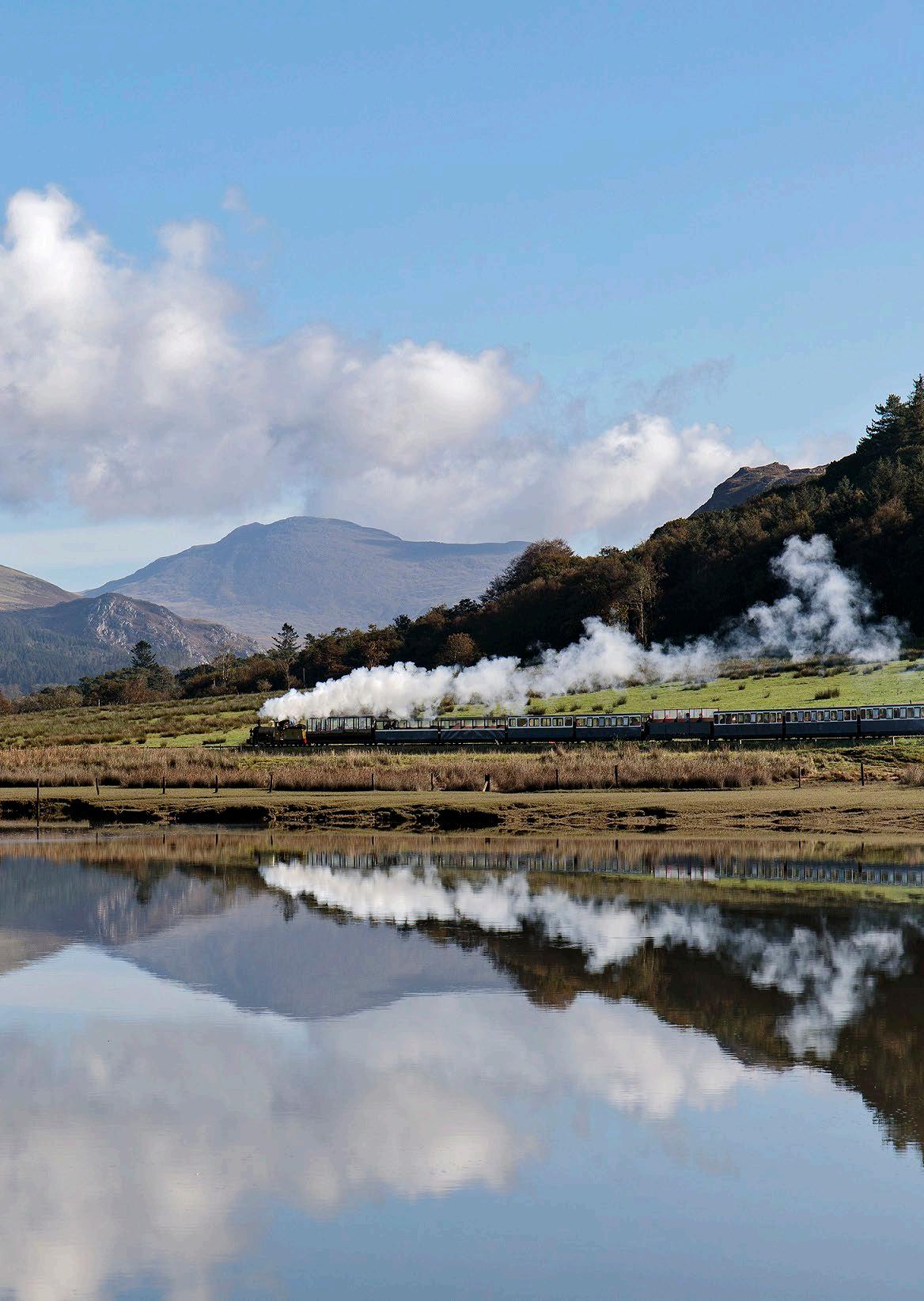
APPENDIX A � STRATEGIC ALIGNMENT 7
70
River Mite on Barrow Marsh
©Ravenglass and Eskdale Railway, Mark Fielding
National Plans and Policies
Tourism Recovery Plan (2021) (which supersedes Visit Britain/Visit England 5-year Strategy 2020-2025)
How the DMP aligns and contributes …
Sets out the role that the UK government will play in assisting and accelerating the tourism sector’s recovery from Covid-19. Has five aims of which the DMP addresses four:
(1) Recover domestic overnight trip and inbound visitor numbers and spend. (2) Ensure that the sector’s recovery benefits every nation and region, with visitors staying longer, growing accommodation occupancy rates in the off-season and high levels of investment in tourism products and transport infrastructure. (3) Build back better with a more innovative and resilient industry, maximising the potential for technology and data to enhance the visitor experience. (4) Ensure the sector contributes to the enhancement and conservation of the country’s cultural, natural and historic heritage, minimises damage to the environment and is inclusive and accessible to all.
Levelling Up Supports Investment in Towns Deal, Future High Street Funds and Levelling Up Fund projects in Cumbria. The DMP provides an opportunity to capitalise on these investments to support wider economic prosperity across Cumbria.
World Heritage Site UNESCO Recommendations
CLEP Local Industrial Strategy (2019)
At the time of the inscription of the WHS status for the Lake District UNESCO made 9 recommendations. These are addressed in the LDNPP Management Plan and have fed into consideration of this DMP.
Recognises the key importance of the visitor economy and the natural assets on which this was built. Sought to see cross promotion of Cumbria for visitors and to come and live /work here. Use of Lake District WHS brand to sell food and other products - valuing our cultural landscape.
Covid Recovery Plan: Restart, Reboot, Rethink – Planning for Cumbria’s Economic Recovery (2020)
Cumbria ‘The Natural Capital of Creativity and Culture’, Creative And Cultural Strategy (2020)
Two of the six “reboot” priorities linked to visitor economy:
(1) The New Visitor Experience – capturing the changes in sustainable visitor behaviour by offering a world class experience to a wide range of markets. (2) Cumbria – The UK’s Natural Capital – promoting and using the economic benefits which flow from having the most protected landscape in England.
Highlights the interconnections between the visitor economy and the cultural and creative offer in Cumbria.
Table 7.1: Strategic Alignment
71 A DESTINATION MANAGEMENT PLAN FOR CUMBRIA: 2024 TO 2030
National Plans and Policies
Lake District Local Plan 2020 to 2035 (2022)
Lake District Partnership’s Management Plan 2020-2025 (2021)
How the DMP aligns and contributes …
The Plan’s 2030 Vision for the English Lake District is that it will be an inspirational example of sustainable development in action. This encompasses: (1) A place where its prosperous economy, world class visitor experiences and vibrant communities come together to sustain the spectacular landscape, its wildlife and cultural heritage. (2) Local people, visitors, and the many organisations working in the Lake District or have a contribution to make to it, must be united in achieving this.
Shares the vision of the Local Plan. Focusses on five outcomes:
(1) Climate action – achieving net zero and adapting to climate change. (2) Securing the Future of Farming and Forestry, Nature Recovery, and Climate Change. (3) A Lake District for Everyone.
(4) Sustainable Travel and Transport. (5) Vibrant Communities and a Prosperous Economy following Covid-19. The DMP directly supports outcomes 1, 3, 4 and 5.
Yorkshire Dales Management Plan 2019-24 (and emerging Local Plan 2023 – 2040)
Cumbria Transport Infrastructure Plan, 2022-2026
Cumberland Council Plan 2023-2027
Supports the objective to: “Provid(e) an outstanding range of benefits for the nation based on its natural resources, landscape and cultural heritage, which underpin a flourishing local economy”, as well as “encourag(ing) more overnight stays and more visitors in the quieter months”.
Looks at the Heart of the Lakes transport corridor. Notes that Cumbria is well positioned to make walking and cycling part of its core visitor offer, while supporting technological innovation including electric bikes. Supports investment in the Cumbrian Coast Line and the Lakes Line (capacity and connectivity improvements to support access for communities and the visitor economy).
Focuses on the health and wellbeing of residents. DMP helps increase visitor activity and spend in less visited parts of Cumbria, including Cumberland, and so helps to sustain and improve local services and facilities for residents and expands the range of employment opportunities.
Westmorland and Furness Council Plan
Cumbria Tourism Strategy, 2020-2025
Tourism and visitor economy recognised as a key sector. Part of the vision of “a great place to thrive” includes excellent walking and cycling routes, and a great and diverse visitor offer in our towns and countryside. Both addressed by DMP.
A strategy for CT itself as an organisation with four priorities, which are: (1) World Class Destination Marketing. (2) Industry experts delivering strategic leadership and business support. (3) Championing sustainable tourism, sense of place and the health and wellbeing attributes of Cumbria. (4) Ensuring a commercially sustainable Cumbria Tourism.
Table 7.1: Strategic Alignment
A DESTINATION MANAGEMENT PLAN FOR CUMBRIA: 2024 TO 2030 72

APPENDIX B
� REVIEW OF THE EVIDENCE 8
73
Lowther Valley from Knipe Scar
8.1 IMPORTANCE OF THE VISITOR ECONOMY
A total of £3.1 billion of visitor spend from our 41 million visitors in 2022 supports around £4.1 billion of total spend in the economy including multiplier effects33. This supports £1.2 billion in direct GVA and overall, an estimated 34,300 jobs directly (FTEs). Taking account of supply chain and multipliers, this supports an estimated 43,600 FTE jobs (19% of the county total34) and around £1.6 billion in GVA (13% of Cumbria’s total in 2021)35. In terms of jobs supported, the visitor economy is the largest source of employment in Cumbria and is one of the key planks of the economy
Source: CT STEAM report. Note: * includes indirect taxes and multiplier spend effects
Overall in England - in relative terms - the visitor economy’s importance is only exceeded by that in Cornwall, which of course has fewer other industries than Cumbria, particularly manufacturing industries.
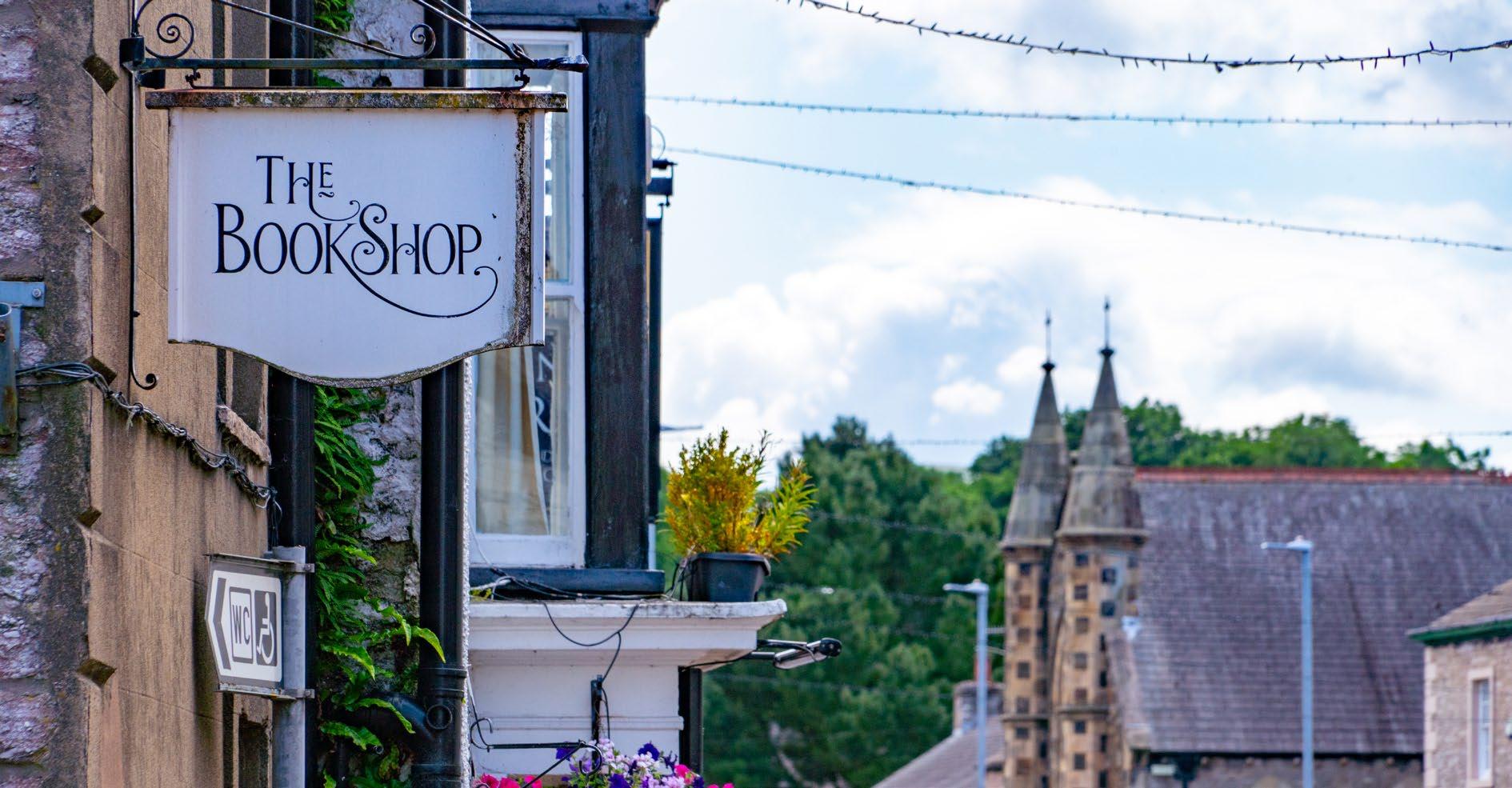
33
34
35
TOURISM MEASURE YEAR % CHANGE 2019 2021 2022 2021-2022 2019-2022 Visitor Numbers (total) (millions) 47.9 37.1 41.4 12% -14% Day Visitors (millions) 41.2 31.2 33.4 7% -19% Staying Visitors (millions) 6.7 5.9 7.9 35% 18% All Tourism Spend/Revenue (£ billions, 2022 values)* £3.87 £3.55 £4.12 16% 6%
Table 8.1: Cumbria: Tourism Volume and Value 2019, 2021 and 2022
The £4.1 billion measures total spend effects in the economy including indirect taxes such as VAT and all multiplier spend effects.
In 2021 there were 152,000 full time employees and 76,000 part time employees (or 190,000 FTEs) and a further estimated 41,0000 self-employed (for which FTE figures are not available) of around 230,000 FTE jobs.
Note: The GVA figures are different to the STEAM economic impact figures quoted ,which are total spend effects in the local economy.
A DESTINATION MANAGEMENT PLAN FOR CUMBRIA: 2024 TO 2030 74
Kirkby Stephen

 Figure 8.1: Tourism spend per resident, 2022
Source: CWE analysis comparing total tourism spend to total GVA
Bluebird K7, The Ruskin Museum
Figure 8.1: Tourism spend per resident, 2022
Source: CWE analysis comparing total tourism spend to total GVA
Bluebird K7, The Ruskin Museum
75 A DESTINATION MANAGEMENT PLAN FOR CUMBRIA: 2024 TO 2030
©The Ruskin Museum
There is an important visitor economy across Cumbria, but with opportunity to grow it countywide and during the shoulder months. As Figure 8.2 shows, the relative importance of the visitor economy varies widely across Cumbria. Its relative impact is much more important in the Lake District, where there are fewer alternative industries than elsewhere.

Source: Analysis of CT STEAM data and 2021 population estimates
Visitor spend and therefore, the total and relative importance of the visitor economy, was growing in the years up to the pandemic. However, coronavirus and its associated restrictions had a devastating impact on the visitor economy. In 2020, Cumbria saw a fall of 50% in tourist numbers and tourist days, and a 49% reduction in direct expenditure and economic impact. Tourism jobs fell by 45%.
In 2021 there was some recovery, however, across the county as a whole visitor numbers were still down 23% and tourism revenue 16% down compared to 2019 pre-pandemic levels. Although 2022 saw an improvement in visitor numbers compared to 2021 and 2020, overall visitor numbers still lag 14% behind those of 2019. There has been a significant fall in the day visitor market, which is 16.5% down on pre-pandemic levels. The slow return of the international market and group travel continues to make an impact here, but there are other factors too, including road fuel prices and other issues such as public transport disruption that have held back visitor numbers.
However, compared to 2019 levels (pre-Covid), visitor numbers were 14% down, with a loss of 17% in day visitors - offset somewhat by a small increase in staying visitors. Revenue increased by 7%. Business profitability remains significantly challenged by rising day-to-day operating costs, including labour, energy, supplies, food fuel and debt servicing costs - as well as the increasing cost-of-living squeeze on consumers (see Table 8.1).
Figure 8.2: Tourism spend per resident, 2022
A DESTINATION MANAGEMENT PLAN FOR CUMBRIA: 2024 TO 2030 76
On a more positive note, however, the volume of visitors choosing to stay overnight has increased by almost 4% on 2019 levels. This aligns with Cumbria Tourism’s strategy to increase the number of overnight stays, as this has the greatest impact on tourism value - with staying visitors doing and spending more.
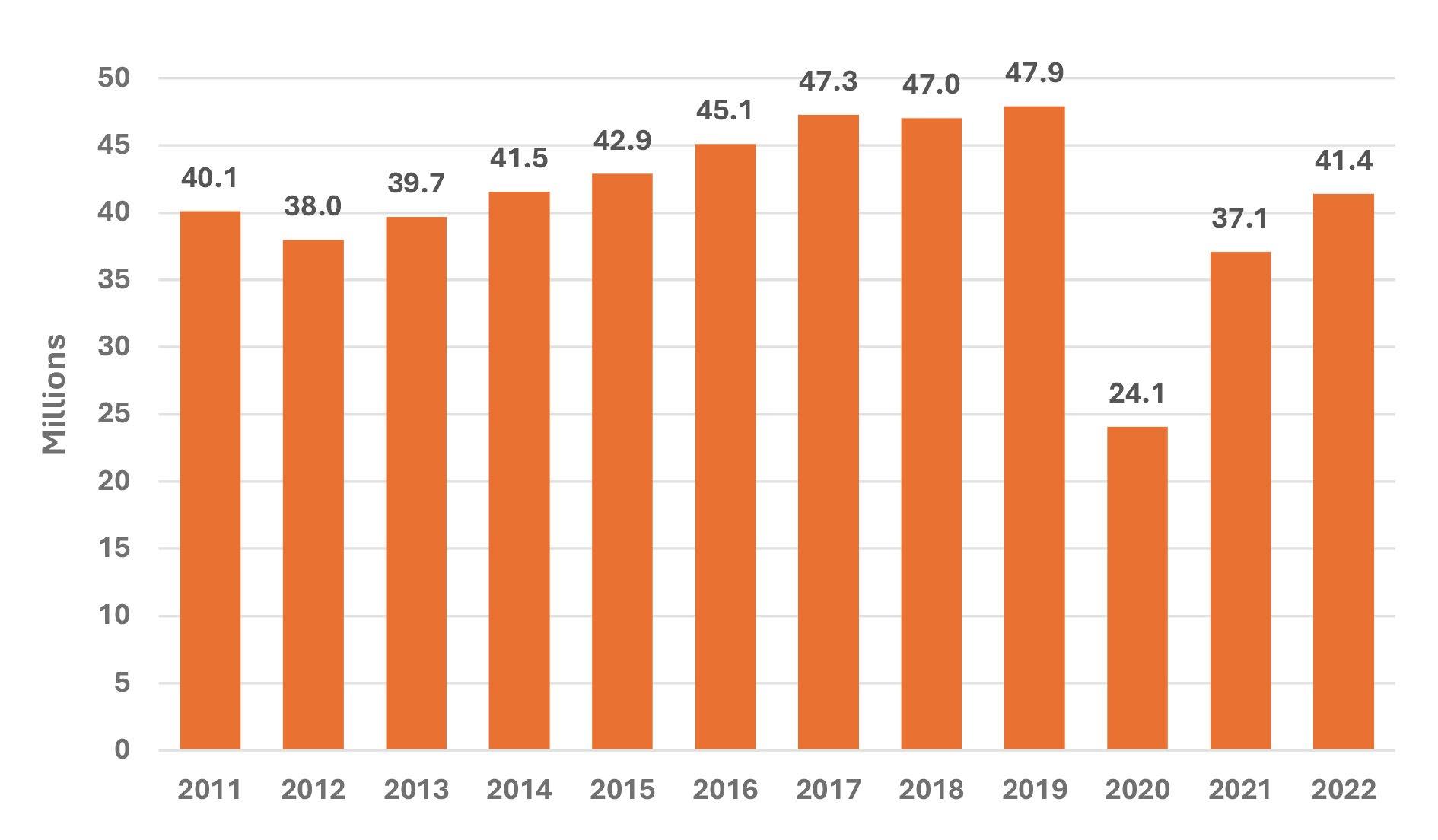
 Figure 8.3: Total visitors to Cumbria, 2011 to 2022
Source: CT STEAM data
Figure 8.4: Total direct visitor spend in Cumbria 2011 to 2022
Figure 8.3: Total visitors to Cumbria, 2011 to 2022
Source: CT STEAM data
Figure 8.4: Total direct visitor spend in Cumbria 2011 to 2022
77 A DESTINATION MANAGEMENT PLAN FOR CUMBRIA: 2024 TO 2030
Source: CT STEAM data. Note: direct spend only and excludes spend on VAT

 Figure 8.5: Serviced Accommodation Visitors
Source: CT STEAM data
Figure 8.6: Non-Serviced Accommodation Visitors
Figure 8.5: Serviced Accommodation Visitors
Source: CT STEAM data
Figure 8.6: Non-Serviced Accommodation Visitors
A DESTINATION MANAGEMENT PLAN FOR CUMBRIA: 2024 TO 2030 78
Source: CT STEAM data
8.2 OUR VISITORS
8.2.1 Overnight visitors
There were an estimated 8 million overnight visitors to Cumbria in 2022 who spent an average of 3.2 days or 25.3 million days here in total (or 43% of all tourist days). They accounted for 54% of all tourism spend.
Overnight visitors to Cumbria come from across the UK, as well as internationally. There is, however, a strong north of England focus. In 2022 two thirds of all overnight visitors came from either the North West, the North East or Yorkshire and the Humber - a share that had risen substantially form the 50% in 2018
The recent strong growth in staying visitors has been in part fuelled by an increase in the use of self-catering (i.e. non-serviced accommodation). This is partly a reflection of supply and also likely to be recent changes in behaviour brought about by the pandemic (see Figures 7.5 and 7.6)36
 Figure 8.7: Origins of UK staying visitors in Cumbria, 2022
Figure 8.7: Origins of UK staying visitors in Cumbria, 2022
Of the £380 million of extra spend impacts in 2022 compared
2019 from staying
VFR)
80% was
those in non-serviced accommodation. They account for nearly 90% of the extra 1.44 million staying visitor days in 2022 compared to 2019. 79 A DESTINATION MANAGEMENT PLAN FOR CUMBRIA: 2024 TO 2030
Source: CT Visitor Survey, 2022
36
to
visitors (excluding
around
from

ALL VISITORS DAY VISITOR STAYING VISITOR REPEAT VISITOR FIRST TIME VISITOR East Midlands 3% 1% 5% 3% 4% East of England 2% 1% 4% 2% 5% London 1% 1% 5% 2% 13% North East 9% 10% 10% 11% 4% North West 37% 68% 45% 59% 36% Cumbria 19% 34% 2% 21% 1% Lancashire 18% 21% 13% 18% 10% Merseyside 7% 4% 9% 6% 10% Greater Manchester 8% 5% 12% 8% 11% Cheshire 5% 3% 8% 5% 5% South East 2% 1% 2% 1% 3% South West 2% 1% 3% 2% 3% West Midlands 4% 1% 7% 3% 10% Yorkshire and the Humber 12% 12% 12% 12% 12% Scotland 4% 3% 5% 4% 8% Wales 2% 1% 3% 2% 3% Base 1,950 1,037 913 1,762 187
Table
8.2:
Where visitors came from in 2022
A DESTINATION MANAGEMENT PLAN FOR CUMBRIA: 2024 TO 2030 80
Hartsop
8.2.2 Day visitors
There were an estimated 34 million day visits to Cumbria in 2022 who accounted for 83% of all visitors and 59% of all tourist days. Day visitors are an important contributor to the economy and generate just under half of the county’s tourism revenue (46%). However, their spend per day is considerably lower than staying visitors (by around a third37) and they have a larger impact on services, the infrastructure and the environment relative to their economic contribution.
Day visitors, as would be expected, are relatively local with (in 2022) a third from Cumbria itself and over half from Cumbria and Lancashire combined. Overall, in 2022, 68% came from the North West, which is well up on pre-Covid levels (56%).
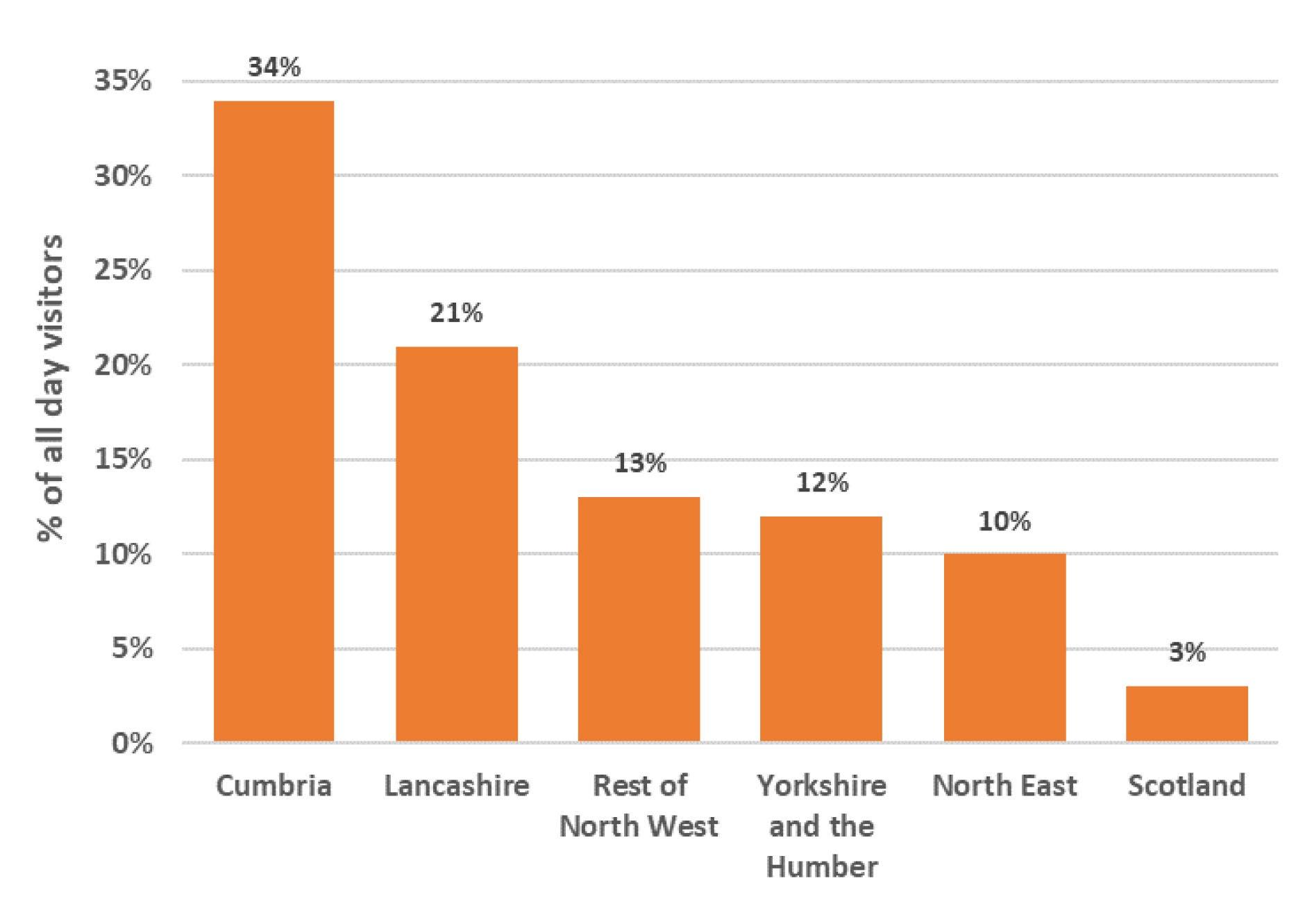
Source: CT Visitor Survey, 2022
8.2.3 Other markets
CT’s 2019 serviced accommodation occupancy data shows that business guests accounted for 7% of bed nights over the course of the year. This rose to 15% for businesses outside of the Lake District National Park, 29% for businesses in Copeland, and 17% for serviced accommodation providers in Carlisle. Overall, in 2019 (based on this share of bed nights) business tourism may have contributed around £56 million of spend or 1.4% of the total for all tourism in Cumbria, although it is relatively more important in Copeland and Carlisle.
Figure 8.8: Origins of UK day visitors in Cumbria, 2022
37 In 2022, according to STEAM data by 35% overall across Cumbria and by 42% in the LDNP area. 81 A DESTINATION MANAGEMENT PLAN FOR CUMBRIA: 2024 TO 2030
There is no robust data on the value of film and TV activity in Cumbria and it varies from year to year, but film and TV programmes have an important role in showcasing the area. In 2021, 2022 and 2023 the following feature films and TV shows filmed in Cumbria were realised: the second season of Netflix’s The Witcher and Mission Impossible Dead Reckoning Part One.
Cumbria, and in particular the Lake District, has been an important centre of outdoor education with a number of important players operating there (Outward Bound Trust, Lake District Calvert Trust, Brathay Trust). It has been a key centre for educational visits for field studies, team building and day trips. The University of Cumbria is an important higher education provider of outdoor education qualifications and research from its Ambleside campus.
8.2.4 Key trends and changes in our visitors
There have been some recent shifts in the socio-demographic of our visitors, comparing 2022 with the pre-Covid solution (for 2018). On a positive note, Cumbria seems to be having more younger people and a greater diversity of visitors. In 2022, 40% of visitors were aged between 16 and 40, up from 27% in 2018. 16% included someone in their group from an ethnic minority, up from 2% in 2018. Of those surveyed, 14% included someone in their group with a health issue or disability.
International visitors accounted for circa. 15% of Cumbria’s visitor volume pre-covid in 2014. The figure in 2018 was 10%, but this fell away completely in 2020, with only limited recovery in 2021 and 2022. Signs of recovery are now being seen – nationally and locally - but Cumbria will have to work hard to regain and grow its share of the international market against its national and international competitors.
Source: Cumbria Visitor Surveys 2022 and 2018
FACTOR DETAIL 2018 2022 CHANGE Age 16 to 44 27% 40% 13% 60 plus 33% 13% -20% Ethnicity Non-white 2% 16% 14% Origin International visitors 10% 3% -7% From North West 32% 57% 25% From North West, North East or Yorkshire and Humber 56% 79% 23% From London and the South East 15% 5% -10% Disability or not No one with a health issue or disability 81% 80% -1%
Table 8.3: Key shifts in visitor profile in Cumbria pre and post Covid
A DESTINATION MANAGEMENT PLAN FOR CUMBRIA: 2024 TO 2030 82
8.3 WHERE VISITORS GO AND WHY THEY COME HERE
8.3.1 Where visitors go to in Cumbria
In 2022 tourism in the Lake District accounted for an estimated 53% of all spend across Cumbria, 44% of visits and 50% of days. Partners in Cumbria have been following an “attract and disperse” strategy for some time which aims to spread tourism activity out across Cumbria, reducing the pressure in parts of the Lake District and attracting visitors to parts of Cumbria where there is greater scope to grow the visitor economy.
Figure 8.9 shows how the share of the Cumbrian visitor economy outside the LDNP area has changed over the past decade. Prior to covid, there was a slight decline in the share of spend, visitors and days, although this fluctuated according to former district area and year to year. However, post-covid the share has dropped sharply. Figure 8.10 looks at absolute changes and this shows that in the period up to 2019, there was significant absolute growth in the visitor economy in both the LDNP and the rest of Cumbria. However, as of 2022, although there has been a recovery in the Lake District, the rest of Cumbria has seen a relatively poor performance.

Source: CT STEAM data
Figure 8.9: Trends in share of visitor activity in Cumbria outside the Lake District NP
83 A DESTINATION MANAGEMENT PLAN FOR CUMBRIA: 2024 TO 2030
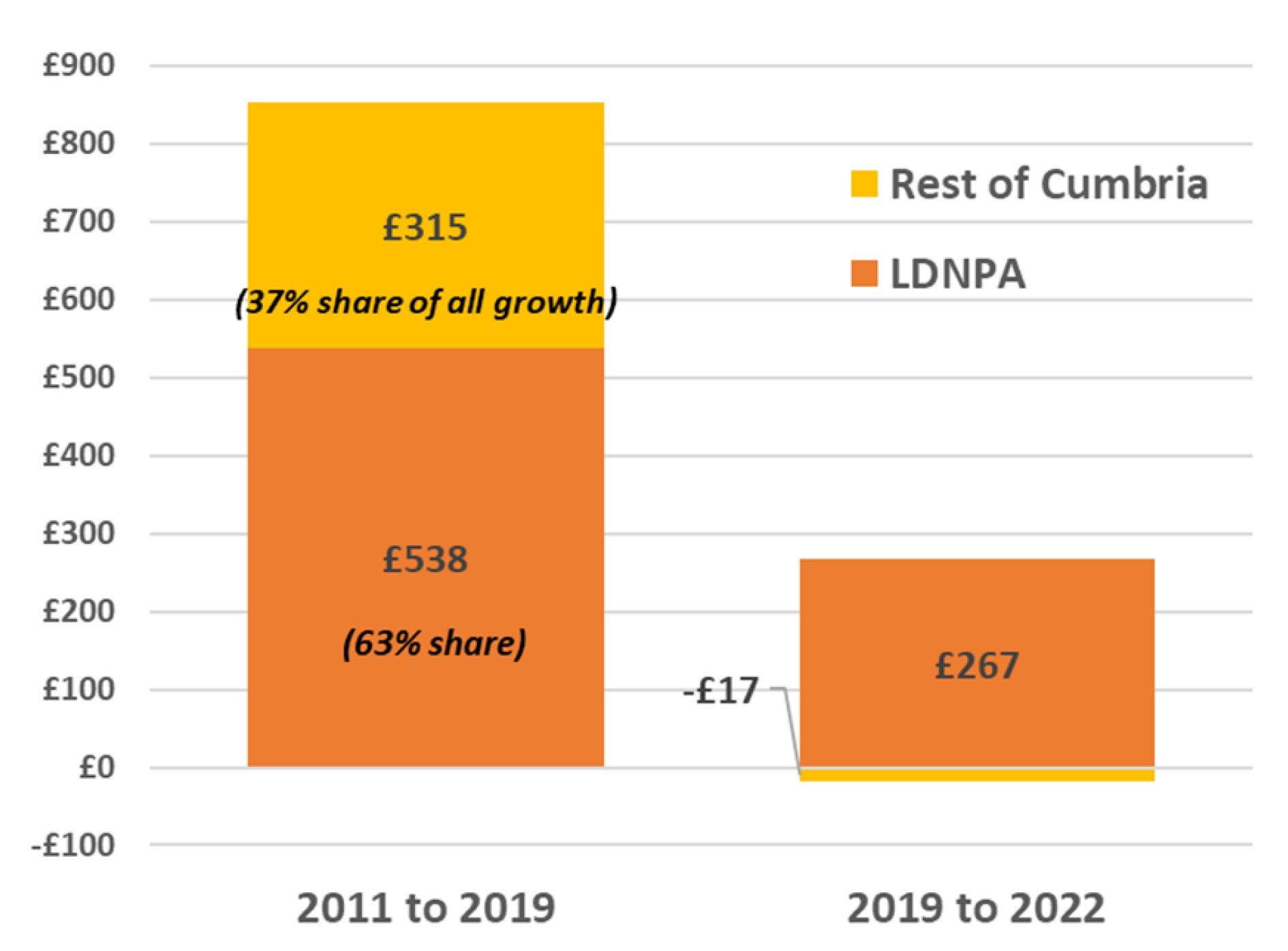
Source: CT STEAM data
At a more granular level, there is a complex pattern of the places that are most visited. A recent online survey for CT (Figure 8.11) showed that Keswick and Ambleside were visited by half of all visitors to Cumbria while Windermere, Grasmere and Bowness were visited by roughly two fifths each. Outside the Lake District itself, the most visited locations were the towns just outside it (Kendal 19%, Penrith 14%, Cockermouth 13% and Grange-over-Sands 10%). The results of the survey were similar to that for 2021 in terms of places visited.
The survey emphasises the key role of the Lake District “core” (Windermere/Coniston/Grasmere/ Ullswater and Keswick); the lesser role of the less accessible western part of the Lake District (Eskdale, Ennerdale, Loweswater and Wasdale); the important role of the satellite towns around the Lake District; and also the wide variety of places visited across Cumbria. Carlisle, the largest settlement in Cumbria, with its major castle, museums and history is relatively less visited, as is the Hadrian Wall.
Figure 8.10: Change in total spend impact from tourism in real 2022 prices, £ms
A DESTINATION MANAGEMENT PLAN FOR CUMBRIA: 2024 TO 2030 84
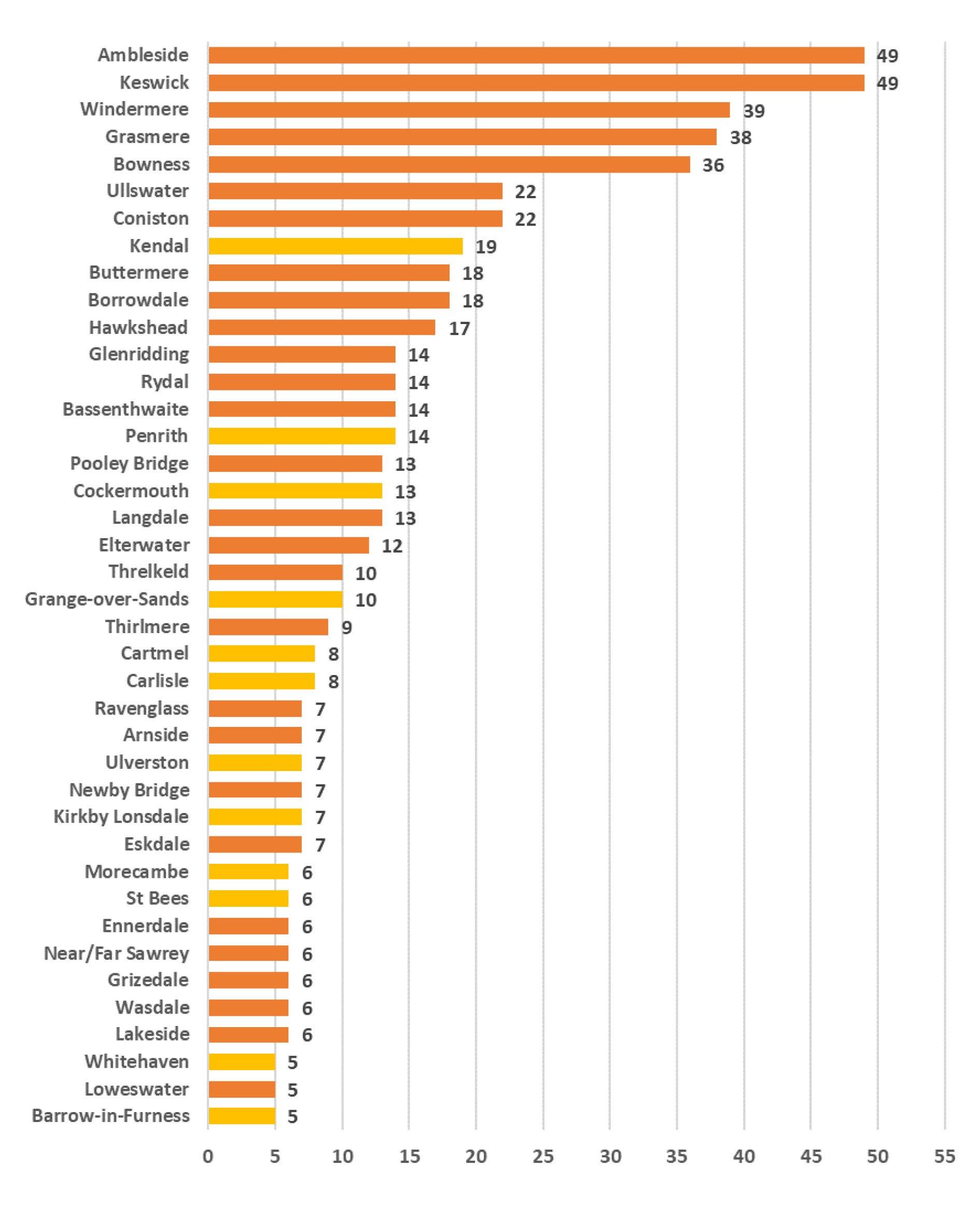
Source: CT Online Visitor Survey, 2022. Notes: % of all visitors responding, bars in yellow are places outside the LDNP; only places mentioned by 5% or more visitors included38. The sample was 1,766 respondents, but this was not controlled and was self-selecting.
Figure 8.11: Most visited places by visitors to Cumbria, 2022
85 A DESTINATION MANAGEMENT PLAN FOR CUMBRIA: 2024 TO 2030
38 The other places mentioned were: (by 4%) Staveley, Haweswater, Sedbergh, (by 3%) Hadrian’s Wall, Appleby, Maryport, Silloth, Workington, Broughton-in-Furness, Kirkby Stephen, Allonby, Shap, (by 2% or fewer) Egremont, Askham, Brampton, Millom, Walney Island, Alston, Haverigg, Dent, Dalton, Silecroft, Wigton, Bowness-on-Solway and Nenthead.
The five most visited attractions in Cumbria in 2021 were all in the Lake District: Windermere Lake Cruises (1,065,707), Ullswater Steamers (216,000), Ravenglass & Eskdale Railway (131,000), Sizergh Castle and Garden (89,563) and Hill Top (55,512). Their combined visitor numbers in 2021 were 40% down on the totals for 2019 (2.6 million). The next seven most visited attractions are all outside the Lake District National Park spread across Cumbria with 280,000 visitors in 201939

Source: Work by CWE for Cumbria LEP. Note: Based on TripAdvisor data on visitor attractions (red spots on the left-hand map). The right-hand side map is a heat map reflecting tourism activity, utilising the same dataset as the first map, but focusing on the number of reviews on Trip Advisor as a proxy for visitor numbers. Dark red hotspots on the map indicate areas with a high density of attractions and a significant number of visitors. As anticipated, tourism is prominently concentrated within the Lake District and surrounding gateway areas to the south (including Kendal) and northeast (around Penrith), with a further cluster around Carlisle/ Hadrian’s Wall.
8.3.2 Why visitors come here
Based on visitor surveys carried out over many years, there is a good evidence base as to why visitors come to Cumbria (see Figure 8.13). Aside from spending time with - or visiting - friends and family, the factors that stand out are visiting for the landscape (66%) or to be outdoors (65%), as well as the area’s peace / beauty / relaxation (60%, up from 36% in 2018). 40% chose the area for
Figure 8.12: Concentrations of visits
A DESTINATION MANAGEMENT PLAN FOR CUMBRIA: 2024 TO 2030 86
39 These are: Lakeland Motor Museum (Ulverston), Lake District Coast Aquarium (Maryport), Carlisle Castle, Birdoswald Roman Fort, The Dock Museum (Barrow), Acorn Bank Garden (near Appleby) and Holker Hall and Gardens (Cartmel peninsular). Note: We do not have figures for Tullie House Museum in Carlisle, but in 2017/18 it recorded 250,000 visitors.
its health and wellbeing benefits, or for walking. 35% chose the destination for its remoteness and feeling of safety, while 29% wanted to go on the water. Broadly the reasons and motivations have stayed consistent over time.
When asked about the main reason for their visit in 2022 (see Table 8.4), 57% identified a reason related to the scenery, outdoors activities, health and wellbeing, specific attractions/places/events or walking and cycling. In the main, the ranking and relative importance of the reasons is quite similar between day and staying visitors and depending on where visitors go. However, there are some clear different motivations between visitors in and outside the Lake District National Park:
• Visiting a World Heritage Site was more important for those outside (11%) than inside (4%) and rising to 23% of visitors to Carlisle (linked to Hadrian’s Wall).
• Outside the LDNP, visitors were more likely to be visiting friends and family, and going to a specific place.
• Inside the LDNP, visitors were even more likely to be there to be outdoors (79% vs 51%), walking and other activities (48% vs 31%) and for its remoteness (44% vs 25%).
Cycling was one reason for the visit for 9% of visitors, but the main reason for 6% (equal fifth most important main reason), indicating its importance for this visitor segment.
Source: Cumbria Visitor Survey, 2022. Note: *Totals may not sum due to rounding
REASON ALL REASONS MAIN REASON* DIFFERENCE For the physical scenery and landscape 66% 9% 57% To be outdoors 65% 12% 53% Peaceful, relaxing, beautiful area 60% 11% 49% To spend time with family and friends 50% 21% 29% For health and wellbeing benefits 40% 2% 38% For walking/specific activity 39% 5% 34% It is familiar to me/us 39% 5% 34% For its remoteness 35% 3% 32% It feels safe 34% 3% 31% To go on the water 29% 4% 25% Conveniently located 15% 2% 13% The weather was good 14% 3% 11% For its food and drink offer 13% 1% 12% To visit friends and family 12% 5% 7% For cycling 9% 6% 3% It is a World Heritage Site 8% 1% 7% To celebrate a particular occasion 7% 6% 1% It is new to me/us 6% 2% 4% To visit a particular place/attraction etc 5% 3% 2%
Table 8.4: Reasons for Visiting Cumbria in 2022
87 A DESTINATION MANAGEMENT PLAN FOR CUMBRIA: 2024 TO 2030
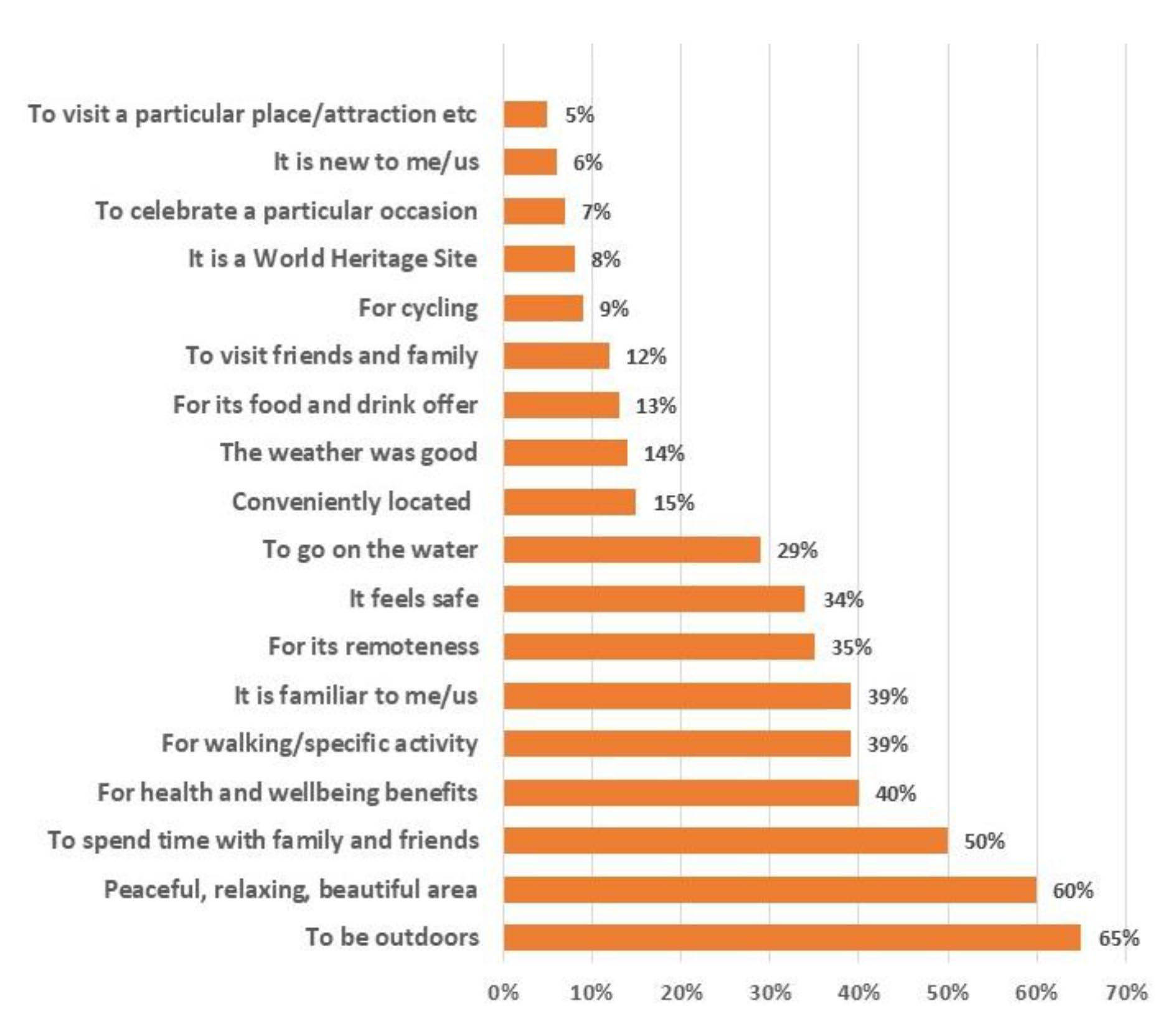
 Figure 8.13: Reasons for visiting Cumbria in 2022
Source: Cumbria Visitor Survey, 2022
Figure 8.13: Reasons for visiting Cumbria in 2022
Source: Cumbria Visitor Survey, 2022
A DESTINATION MANAGEMENT PLAN FOR CUMBRIA: 2024 TO 2030 88
Tarn Hows
Table 8.5: Reasons for Visiting in 2022 (all reasons), by location
Source: Cumbria Visitor Survey, 2022
Physical scenery and landscape of the area 59% 77% 43% 83% 69% 64% 70% 61% 9% To be outdoors 67% 56% 39% 83% 75% 67% 79% 51% 28% Peaceful, relaxing, beautiful area 48% 83% 44% 76% 53% 61% 60% 60% 0% To spend time with family and friends 39% 54% 47% 72% 52% 40% 52% 47% 5% For health and wellbeing benefits 40% 41% 30% 60% 33% 37% 44% 36% 8% It is familiar to me/us 41% 34% 52% 46% 36% 32% 42% 37% 5% For walking/specific activity 53% 35% 24% 51% 35% 36% 48% 31% 17% For its remoteness 27% 34% 16% 70% 44% 25% 44% 25% 19% It feels safe 25% 36% 22% 67% 38% 25% 41% 28% 13% To go on the water 28% 35% 14% 31% 43% 24% 35% 23% 12% Conveniently located 8% 8% 26% 23% 20% 13% 16% 16% 0% The weather was good 17% 10% 14% 17% 14% 15% 15% 14% 1% For its food and drink offer 27% 6% 10% 8% 11% 12% 14% 13% 1% To visit friends and family 11% 28% 8% 10% 8% 9% 8% 15% -7% For cycling 19% 5% 5% 8% 8% 9% 13% 5% 8% It is a World Heritage Site 4% 7% 23% 7% 8% 2% 4% 11% -7% To celebrate a particular occasion 12% 10% 5% 7% 4% 5% 9% 5% 4% It is new to me/us 1% 5% 22% 5% 6% 3% 4% 9% -5% To visit a particular place/attraction etc 2% 3% 14% 2% 2% 4% 2% 7% -5%
ALLERDALE EDEN LAKELAND IN LDNPA OUTSIDELDNPA DIFF IN/OUT LDNP 89 A DESTINATION MANAGEMENT PLAN FOR CUMBRIA: 2024 TO 2030
ALLERDALE BARROW CARLISLE
8.3.3 Why visitors do not come here
CT carried out research covering those who do and do not visit Cumbria and the Lake District40. In the research, the strongest associations with words were: ‘lakes’, ‘beautiful’, ‘landscape’, and ‘for walkers’ – all chosen by more than 70% of respondents. Next came ‘good for outdoor activities’, ‘peaceful’, ‘mountains’ and ‘relaxing’ - chosen by around 60% of respondents. Around a third of respondents also chose the words ‘quiet’, ‘good food and drink’, ‘welcoming’, ‘friendly’, ‘active’, ‘good history and heritage’ and ‘slower pace of life’. On a less positive note, around a quarter described the area as ‘traditional’, ‘rainy’ and ‘expensive’.
Words least associated with the area (chosen by 10% or less) included ‘good value’, ‘traffic’, ‘old-fashioned’, ‘events/festivals’, ‘adrenaline’, ‘good place for teenagers’, ‘modern’ and ‘boring’. Perceptions that the destination is not good value, not modern, not good for teenagers, and potentially has limited events and festivals would need to be addressed to improve the potential to reach new audiences.
People who had visited Cumbria and the Lake District more than 10 years ago were more likely to associate the area with words like ‘rainy’ (42%) and ‘expensive’ (32%) – perhaps explaining in part why they have not re-visited. People who have never visited were less likely to associate the area with being ‘fun’ (14%), ‘a ‘good place for families’ (25%), ‘friendly’ (22%), ‘safe’ (18%), ‘welcoming’ (23%) and ‘good food and drink’ (19%). They were also more likely to choose phrases like ‘hard to get to’ (26% - compared to just 3% for those visiting in the last couple of years). This, of course, will in part reflect where people live.
People were asked: “What, if anything, would make you consider a visit to the Lake District, Cumbria?”. Cost (or the perception of cost) is the most significant factor here – two fifths said cheaper accommodation would make them consider a visit, or that good deals/offers would make them consider visiting. A third mentioned their own financial situation – if they had more money they would consider a visit - and a quarter mentioned cheaper food and drink. Finally, around a third said that better public transport would make them consider a visit to the Lake District, Cumbria.
Other factors mentioned were ‘more for families/children to do (including in wet weather)’, ‘cultural activities including theatre and live music’ and ‘cheaper activities’. These would motivate around 16% of the current non-visitors. Information and better parking were also chosen as motivating factors. However, these are based on a very small sample.
8.3.4 When do visitors come?
Visitors come to Cumbria all year round and, increasingly, there is no closed or entirely off-peak season. However, tourism - especially overnight tourism - remains seasonally-driven by family holiday availability, accommodation availability (many camp sites only open in the summer), the weather and the outdoor focused nature of many visitors. The seasonality of tourism is particularly pronounced outside the Lake District. A 10% increase in visitor spend in each of the off-peak months - and 5% in the shoulder months outside the three peak months for spend (July and August) - would increase overall spend, based on 2022 figures, by around £255 million or 5%.
A DESTINATION MANAGEMENT PLAN FOR CUMBRIA: 2024 TO 2030 90
40 The research was carried out in 2023 via an online survey with around 670 responses, of whom around three fifths had not visited Cumbria/Lake District within the last 5 years.

 Figure 8.14: Occupancy rates by month, all accommodation, 2019
Source: CT STEAM data
Figure 8.15: Tourism spend per month, 2022
Figure 8.14: Occupancy rates by month, all accommodation, 2019
Source: CT STEAM data
Figure 8.15: Tourism spend per month, 2022
91 A DESTINATION MANAGEMENT PLAN FOR CUMBRIA: 2024 TO 2030
Source: CT STEAM data
8.4 ACCOMMODATION
Cumbria has an extraordinarily diverse range of accommodation in terms of the price and nature of the accommodation - from top-end luxury hotels to botheys and everything in between. There are approximately 1,500 hotels, guesthouses and B&Bs; almost 9,000 self-catering properties (including houses, chalets, flats, static caravans, chalets and lodges); 182 touring caravan and camping sites (plus some temporary provision); and almost 7,000 bedspaces available in alternative accommodation types (including hostels, camping pods, yurts, tipis, glamping, wigwams, shepherd’s huts, camping barns, campus accommodation, bunkhouses and group accommodation).
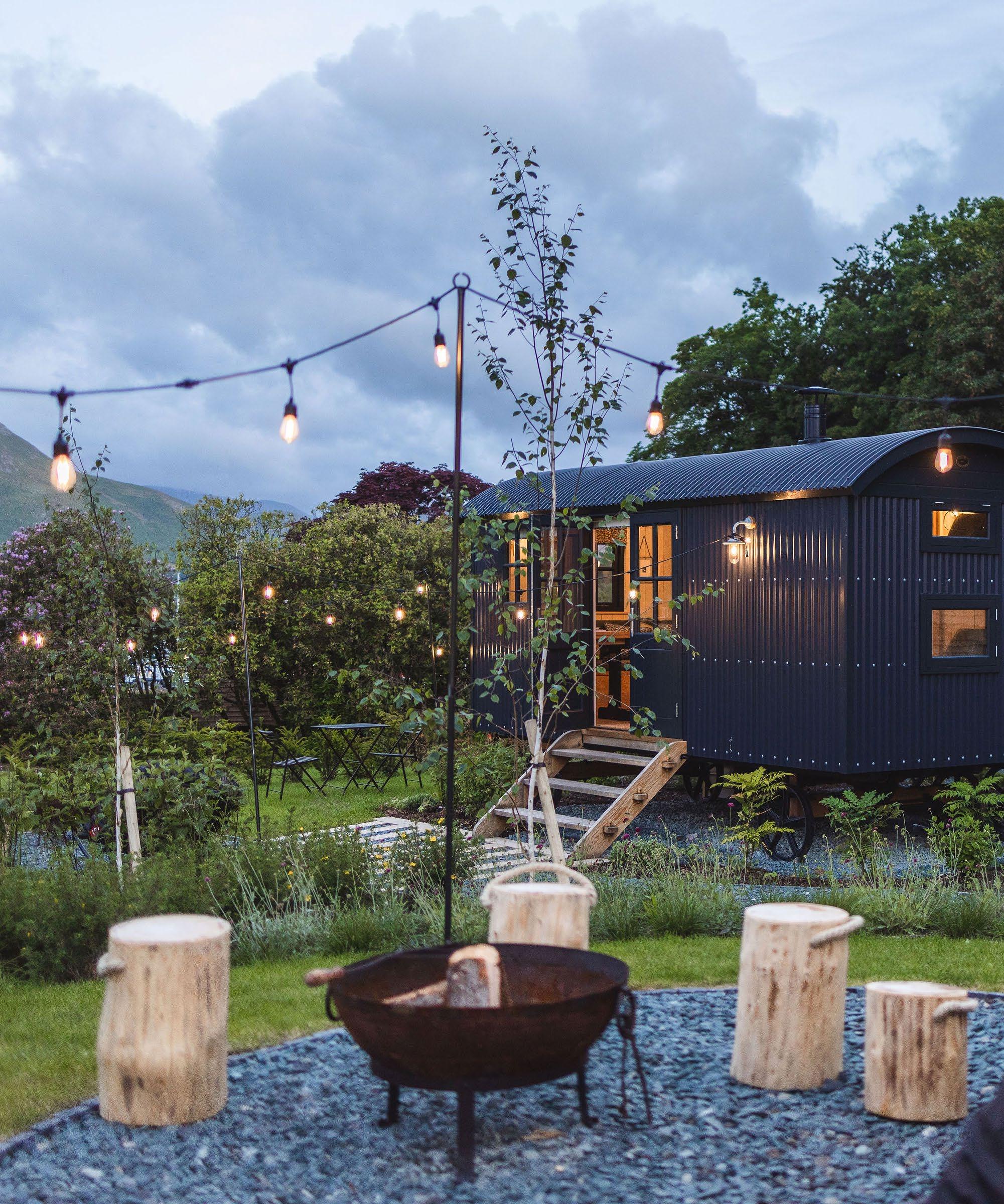 Shepherd Huts at Another Place
Shepherd Huts at Another Place
A DESTINATION MANAGEMENT PLAN FOR CUMBRIA: 2024 TO 2030 92
©Michael Lazenby
8.5 TRANSPORT AND DIGITAL
8.5.1 Getting to Cumbria
The vast majority of visitors still come to Cumbria by private vehicle. In 2022, an estimated 65% of visitors came to Cumbria by car (petrol/diesel), 11% in motorhomes, 9% in electric or hybrid vehicles and 7% by motorbike. Therefore, an estimated 91% arrived by private vehicle, up from 86% in 2018 and 81% in 2015. In part, this is driven by the current lower volumes of international visitors who have tended to travel predominantly by bus/train/organised shared transport and the current concentration on the more localised (northern) market. An estimated 7% of visitors arrived by train, slightly up on 6% in 2018 - despite a number of strikes and cancellations affecting rail services during 2022. There is very little difference in the mode of transport between day and staying visitors.
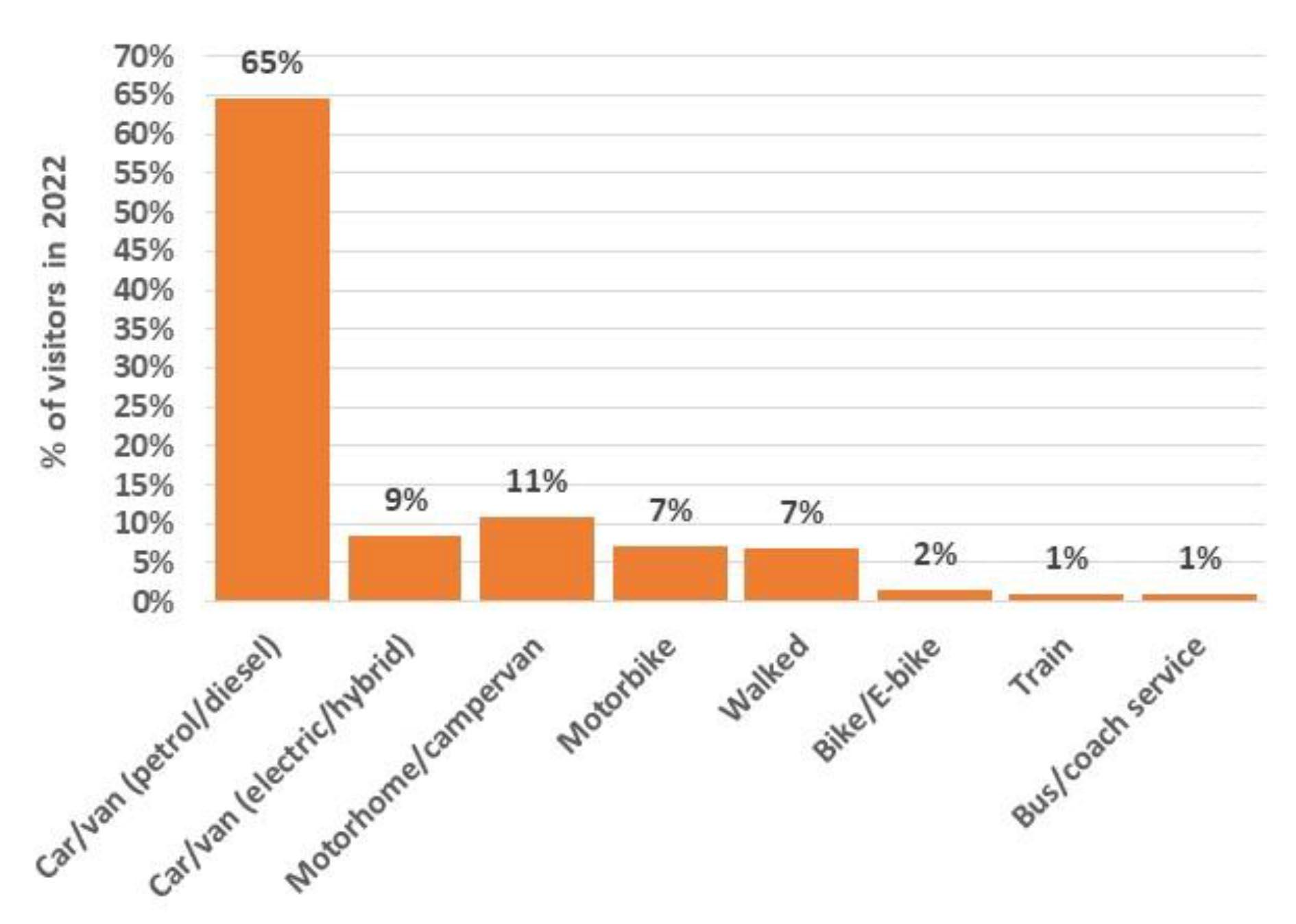
Source: CT Visitor Survey, 2022
Cumbria is served by several rail lines providing access for visitors to arrive and then move around: the high-speed West Coast mainline with stops at Oxenholme (for Kendal) linking to the Lakes Line, Penrith (for the North Lakes) and Carlisle. The Furness line to Barrow via Ulverston, the Coastal line from Carlisle to Barrow, the Newcastle line from Carlisle eastwards and the Settle to Carlisle line all provide opportunities to move around the county by train (in addition to the local ‘steam’ train lines which serve the visitor economy41).
Figure 8.16: How visitors to Cumbria arrived in 2022
93 A DESTINATION MANAGEMENT PLAN FOR CUMBRIA: 2024 TO 2030
41 The 7 miles Ravenglass & Eskdale Railway, known as La’al Ratty, the 3.5 miles Lakeside & Haverthwaite Railway to the south end of Windermere; and the South Tynedale Railway, running for 3.5 miles from Alston in Cumbria to Slaggyford in Northumberland.
8.5.2 Moving around Cumbria
Once visitors have arrived in Cumbria, then there are shifts in the modes of travel used. Private vehicles remain the dominant form of transport (with around 90% using car/van/motorbike/ motorhome). However, there is a significant level of “active travel”, with 57% of visitors travelling around on foot and 9% by bike/e-bike. Day visitors are less likely to travel by foot (50%) compared to staying visitors (65%). 16% of staying visitors took a boat or a ferry to get around, and 14% used a bus or coach service.

Source: CT Visitor Survey, 2022
8.5.3 Access to digital services
Cumbria, and in particular rural parts of Cumbria, has had relatively poor access to broadband and voice/data mobile phone services (4G) both onsite and when travelling, due to the challenges of attracting commercial infrastructure investment. This has had particular challenges for the visitor economy in Cumbria, given that many of the businesses - and much of the visitor activity - is in rural and, at times, remote locations and visitors increasingly expect to have reliable connectivity throughout their visit. In 2020, the Cumbria Digital Infrastructure Strategy was agreed, with the aim of improving both mobile and fixed line connectivity with no one and no place left behind.
As part of the Cumbria Digital Infrastructure Strategy, the Connecting Cumbria team has been supporting the delivery of the UK Government Project Gigabit programme; Cumbria is a pilot area for this programme. The Project Gigabit regional contract, awarded by Building Digital UK to Fibrus Ltd at the end of 2022, is actively deploying gigabit capable broadband across the county for to up to 60,000 properties. 3,000+ properties are already able to order services and further areas are going live each quarter. Data received from thinkbroadband (www.thinkbroadband.com) at the
Figure 8.17: How visitors moved around in 2022
A DESTINATION MANAGEMENT PLAN FOR CUMBRIA: 2024 TO 2030 94
beginning of December 2023 estimated that 94.6% of properties in Cumbria were able to access broadband speeds of at least 30Mbps, with over 46% able to access gigabit capable services (see Table 8.6 for more detail). Subject to completion of declared commercial programmes and all works by Project Gigabit, Cumbria’s gigabit coverage is anticipated to exceed 99% of properties by the end of 2026.
As part of the Cumbria Digital Infrastructure Strategy, the Connecting Cumbria team has also been supporting the delivery of the UK Government Shared Rural Network programme. Through a combination of commercial and public investment, it will deliver 95% geographical 4G coverage across the UK from at least one mobile network operator by 2025. In Cumbria, good progress has been made and it is estimated that by 2025, outdoor 4G coverage by at least one mobile network operator will be available to 97% of the Cumbria landmass and 80% from all four mobile networks (see Table 8.7 for more detail). The Home Office Emergency Services 4G Network contributes to these targets. Ofcom coverage data estimates outdoor coverage from at least one mobile network operator at over 90% of Cumbria and coverage from all four main networks at over 64% (see Table 8.7 for more detail).
Source: Connecting Cumbria (from Ofcom)
Source: Connecting Cumbria (from Ofcom)
AREA > 1 GBPS (GIGABIT CAPABLE) >30MBPS <10MBPS UK 80.5% 97.9% 0.8% All Cumbria 46.0% 94.6% 2.9% Cumberland 37.4% 94.7% 2.8% Westmorland and Furness 55.9% 94.5% 3.0% LDNPA 19.3% 85.7% 2.7%
Table 8.6: Broadband Coverage, January 2024
AREA AT LEAST 1 MNO ALL 4 MNOS UK 92.7% 71.1% Cumbria 90.2% 62.7% Cumberland 86.7% 65.0% Westmorland and Furness 93.0% 60.9% LDNPA 80.8% 48.5%
Table 8.7: 4G Mobile Coverage, January 2024
95 A DESTINATION MANAGEMENT PLAN FOR CUMBRIA: 2024 TO 2030
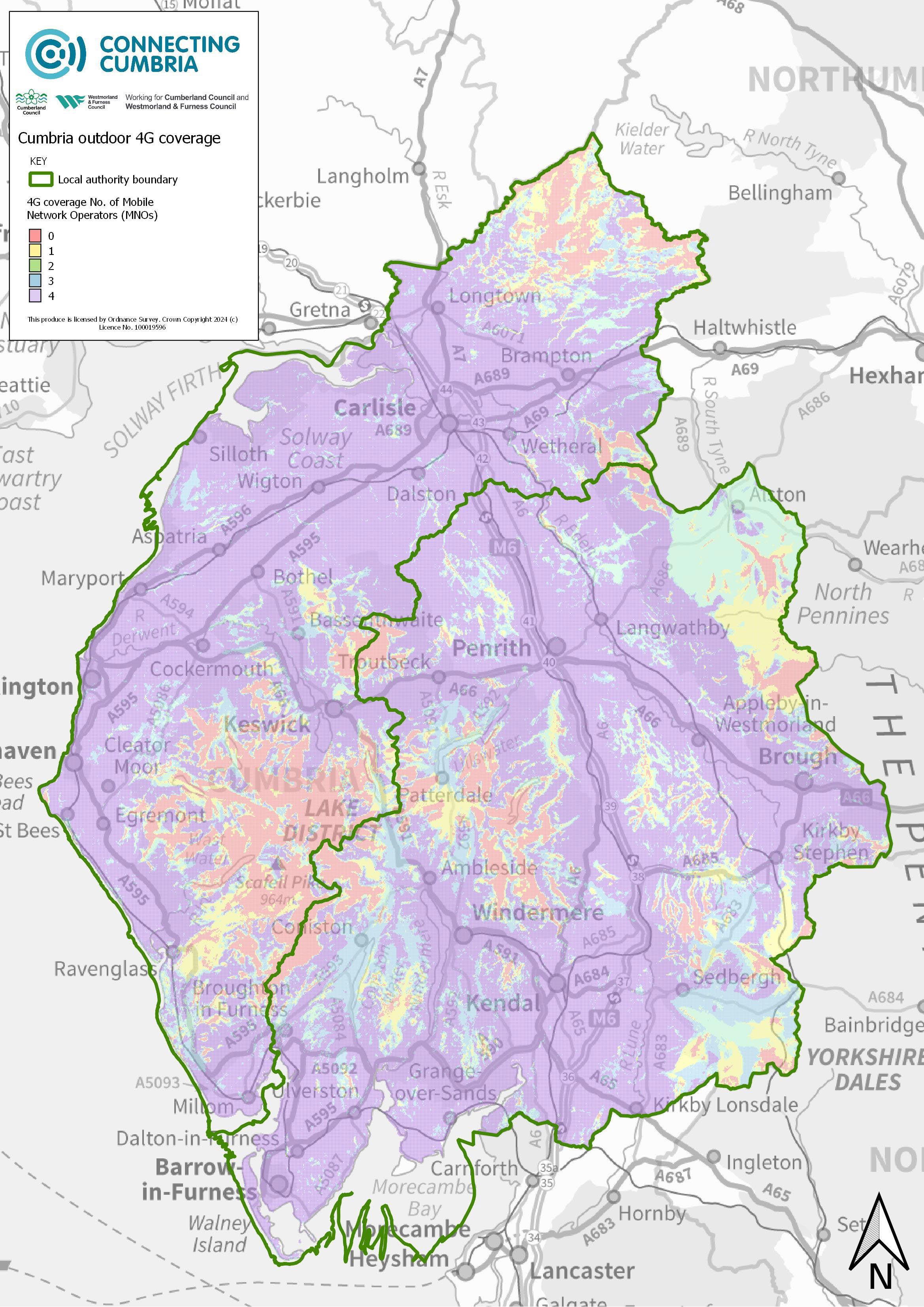 Figure 8.18: Mobile outdoor 4G coverage
Figure 8.18: Mobile outdoor 4G coverage
A DESTINATION MANAGEMENT PLAN FOR CUMBRIA: 2024 TO 2030 96
Source: Connecting Cumbria
8.5.4 Transport
The Cumbria Transport Infrastructure Plan sets out a range of ambitions through to 2037 many of which are explicit priorities for the visitor economy. Examples include:
• Establish comprehensive active travel networks to increase the number of people walking and cycling across Cumbria. This includes investment in walking and cycling infrastructure, publicity and promotion of walking and cycling and the creation of multi-modal hubs that connect walking and cycling to wider public transport.
• Achieve enhanced rail connectivity through improved stations, services and rail infrastructure within Cumbria, for both local and long-distance journeys. This must include more frequent and easier to use services with priorities on the West Coast Mainline, the Lakes line, the Cumbria Coast line and the Settle line.

• Establish innovative approaches to the delivery of new bus services and infrastructure, particularly within rural areas. This needs to include an enhanced partnership with local bus companies, more investment in smart ticketing, better transport information, demand responsive services, better and more frequent services to rural employment opportunities and key tourist destinations.
• Secure the integration of transport modes, including integrated ticketing and journey planning to support travel choice and the drive to decarbonise our transport networks.
The plan sets out six corridors for movement all of which are relevant for the visitor economy. The Heart of the Lakes is the one most heavily focused on the visitor economy. A separate infrastructure strategy has been developed for this corridor42. This identifies potential investment opportunities to promote active travel in this corridor.
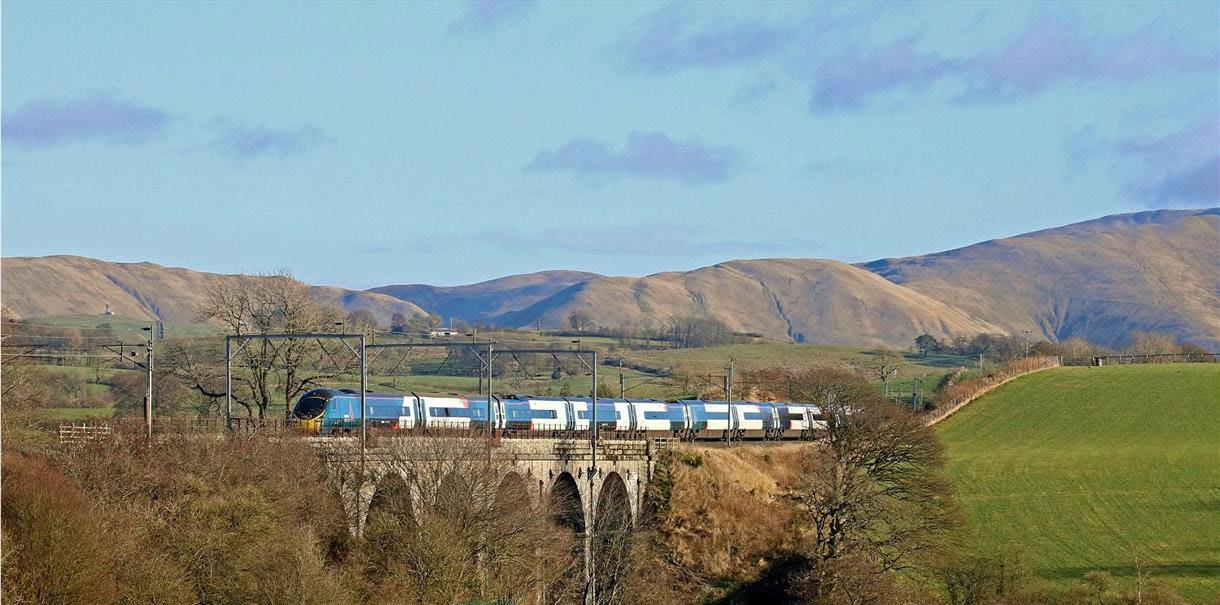 42 Heart of the Lakes Active Travel Infrastructure Strategy, 2022 – 2037, January 2023.
Avanti West Coast, Docker Viaduct near Lambrigg
42 Heart of the Lakes Active Travel Infrastructure Strategy, 2022 – 2037, January 2023.
Avanti West Coast, Docker Viaduct near Lambrigg
97 A DESTINATION MANAGEMENT PLAN FOR CUMBRIA: 2024 TO 2030
©Cumbria Transport Infrastructure Plan
8.6 OUR BUSINESSES AND PEOPLE
The visitor economy sector is largely a sector with many small, independent and local businesses. CT provides a focus for tourism-related businesses to come together and work collectively. It represents 4,500 member businesses (or nearly 20% of the 23,100 businesses across Cumbria in 2022)43. There are circa. 5,000 businesses across the county involved directly in accommodation, retail, visitor attractions, visitor activities, food and beverage and supporting services44. There are many other businesses involved in other sectors whose turnover is in full - or part - linked to the visitor economy and all its supply chains. The vast majority of firms in these sectors are either “micro” (80% fewer than 10 employees) or “small” (around 20% with 10 to 50 employees). There are a small number of larger visitor economy businesses in Cumbria including larger holiday parks (e.g. Center Parcs near Penrith), larger hotels and major visitor or transport attractions).
Previous research for Cumbria LEP has suggested that productivity levels in the main sectors that make up the visitor economy (accommodation, food and retail) across Cumbria are relatively low. However, this data covers all of Cumbria and is not bespoke to the visitor economy sector. It is indicative of relatively low productivity in the sector, which is a national issue for the sector45
8.6.1 Skills and people
Access to the people and skills necessary to deliver services has been the single biggest challenge for visitor economy businesses in Cumbria in recent years, mirroring national challenges across the hospitality sector but being even more acute in Cumbria. In October 2023, around 80% of businesses cited staff recruitment as a problem and around 50% said it was a significant problem (along with increasing wage costs). Staff issues are limiting business capacity in three fifths of businesses and has led to temporary or partial closes in a fifth of businesses46 .
The staff issues in Cumbria, especially in the Lake District, are connected with transport and housing. There are many challenges too around staff accommodation and transport. A recorded 84% to 89% of tourism businesses face problems with public transport – timetables, frequency, coverage and connectivity – with just over half describing public transport issues as significant problems for their business. 8 out of every 10 tourism businesses who employ staff have problems with travel distances for employees and the cost of travel47
Across tourism businesses, 66% cite a lack of affordable housing as a significant problem, along with the cost of accommodation for employees (49%), a lack of private rental properties (65%) and a lack of on-site staff accommodation (36%)48
43 This included a total of 22,840 private sector including: 12,470 companies, 4,565 sole proprietors, 4,380 partnerships and 1,425 nonprofit body or mutual associations.
44 This figure is all firms in Cumbria in the following sectors - 47: Retail trade 55: Accommodation 56: Food and beverage service activities 68: Real estate activities 79: Travel agency, tour operator and other reservation service and related activities 90: Creative, arts and entertainment activities 91: Libraries, archives, museums and other cultural activities; and 93: Sports activities and amusement and recreation activities). However, this included businesses simply serving Cumbria’s residents.
45 See https://www.visitbritain.org/sites/default/files/vb-corporate/Documents-Library/documents/tourism_productivity_gap_ october_2019.pdf
46 Cumbria Tourism Business Performance Survey, October 2023.
47 Cumbria Tourism Business Performance Survey, October 2023.
48 Cumbria Tourism Business Performance Survey, October 2023.
A DESTINATION MANAGEMENT PLAN FOR CUMBRIA: 2024 TO 2030 98
8.7 PLANNED INVESTMENT AND CHANGES
In developing this DMP, we are aware of recent and planned investments that will support and enhance the visitor product and experience.
8.7.1 Key public funded investments
Over the next 5 to 6 years there are a number of key investments that will help support and encourage visitors to different locations in Cumbria. These include the following investments to improve places and facilities:
Town and city centres – Major investments are planned and, in some cases, underway in Barrow, Cleator Moor, Carlisle, Maryport, Millom, Whitehaven and Workington supported by a total of around £130 million of Town Deal and Future High Street Fund. A significant part of the planned investment is aimed at improving town centres and developing new facilities and attractions (for the local population and visitors alike). In addition, there is up to £18 million of Borderlands Place Programme investment planned for in Dalton-in-Furness, Egremont, Longtown, Penrith, Ulverston and Wigton.
Just outside Cumbria, the [£100 million] Eden Project in Morecambe (formally known as “Eden of the North”) is planned and will be a complementary visitor attraction.
Some improvements in transport infrastructure that will help visitors access or move round Cumbria are also planned or have already happened:
• The £1.3 billion A66 upgrade from the M6/Penrith to Scotch Corner on the A1(M) due for completion in 2029, increasing accessibility to Cumbria from the east side of Britain.
• The £225 million Carlisle Southern Link Road (due for completion in 2025 or 2026), improving access to the North and West.
• The £24 million enhancement works to Carlisle railway station to improve its role as a gateway to North Cumbria, due be completed in 2026.
• The £27 million A595 Grizebeck improvement to enhance the quality and resilience of the road network between South and West Cumbria.
• The Levelling Up Fund Round 2 Energy Coast Resilient Routes bid secured £18 million to upgrade around 30 km of the A595, A5086 and A590 throughout Cumberland and Westmorland and Furness. The proposals include resurfacing, drainage improvements, and structure repairs, along with opportunities for innovation such as carbon reduction measures and the use of recycled materials.
• A long-standing aspiration in Cumbria has been to deliver the Energy Coast Rail Upgrade to support communities and businesses along the line from Barrow to Carlisle. If more reliable and regular services were available, it would help North-South visitor movement in Cumbria along the coast.
• Access for All bids have been submitted to improve accessibility at Ulverston and Oxenholme stations by Northern and Avanti West Coast respectively.
• Proposals to improve Penrith station are progressing, with funding from Network Rail and the Borderlands Place Programme.
• A new passenger terminal was built at Carlisle Lake District Airport in 2019 and prior to Covid, regular passenger services had started that could have provided better access for visitors to the Northern Lakes and the rest of North Cumbria. However, there is currently no operator at the airport.
• An Active Travel and Infrastructure Strategy for Hadrian’s Wall and West Corridor and the Heart of the Lakes has been completed.
99 A DESTINATION MANAGEMENT PLAN FOR CUMBRIA: 2024 TO 2030
• Investment is continuing in the six Local Cycling and Walking Infrastructure Plans (LCWIPs) in the major settlements in Cumberland and Westmorland and Furness.
• Westmorland and Furness and Cumberland Councils have been allocated around £6.7 million of Local Electric Vehicle Infrastructure (LEVI)49 funding between them.
• A Rural Mobility Fund Pilot Scheme for a digital “on demand” responsive bus service is being trialled in the areas around Egremont and St Bees, Penrith, Ulverston and Wigton.
• Investment in bus services through Bus Service Improvement Plan plus funding.
• The roll out of 5G services and Ultrafast Broadband across Cumbria.
Cumbria has seen actual or planned investment in the creation of - and improvements to - several trails in recent years that connect destinations. These include:
• The very popular Coast to Coast route from St Bees in Cumbria to Robin Hood’s Bay in North Yorkshire is now designated as a new National Trail. The new status for the 197-mile route will bring £5.6 million of upgrades.
• Recently opened sections of England’s Coastal Path in West Cumbria now provide over 80 miles of this national route from Allonby to the Duddon Estuary.
• The first section of the fully accessible West Windermere Way opened in 2023, along with the Eamont Way linking Penrith to Pooley Bridge (for pedestrians).
• The 4.5 mile Wonders of Whinlatter accessible trail opened in 2023. There is an ongoing £3.5 million investment programme covering the Westmorland Dales in the Yorkshire Dales National Park via National Lottery Funding. The Westmorland Dales Landscape Partnership covers natural heritage, cultural heritage and connecting heritage.
8.7.2 Public funding for the visitor economy sector
There is limited public funding in Cumbria for direct and specific business support for the visitor economy sector. At present the LVEP receives less than 5% of its funding from the public purse. The core business support service managed by Cumbria LEP is only funded by central government 12 months ahead and is not sector specific. The LDNPA has a limited budget for visitor management and other services including visitor centres, ranger services, access and engagement programmes. In 2023/24 its expected total income is £15 million, of which £5.6 million (37%) is central government grants.
There are future opportunities for support for the visitor economy sector from the UK Shared Prosperity Fund (UK SPF) and the Rural England Prosperity Fund. They will provide some support projects for visitor economy businesses, innovation in businesses and to help business de-carbonise (currently in the period only up to the end of March 2025). The funds are being managed by Cumberland Council and by Westmorland and Furness Council for their respective areas.
There is limited skills funding for the visitor economy sector. Skills boot camps have to deliver qualifications to Level 3 and above and have proven difficult to run for the tourism sector. There is a successful and well-subscribed skills boot camp in tourism management being delivered by the University of Cumbria at Ambleside. Recent research by Cumbria LEP on apprenticeships has highlighted that it is difficult to deliver these in much of the visitor economy due to the small size of many businesses.
49 https://www.gov.uk/guidance/apply-for-local-ev-infrastructure-levi-funding
A DESTINATION MANAGEMENT PLAN FOR CUMBRIA: 2024 TO 2030 100
8.8 KEY EXTERNAL TRENDS
8.8.1 Change in the overall market opportunity
Post-Covid the tourism market both in the UK and internationally is still recovering, but some trends are returning. The main robust national forecasts are for UK international inbound tourism (i.e. international tourists coming to the UK).
In 2022, the UK welcomed 31.2 million inbound visits following two years of extremely low visits due to the impact of Covid-19 (down 24% on 2019 levels). These visitors spent £26.5 billion during the 12 months of 2022, down 7% on 2019 (in nominal terms). Taking inflation into account, visitor spend was 17% below 2019 levels, equivalent to £23.5 billion in 2019 prices50
The VisitBritain inbound tourism forecast51 is that visits overall to the UK during 2023 are now expected to be around 38 million, or 92% of 2019 levels, whilst inbound visitor spending is forecast to be £30.9 billion, up 10% down on 2019 levels in real terms. VisitBritain consider that the total volume of international tourism is expected to return to pre-Covid levels in the UK in 2024. The return of international tourism has been led by strong growth from the USA and in major European markets (including France and Spain). However, East Asia including China - the second most valuable inbound market in 2019 - is still well below pre-COVID levels.
There are no equivalent forecasts for UK domestic tourism which is the primary source of visits and spend in Cumbria. Clearly, it will be very sensitive to consumer confidence, changes in real disposable incomes and the relative costs of overseas vs UK tourism.
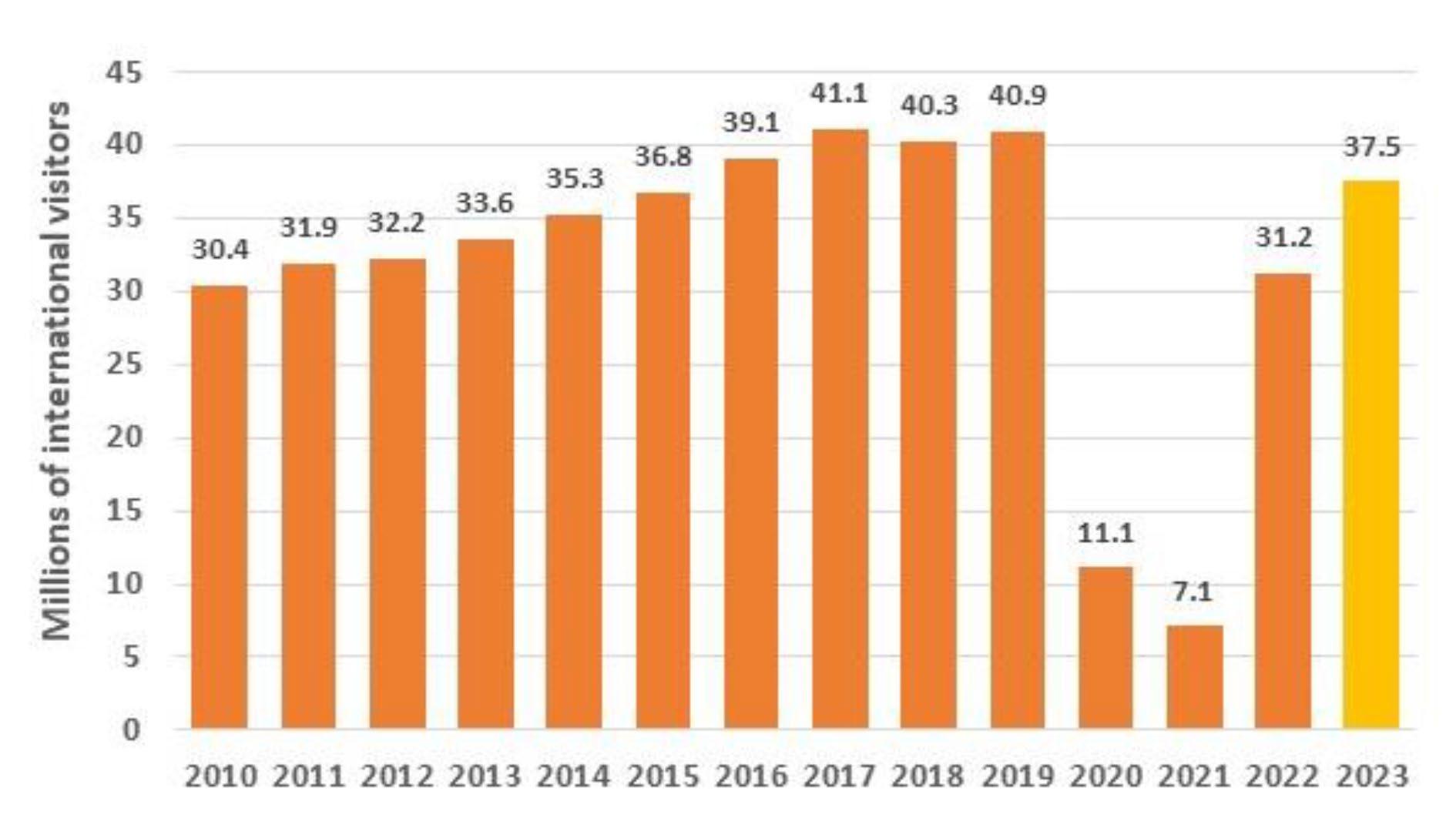
50 https://www.visitbritain.org/2022-inbound-data-0
https://www.visitbritain.org/2023-tourism-forecast 101 A DESTINATION MANAGEMENT PLAN FOR CUMBRIA: 2024 TO 2030
Figure 8.19: UK International inbound visitors
Source: International Passenger Survey from VisitBritain; Note: 2023 is a forecast
51

Cumbria Tourism, Windermere Road, Staveley, Kendal, Cumbria LA8 9PL 01539 822222 | info@cumbriatourism.org #theperfectplacetobe facebook.com/LakeDistrictCumbria @LakesCumbria @lakedistrictcumbria @lakedistrictcumbria































 Fix the Fells helicoper lifts
Fix the Fells helicoper lifts






 Table 4.4: OBJECTIVE – ENSURE CAPACITY TO DELIVER BY SUPPORTING THE SECTOR
32 Source: Cumbria Digital Infrastructure Strategy 2020-2025, 2022-2023 Update
Whinlatter Forest
Table 4.4: OBJECTIVE – ENSURE CAPACITY TO DELIVER BY SUPPORTING THE SECTOR
32 Source: Cumbria Digital Infrastructure Strategy 2020-2025, 2022-2023 Update
Whinlatter Forest










 Figure 8.1: Tourism spend per resident, 2022
Source: CWE analysis comparing total tourism spend to total GVA
Bluebird K7, The Ruskin Museum
Figure 8.1: Tourism spend per resident, 2022
Source: CWE analysis comparing total tourism spend to total GVA
Bluebird K7, The Ruskin Museum


 Figure 8.3: Total visitors to Cumbria, 2011 to 2022
Source: CT STEAM data
Figure 8.4: Total direct visitor spend in Cumbria 2011 to 2022
Figure 8.3: Total visitors to Cumbria, 2011 to 2022
Source: CT STEAM data
Figure 8.4: Total direct visitor spend in Cumbria 2011 to 2022

 Figure 8.5: Serviced Accommodation Visitors
Source: CT STEAM data
Figure 8.6: Non-Serviced Accommodation Visitors
Figure 8.5: Serviced Accommodation Visitors
Source: CT STEAM data
Figure 8.6: Non-Serviced Accommodation Visitors
 Figure 8.7: Origins of UK staying visitors in Cumbria, 2022
Figure 8.7: Origins of UK staying visitors in Cumbria, 2022







 Figure 8.13: Reasons for visiting Cumbria in 2022
Source: Cumbria Visitor Survey, 2022
Figure 8.13: Reasons for visiting Cumbria in 2022
Source: Cumbria Visitor Survey, 2022

 Figure 8.14: Occupancy rates by month, all accommodation, 2019
Source: CT STEAM data
Figure 8.15: Tourism spend per month, 2022
Figure 8.14: Occupancy rates by month, all accommodation, 2019
Source: CT STEAM data
Figure 8.15: Tourism spend per month, 2022
 Shepherd Huts at Another Place
Shepherd Huts at Another Place


 Figure 8.18: Mobile outdoor 4G coverage
Figure 8.18: Mobile outdoor 4G coverage

 42 Heart of the Lakes Active Travel Infrastructure Strategy, 2022 – 2037, January 2023.
Avanti West Coast, Docker Viaduct near Lambrigg
42 Heart of the Lakes Active Travel Infrastructure Strategy, 2022 – 2037, January 2023.
Avanti West Coast, Docker Viaduct near Lambrigg

